




Alexander Rhodes Chairman, Tusk Trust






Alexander Rhodes Chairman, Tusk Trust
I'm delighted to open this year's Tusk Talk by welcoming our new CEO, Nick Bubb, who takes over from our Founder Charlie Mayhew after an incredible 34 years. Joining us from Fauna & Flora International, Nick brings with him a wealth of conservation leadership experience, combined with a wonderful enthusiasm for Tusk. True to Tusk's characteristic energy, Nick has had a busy first quarter, hard at work in the Dorset office, as well as participating in our fourth Conservation Symposium (more below) and a fundraising trip to the US.
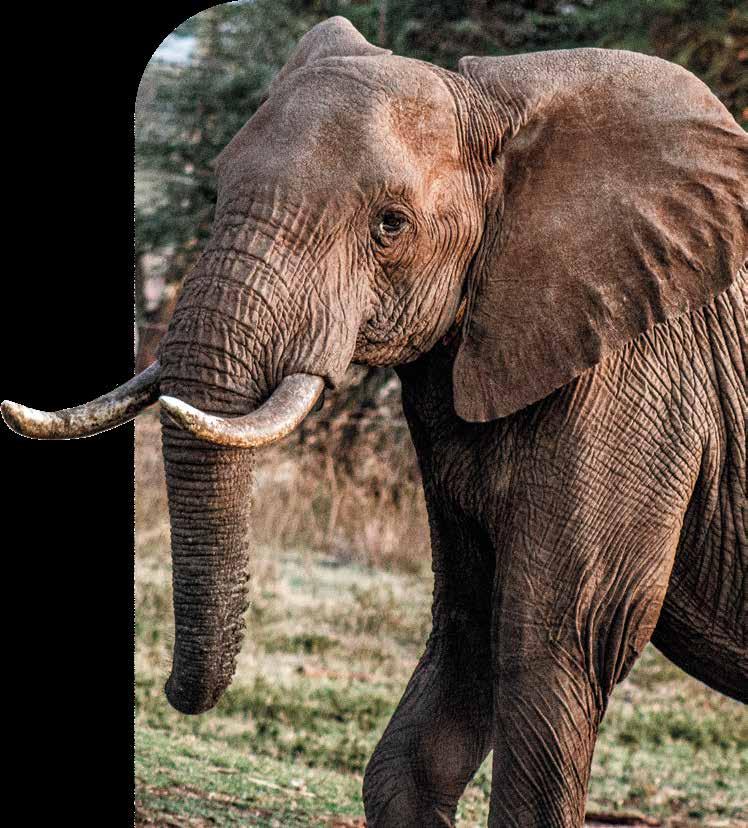
Nick's appointment is a key step in our ongoing growth and investment plan. Happily, now is not the time to write a tribute to Charlie, who, having instigated the succession process, steps into a new full-time executive role as Founder and President. This liberates him to dedicate his focus on our relationships with you, our partners and supporters, as well as new donors. As Nick explains in his introduction, we have also taken this opportunity to invest further in the team, making a series of much deserved promotions.
We've had a strong financial start to the year, with particular generosity from longstanding Tusk supporters, the guitar legend Mark Knopfler and photographer David Yarrow. On the conservation side, the highlight has been our fourth Conservation Symposium, sponsored again by the Nick Maughan Foundation and our new partners the JRS Biodiversity Foundation. The topic of the Symposium was "Evolution in African Conservation", bringing together 42 Tusk projects from 19 countries in Rwanda in early March. Coinciding with the 30year anniversary of the 1994 genocide against the Tutsi, this was a poignant time and location to convene around this topic.
Rwanda is beautiful. We were all struck by the level of development, and the bright, highly educated young people who hosted our party over six fascinating days. The meticulous agenda organised by Sarah Watson and her team allowed delegates to see first-hand the conservation achievements of the community-based work of the Rwanda Wildlife Conservation Association (a long-term Tusk project headed by Tusk Conservation Award finalist Dr Olivier Nsengimana), including at its project site in the Rugezi marshes, where it
protects this critical Ramsar Site which also feeds the capital's water supply. A meeting with the Rwandan Development Board's (RDB) leadership was a highlight for many, presenting an invaluable opportunity to hear from the government about its approach to conservation and NGOs. A day trip to Akagera National Park (est. 1934) allowed welcome time in the bush after hard hours in the conference room, but also the opportunity to see the amazing rehabilitation achieved in just 15 years under a Public Private Partnership signed in 2009 between African Parks and RDB. Notably, the lions and rhinos in the park today were translocated from South Africa and three European zoos.
It is impossible here to explain the value of the Symposium to our project partners – or to convey the camaraderie, teamwork, dancing, serious moments and a lively WhatsApp group. But the 29 proposals to the Collaboration Fund we established last year reflect a need in practitioners, alongside funding, for pan-African conservation community and shared learning and best practices. From the forests of DRC to the island of Madagascar, each of the projects we support has its individual challenges, but all face changing social, political and environmental contexts which directly impact their conservation missions. In 2024, the IMF projects that Africa will be the second-fastest growing economic region in the world at 4%. This continental headline obscures a mixed reality, not least around the Great Lakes, and a combination of opportunities and threats to those working tirelessly to protect the nature and ecosystems on which Africa – and we all – depend.
Finally, it is 10 years since the inter-governmental Elephant Protection Initiative was launched with Tusk's support. At the time, poaching threatened elephants across Africa. In May, 22 member states convene in Nairobi to celebrate largely stabilised or growing populations, and to discuss actions required to secure long-term solutions to humanelephant coexistence.
As the Tusk team looks ahead to a year filled with exciting events and opportunities to connect, I invite you to join in enthusiastically and generously. I hope to see you at the marathon, if not before!


Nick Bubb CEO, Tusk Trust
IIn his new position as Founder & President, Charlie has been incredibly supportive and I’m so pleased to report that the Tusk team have made a strong start to 2024.
As one would expect, I’ve spent most of my first few months in Tusk’s Dorset office, getting to know the core team and the day-to-day operations. In addition, I have also settled into a routine that sees me in London most weeks, as I endeavour to connect with many of Tusk’s supporters. Away from home I’ve already been fortunate enough to see a few of our projects, have spent some time fundraising in the US, and in March, joined Tusk’s Conservation Symposium in Rwanda. The opportunity to meet so many of Tusk’s partners was invaluable for me and hugely inspiring.
By the time you read this, I, and around 1,500 others, will hopefully be in the final stages of preparation to take on the famous Lewa Safari Marathon. Having heard so much about it over the years and seeing just how much effort goes in to making it happen, I can’t wait to experience it first-hand! The team are also currently working hard on preparing for the Wildlife Ranger Challenge. There’s no doubt that we’re all excited about the growth of this fantastic initiative and the potential that it has, as we continue to grow our commitment to supporting rangers in a broad variety of ways.
Against a backdrop of wonderful fundraising initiatives and impressive conservation efforts across Africa, there is no denying that the challenges for the natural world continue to grow. Tusk, and its support for our African partners, is needed more than ever. I very much hope we can rely on your continued support, as the charity deepens our investment into our conservation-implementing partners. This is the most effective tool to support communities, promote education and improve livelihoods, whilst conserving Africa’s extraordinarily rich biodiversity.
After taking time to ‘listen and learn’ while I settle into the CEO role, I want to update you all on a few changes to our management structure. I am delighted to announce that Dan Bucknell is taking on the role of ‘Chief Operating Officer’ and will continue much of the good work he’s been doing as Executive Director for the last decade but with some additional responsibilities. Sarah Watson’s role has evolved to ‘Chief Conservation Officer’ and she will continue to take the lead on our conservation strategy, as well as work to ensure the effective delivery of our conservation impact.
would like to start by emphasising what a huge honour it is to lead Tusk into this new era and to state how grateful I am to the trustees, for this amazing opportunity. Above
Providing funding mechanisms between the Global North and African conservation initiatives, will always be our core work, but there is so much more that we can do.
In line with our strategy and with further investment into our fundraising team, Adele Emmett will now have additional focus on corporate fundraising, in her new role of ‘Head of Corporate Partnerships & Events’. Lastly, Ivy Wairimu who joined Tusk in 2019, has won the respect and admiration of all those she’s worked with. I’m particularly delighted to announce that she has been promoted to the role of ‘Head of Conservation Partnerships’. She will now take the lead on a range of initiatives and perhaps most importantly, become the voice of our partners. Ivy becomes the first African national to join our senior management team and will undoubtedly blaze a trail for many others.
Looking ahead, I firmly believe it is crucial that we all continually ask, what makes Tusk so special? We are very proud of the great work that has been done over the years, but it is imperative that we continue to evolve and stand up for biodiversity under threat, even in the most difficult of circumstances.
Providing funding mechanisms between the Global North and African conservation initiatives, will always be our core work, but there is so much more that we can do. It’s essential that we help our partners increase their impact, by empowering them and challenging them to be more ambitious than ever before. Crucially, we also recognise the exponential value in collaboration and will continue to encourage all our partners to identify opportunities to work together and support them with the tools they need, to unlock their collective full potential.
We at Tusk must also continue to strive to be bolder and braver, looking for innovations and new initiatives that enable Tusk to make a difference where it matters most. I fully anticipate this to include the growth of partner support in some of the more challenging geographic areas and the organic development of our existing portfolio of coastal marine conservation partners. Lastly, I firmly believe that the wonderful PACE programme can go so much further.
I look forward to spending time with you all in the coming months and years and would like to encourage you to subscribe to our new ‘Tusk Talks’ podcast series, on either Apple Podcasts or Spotify.
African male lion Left African elephant
Once again, thank you for your crucial support of our shared mission to accelerate African driven conservation.
Tusk accelerates the impact of African-driven conservation.
We have always known that expert voices from local organisations, combined with traditional knowledge systems, are best positioned to address the threats facing their continent.
Yet in-country, community-driven organisations often remain under-recognised and lack the resources needed to grow and increase their impact.
Tusk partners with leading and emerging conservationists across Africa and secures donor funding to invest in grassroots conservation organisations with the highest impact potential. Our work continues to encourage and bolster local African leadership, increase the profile of organisations and their teams, and secure the greatest possible conservation impact.
Working towards an Africa in which biodiversity flourishes and people thrive
Almost every country on Earth has signed on to the most ambitious plan ever to protect nature: to conserve 30% of the planet's land and waters by 2030. Tusk and our extensive network of project partners are making a vital contribution towards these targets.
By 2030, Tusk aims to optimise our impact in reducing biodiversity loss and tackling the evolving threats faced by Africa’s biodiversity and linked communities. We will achieve this by convening 60+ organisations and 75 conservation leaders from across the continent, fostering and funding effective collaboration between them and accelerating the growth of community-driven conservation.
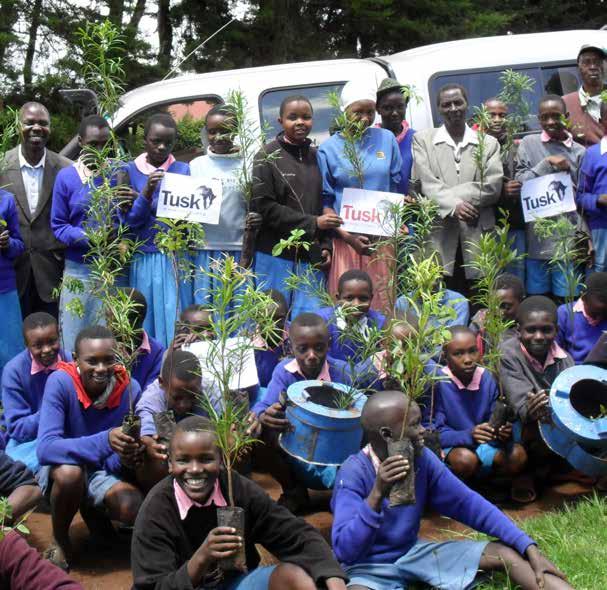


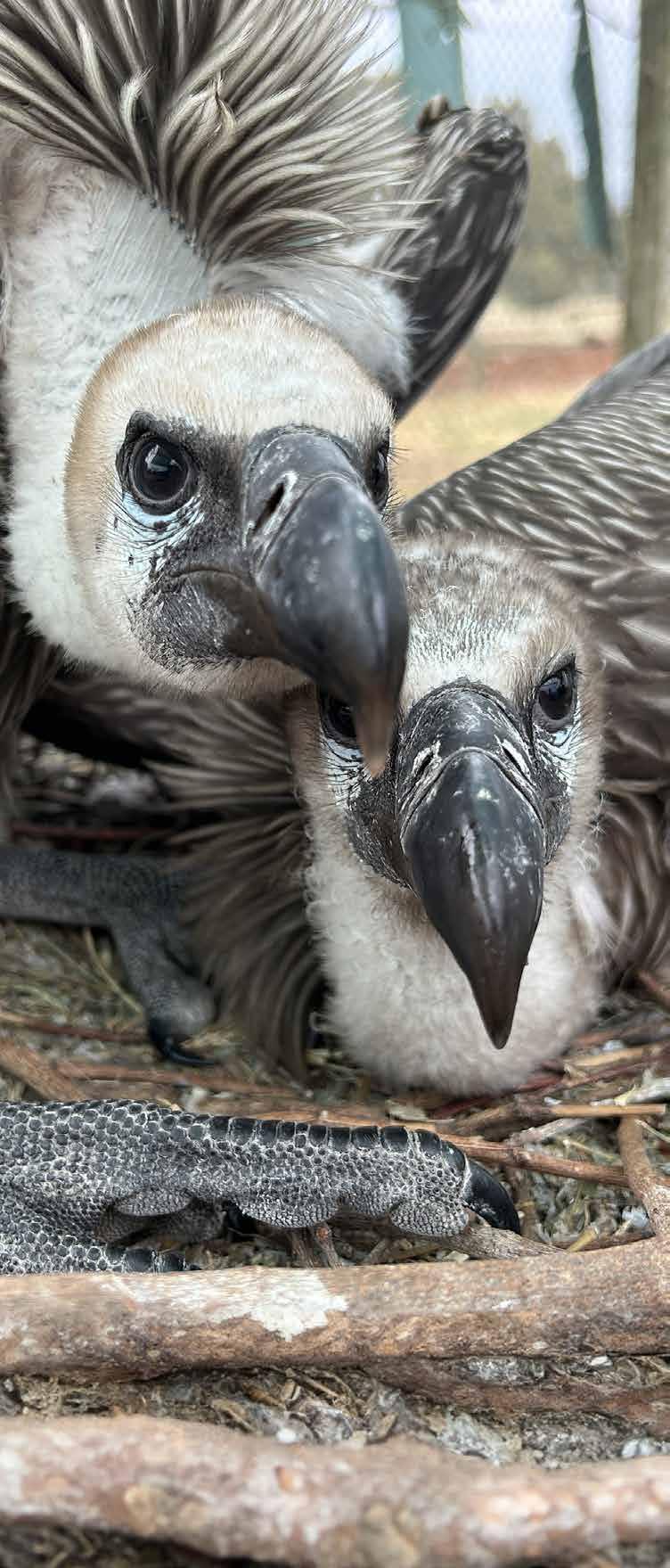
1. FUNDING: We provide critical funding to enable our project partners to grow and increase their impact on habitat and wildlife.
2. LEADERSHIP: Through the recognition and support of Tusk Conservation Award recipients (see pages 51-56), we raise the profile of African conservation leaders and their significant impacts in the field across Africa and beyond.
3. CONVENING: We bring our project partners and wider stakeholders together – through initiatives such as the Tusk Conservation Symposium (see pages 15-26) – for learning, innovation, collaboration and impact.
4. COLLABORATING: Through our new Collaboration Fund, we enable, nurture and support collaboration between our project partners, for greater synergy and impact.
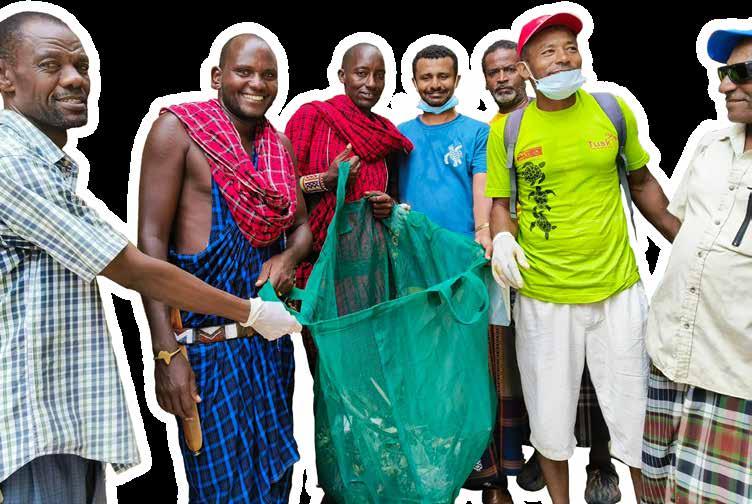
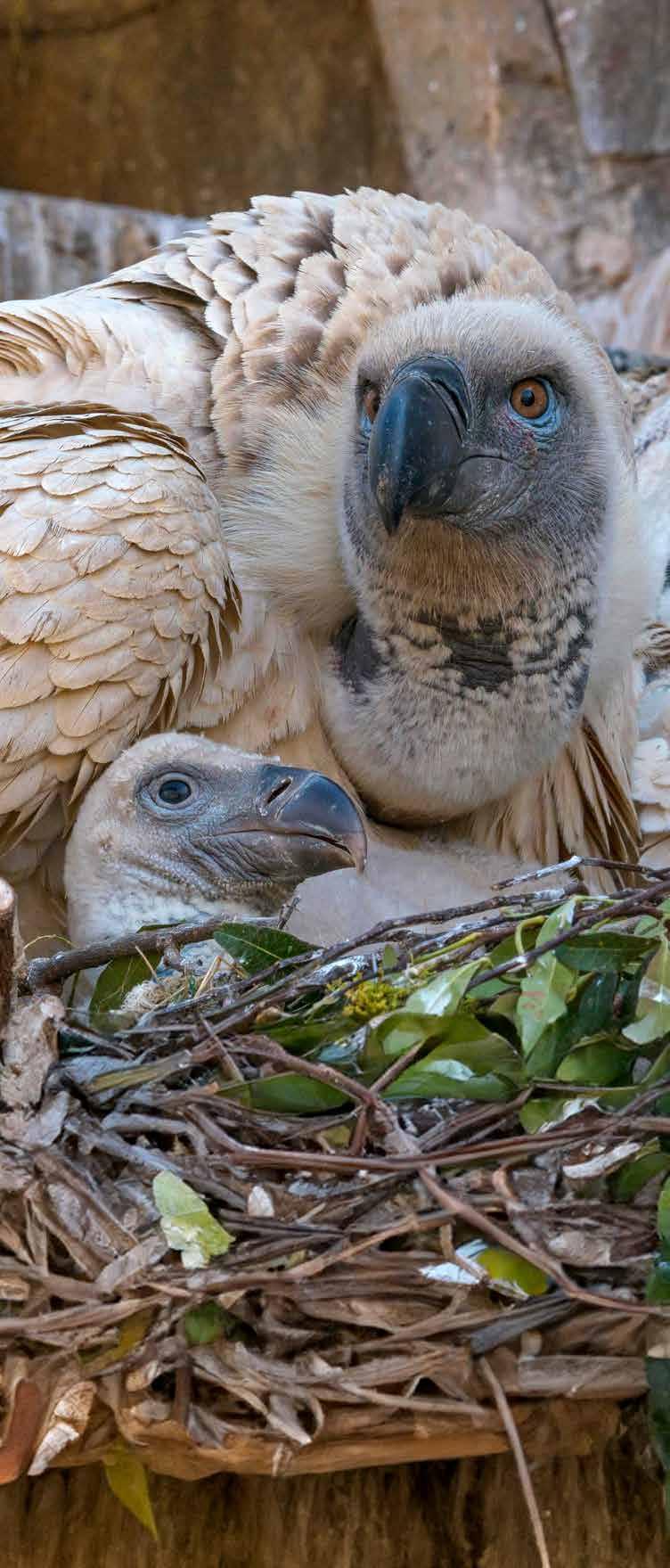
5. AMPLIFYING: We help to increase awareness, funding, and wider support for our partners’ efforts, while also sharing important conservation messages, from the vital and varied roles of wildlife rangers, to the benefits of communitydriven conservation, both within Africa and internationally.
5. ORGANISATIONAL EFFECTIVENESS: To achieve all of the above, we continue to invest in our organisational capacity and operations.
and figures
Since Tusk was founded in 1990, we have invested more than £130 million to support the growth of over 250 local partner organisations and wildlife ranger units in more than 25 African countries, enabling and empowering the conservation movement across the continent.
We direct your support towards tackling the greatest threats to Africa’s biodiversity and affected communities, helping our project partners to protect endangered species, promote human-wildlife coexistence, find sustainable solutions to maintain critical habitats, and provide engaging and impactful conservation education programmes.
We also invest in the critical role wildlife rangers play in protecting Africa’s natural resources and supporting their local communities. Through the Wildlife Ranger Challenge (see pages 41-46) and associated Ranger Fund, we are helping to improve the status and welfare of rangers across Africa, and professionalising the sector.
Your generous support last year is making a huge difference; here’s how.
£12.4 million
46 global revenue
mountain gorillas were born in Bwindi, Uganda
Every £1
donated is used across three areas:
92p - Conservation activity
5p - Support costs
3p - Cost of raising funds
*This page reflects total revenue raised in 2023 but does not reflect the total impact of the funds which have been and will continue to be disbursed in phases through 2024 and 2025.
*These figures are extracted from the unaudited 2023 accounts and do not constitute summary financial statements.
£2.4 million
provided in support of wildlife rangers
50,000,000+ hectares
secured for wildlife
22,825
adults participated in environmental education activities
55
vultures rescued and treated
invested in direct conservation activity £10.7 million
1,052
Human-wildlife conflict incidences mitigated
1,250,000
children using Tusk’s Pan African Conservation Education (PACE) materials
Focus of Tusk funded projects
Protecting endangered species 41%
Preserving and enhancing areas of natural habitats 35% Promoting human-wildlife coexistence 13% Providing environmental education 7%
awareness & publications 4%
Source
projects supported with Tusk generated funds
157,916
72 trees planted
Tusk's conservation impact is achieved by our unparalleled network of project partners, each of which has had great successes over the past year. Here is just a snapshot of those, along with our shared ambitions for the years to come.
These successes have been made possible because of your generous support, and it is your financial commitment to conservation in Africa that will enable us to continue to accelerate the impact of our project partners’ work in 2024 and beyond.
Wildlife Ranger Challenge Partner Only Both (Tusk & WRC) Project Key
Tusk Project Partner Only
Wild Entrust
CLAWS Conservancy
Northern Tuli Game
Côte d’lvoire • Wild Chimpanzee Foundation
• Friends of Bonobo • Okapi Conservation Project • Dian Fossey Gorilla Fund
Gabon • OELO Gabon
Gambia
• Red Colobus Conservation
9 Ghana
• HERP Conservation
10 Guinea
• Chimpanzee Conservation Centre
11 Kenya
• Big Life Foundation
• Lewa Wildlife Conservancy
• Lion Landscapes
• Mount Kenya Trust
• Mountain Bongo Surveillance Project
• Ngare Ndare Forest Trust
• Northern Rangelands Trust
• SORALO
• Tsavo Trust
• Borana Conservancy
• Grevy’s Zebra Trust
• Lamu Marine Conservation Project
• Maa Trust
• Milgis Trust
• Pangolin Project
12 Madagascar
• IMPACT Madagascar
• C3 Madagascar
• Madagasikara Voakajy
13 Malawi
• Wildlife Action Group
• Lilongwe Wildlife Trust
14 Mali
• Mali Elephant Project
15 Mozambique
• Maputo National Park
• Luwire Wildlife Conservancy
• Zambeze Delta Safaris
16 Namibia
• Save the Rhino Trust
• Integrated Rural Development and Nature Conservation
• ORKCA Namibia
17 Nigeria
• African Nature Investors Foundation
• Yankari Game Reserve
• SW/Niger Delta Forest Project
18 Rwanda
• Rwanda Wildlife Conservation Association
19 South Africa
• Southern African Wildlife College
• Bateleurs
• VulPro
• Project Rhino
• Transfrontier Africa
• Wildlife ACT Fund Trust
20 Tanzania
• Africa Foundation
• Honeyguide Foundation
• Lion Landscapes
• African People & Wildlife
21 Uganda
• Conservation Through Public Health
• Uganda Conservation Foundation
22 Zambia
• Conservation Lower Zambezi
• Conservation South Luangwa
• Zambian Carnivore Programme
• Game Rangers International
• Musekese Conservation
• North Luangwa Conservation Programme
• Nsumbu Tanganyika Conservation Programme
23 Zimbabwe
• Malilangwe Trust
• Painted Dog Conservation
• Bhejane Trust
• Wildlife Conservation Action
• Conservation and Wildlife Fund
• Savé Valley Conservancy
• Tashinga Initiative
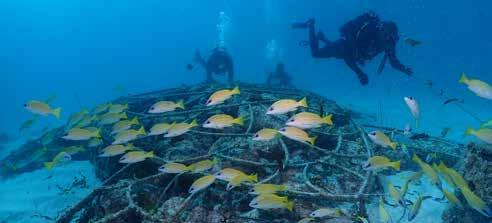
With the support of Tusk, Africa Foundation was able to establish a magnificent artificial reef structure of six turtle and star-shaped constructs, which have been populated with 1,580 coral colonies. All of these coral colonies were “home-grown” by the Community and Conservation Ranger team, in a flourishing coral nursery that was established at Mnemba Island House Reef, Zanzibar. As well as developing the alternative artificial reef site, over 7,000 coral colonies from this nursery are regenerating degraded local reef sections elsewhere. Over the next year they look forward to expanding the artificial reef site to further secure the future of the House Reef.
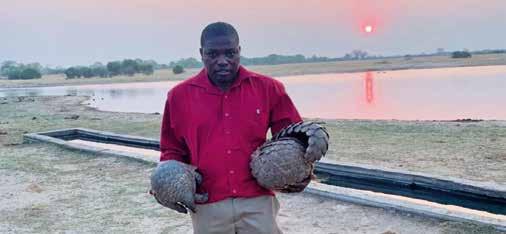
Credit: Bhejane Trust
Bhejane Trust, Zimbabwe
Pictured is Tusk Wildlife Ranger Award 2020 winner Amos Gwema, holding two Temminck’s ground pangolins at Hwange National Park, which are being released back into the wild. The pangolins were rescued and handed in by community members, something that is unlikely to have happened had it not been for the Bhejane Trust’s community awareness campaigns. These are now paying dividends, with a change in community mindset towards protecting wildlife. Amos is also engaging 11,000 schoolchildren through Tusk’s PACE project, and is enlisting the help of 15 former poachers as community conservation champions.
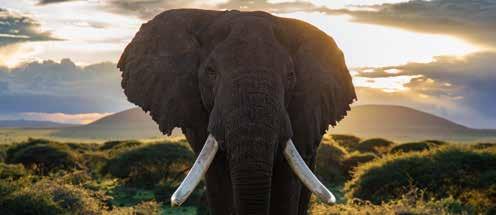
The Amboseli landscape is being divided up into tiny plots in a process called subdivision. This could spell the end for this ecosystem’s globally recognised wildlife, including elephants like Spirit (pictured). However, through their partnership with the local communities, Big Life’s key success over the past year has been to create land-use plans that leave space for wildlife in the form of corridors, conservancies, and dispersal areas. The outcomes have been extremely positive: they have already signed leases of over 80,000 acres. Over the coming year, they aim to double the land under lease agreements, while developing more conservancies.

Last year marked a significant milestone for CSL, as they celebrated two decades of work in and around South Luangwa National Park. Highlights from the year included further expansion of their humanwildlife conflict Rapid Response Unit (the first of its kind in Zambia), and for the first time, partner cooperatives processed conflict-free turmeric, chilli and lemongrass for local sale. CSL also welcomed 16 scouts to the team and two dogs to the K9 unit, the 10th anniversary of which will be celebrated in 2024. The team were also delighted that CSL’s Atsikana team won the women’s Wildlife Ranger Challenge!
In 2023, Lewa’s commitment to conservation and community welfare yielded significant success. Growth in the rhino population led to the translocation of 12 eastern black rhinos to Loisaba Conservancy, marking a triumphant return following poaching in the 1970’s. Endangered species like Grevy’s zebra and pancake tortoises saw population increases, thanks to effective conservation strategies. Lewa also reclaimed 50 hectares from invasive species and established 1,305 acres of ecological recovery zones.
Collaborations led to planting 38,000 trees and completing the Kithima-KiaMugumo water project, bringing the total to 18 water projects. In addition, the Lewa Digital Literacy Programme successfully digitised a total of 497 topics, benefiting 8,623 eager learners and empowering 183 teachers.
In July 2023, a group of 22 men became Malilangwe Scouts after six months’ intensive training. Pushing themselves beyond what they believed they were capable of, they became proficient in wildlife protection and biological monitoring. With additional boots on the ground, Malilangwe have escalated coverage of daily patrols on the reserve.
In 2024, Malilangwe celebrates its 30th anniversary of conservation and community initiatives. They also look forward to welcoming two new members of their very first K9 unit. The dogs’ detection skills will enhance Malilangwe’s anti-poaching efforts.
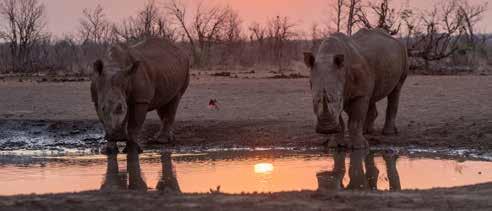
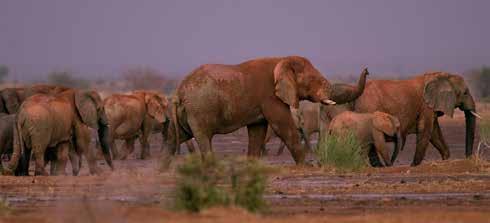
On 5th June 2023, 96 young volunteer community “eco-guards” conducted a ground count of the Gourma elephant population, providing an updated estimate of at least 316. This is doubly encouraging, as it suggests the population as a whole has fared better than anticipated, despite poaching and insecurity, while demonstrating that true participatory monitoring adapted to the local context is feasible, and can provide good and useful data. The project is now working with the government to professionalise the eco-guard role to provide as many youths as possible with a stable and respected occupation.

The Chimpanzee Conservation Centre (CCC) is a rescue and rehabilitation site for orphaned chimpanzees. Following their release in 2008 and 2010, the released females have given birth to 16 offspring in the wild. In the initial years, infant mortality rates were high, but CCC are pleased to report that for the past decade or so, infant mortality has significantly decreased. The survival rate is now 44%, closely mirroring the infant survival rate of those born to wild mothers. Two of the females born in the wild, Leila and Aniouma, are likely to change groups soon, as they are reaching puberty, with hopes for a second generation to be born in the wild.
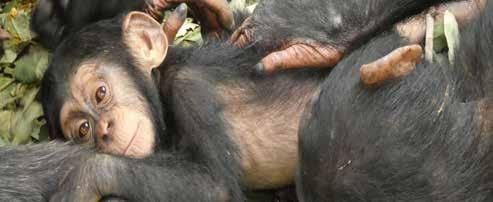
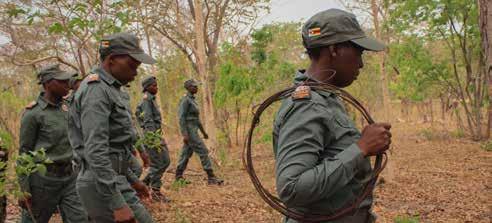
Last year, PDC recorded a 25-year population high of 250 painted dogs. For the first time ever, they saw three to five packs of painted dogs utilising the buffer zone in their core operating area. Over the year they expanded their anti-poaching units, adding 8 scouts and creating an all-female team called Vusile led by Belinda Ncube, a graduate of their Iganyana Children's Bush Camp.
As well as increasing their protection and anti-poaching efforts in 2024, PDC will embark on rewilding the buffer zone, beginning with the introduction of 200 impala.
Tusk has supported VulPro since their inception in 2007, reinforcing their commitment to prevent vulture extinctions. Tasked with conserving 11 African (9 Southern African) vulture species, the challenges are immense due to their wide foraging behaviours across countries. The 2013 launch of their captive breeding programme marked a milestone, expanding into the first-ever African vulture supplementation initiative. In January 2024, VulPro achieved another milestone in collaboration with Shamwari Private Game Reserve, with the largest ever vulture relocation, heralding VulPro@ Shamwari. This expansion addresses pressing security challenges and growing risks, making it a pivotal moment for sustained conservation efforts.
Last year, with Tusk’s support, Tsavo Trust has maintained its field security and monitoring support to the Kenya Wildlife Service (KWS). Over 410 arrests were made by their field teams, and only two elephants were confirmed poached; a 40% reduction from 2022. They have also enhanced their support to the Kamungi Conservancy bordering the Park, with membership growing from 145 households to 385. Together with KWS, their focus is now on securing funds to increase the protection of the Tsavo West National Park’s Intensive Protection Zone for Black Rhino, with the potential to hold over 1,000 individuals: 10% of the world’s population.


As part of IMPACT Madagascar’s landscape management of the remaining, threatened dry gallery forests of Madagascar’s central highlands, they have reforested more than 70 hectares of degraded forest with native tree species. They have supported more than 2,200 livelihoods, and are now working to establish community ecosystem management and livelihood support for Ambohijanahary and Kasijy Special Reserves. Elsewhere, they discovered and began protecting more populations of the critically endangered damba cichlid-fish and the Madagascar big-headed turtle.

Together with community conservancies and landowners within the Nyekweri Ecosystem, the Pangolin Project has been mitigating risks to giant ground pangolin, such as electric fencing below 65cm that can trap and kill them when passing underneath. So far, 22km of perimeter fencing has been removed (c. 30% of all wire in the area), and they are introducing pangolin friendly fences. They are also halting deforestation and increasing levels of protection to secure vital, viable habitat for the pangolins and other unique biodiversity.
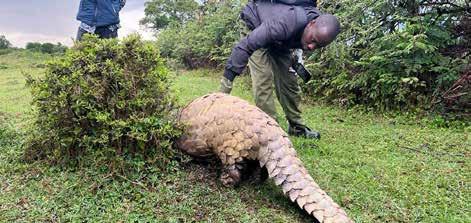
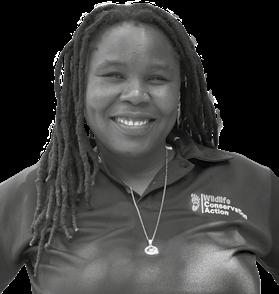
Igrew up in a small town in Chiredzi in Zimbabwe's Lowveld. I had no connection to wildlife except at school, and maybe in stories, and I had not seen wildlife until I went to university to study applied environmental science.
How did you find your way into conservation?
It was my Tropical Resource Ecology Master's degree that sparked my interest in wildlife, and I wanted to learn more, and do more through wildlife conservation, and I was about 24 years old at the time. Sometimes when I look back and reflect, I always wish that I’d had an opportunity to see and connect with wildlife at a younger age.
As a conservation biologist working at the intersection of conservation and community development, how would you define effective community conservation?
One of the challenges we have now, I think, is that most of what we say is community conservation is only community conservation on paper, but in practice, it's not happening. Communities have to lead conservation efforts for effective community conservation. And this starts with involving the communities from the beginning
The
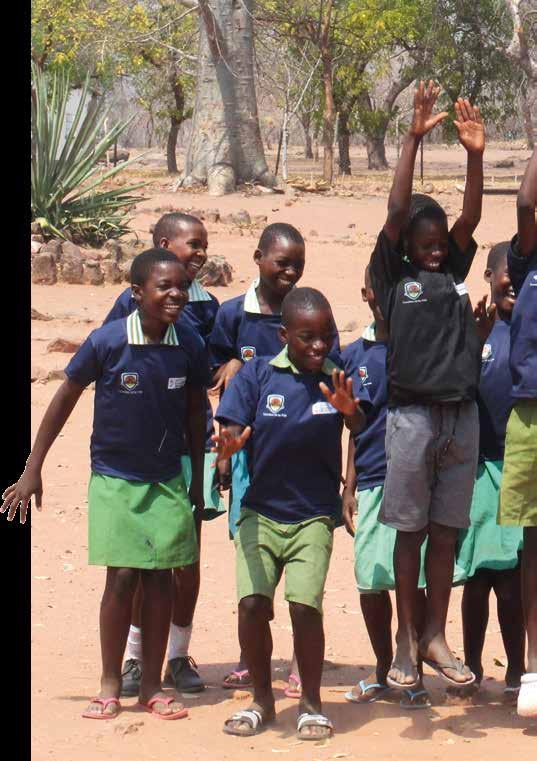
of the project, from coming up with the idea about the project, to the implementation and the monitoring and evaluation of the project; throughout the project cycle.
We make an assumption as an NGO – as an international NGO, or even local NGOs – that the communities do not know how to do certain things, or how to do conservation. But if we take time to consult with the communities and get ideas from them about how certain things can be done, or how a problem that they are facing can be solved, then we can get brilliant ideas, and we can be effective in our community conservation. Because if you look closely, these communities already have solutions to most of the challenges that they are facing. And as NGOs and local organisations, what we can bring is resources, and we can also help strengthen their capacity.

This interview is based on edited excerpts from a Tusk Talks podcast. To listen to the full podcast, search Tusk Talks on Spotify, Apple Podcasts, Amazon Music, or your preferred platform.
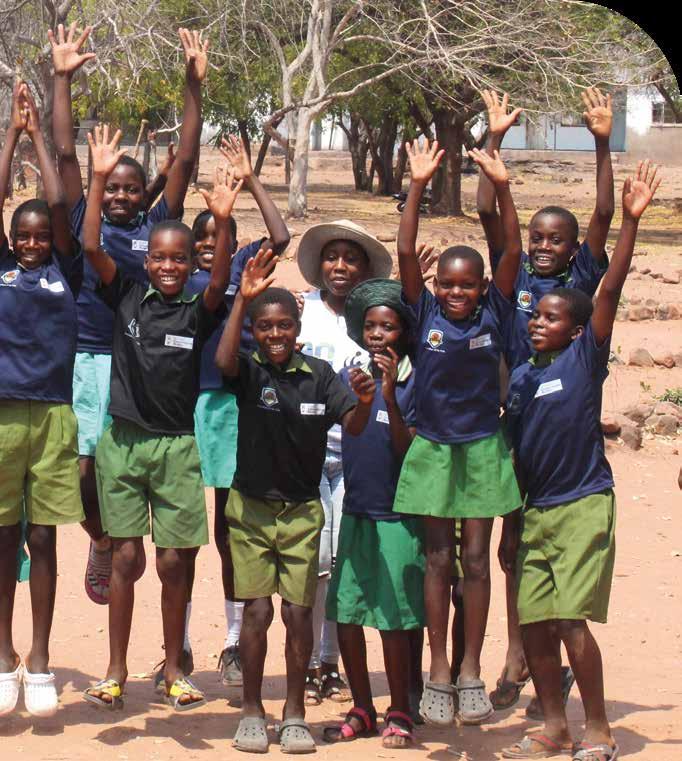
Do you have any advice for any aspiring conservationists around the world?
One of the questions that I often get asked, is have you ever thought of giving up? And my answer is yes, many times I have thought of giving up. As a young black African woman, starting my own organisation in the conservation sector was such a huge undertaking. I did not have any resources. I did not have any money to help me get started. And the journey has not been easy. But I have not given up.
And so one thing that I would tell any aspiring conservationist is do not give up. It might be difficult to begin with, but if you are really passionate about conservation, if you really want to make a difference, if you really want to be the change that you want to see, then you should not give up. And one thing that I'm also grateful about is the support that I've received throughout my career from various people. That has also helped me. I've had mentors and people that I looked up to that inspired me to keep going and to do better. And I think as an aspiring conservationist, you should look out for those people, and learn from them.
The beauty about conservation is that anyone can do it. Anyone can be a conservationist. It doesn't matter if you went to university and did mechanical engineering, or statistics, or other studies, you can use your skills for conservation. If you're passionate about conservation and you studied another degree, you can still come back and do conservation.

Convening for collaboration

Since the inaugural event held in Cape Town in 2017, the Tusk Conservation Symposium has become one of the charity’s core initiatives, allowing us to fulfil one of our five goals of enabling, nurturing and supporting greater collaboration between our portfolio partners, for greater synergy and impact.
The previous three symposia focused on collaboration, sharing success and building resilience. While these three goals remain the underlying purpose of the Tusk Conservation Symposium, the main focus for the fourth symposium was on “Evolution in African Conservation” Under that theme, the symposium was designed to answer two key questions: what is the future of African conservation, and how can we leverage the power of the Tusk portfolio to ensure conservation is sustainably funded, equitable and truly community-driven? Workshops focused on several key topics, including community-driven conservation, wildlife conservation economies, fundraising and succession planning.
Thank you for all the effort in organising the symposium, for the great coordination. I feel incredibly grateful, inspired and encouraged.
Mercy Waithira, SORALO
Main image
2024 Symposium delegates gather in Akagera National Park
Right
Images from the 2024 Tusk Conservation Symposium
To debate these issues, 47 representatives from 42 Tusk-supported projects across 19 African countries joined together in Rwanda.
The symposium began with a visit to the Rwanda Genocide Museum. While so hard to see and comprehend, Rwanda’s story of resilience, rebuilding and evolution can also be inspiring, and helped set the tone for the week, by showing how much can be achieved against the most difficult of odds.
We were honoured to be hosted by the Rwanda Wildlife Conservation Association and to have the opportunity to visit their “Umusambi Village” within Kigali, and their work at Rugezi Marsh. We also enjoyed a visit to Akagera National Park and a presentation by African Parks, who have managed the Park since 2010.
We are incredibly grateful to all our partners who took the time to join us in Rwanda for this symposium and made it such a success, and we are hugely indebted to The Nick Maughan Foundation, our lead sponsor, whose generosity once again made the entire event possible. We would also like to thank JRS Biodiversity Foundation for their generous co-sponsorship, and Mantis for kindly hosting us for the second half of the symposium.
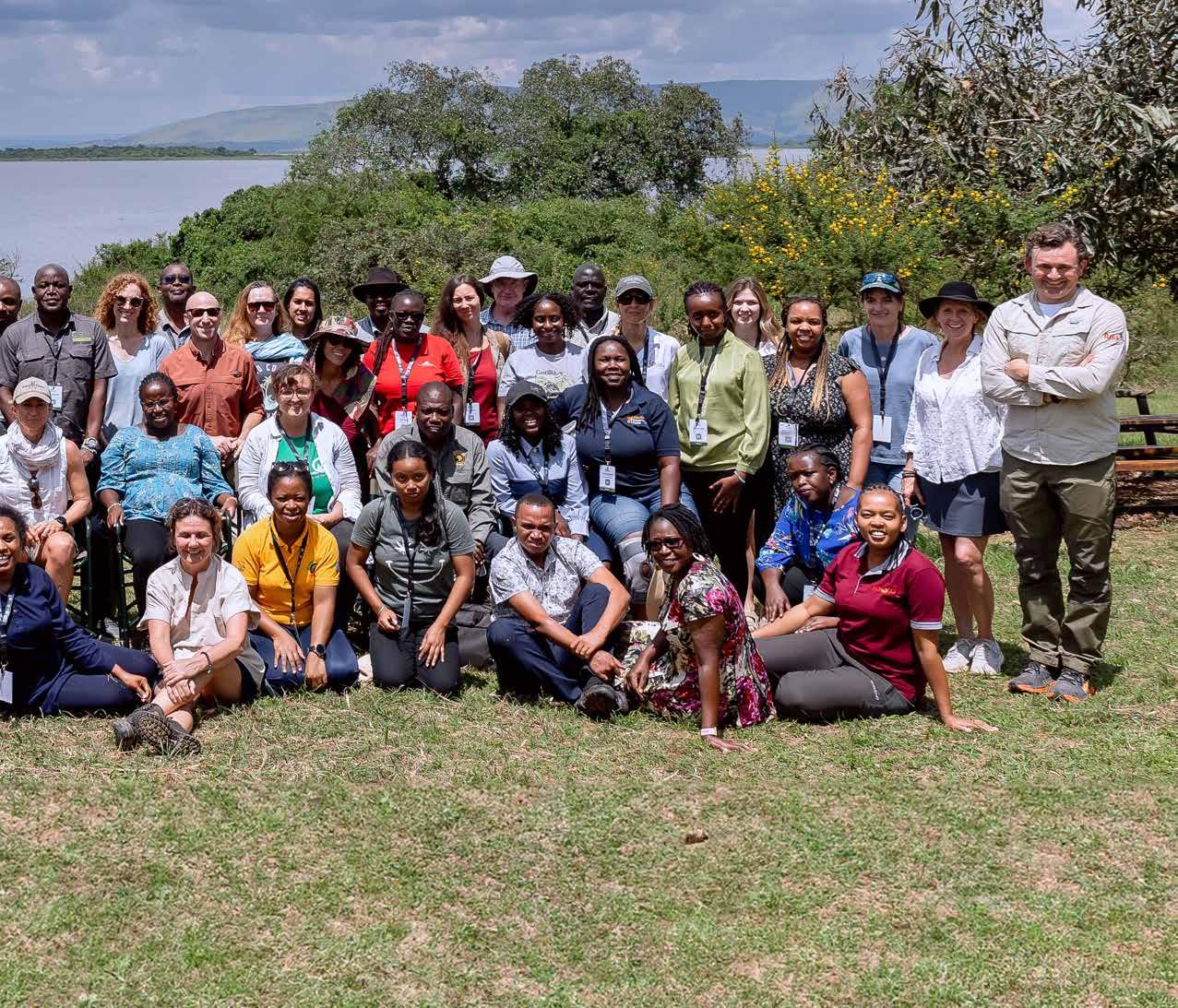
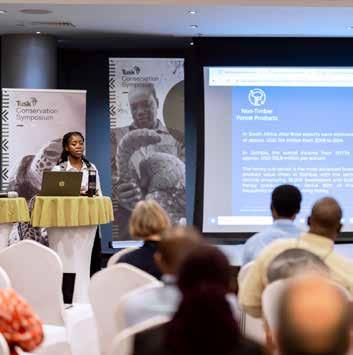
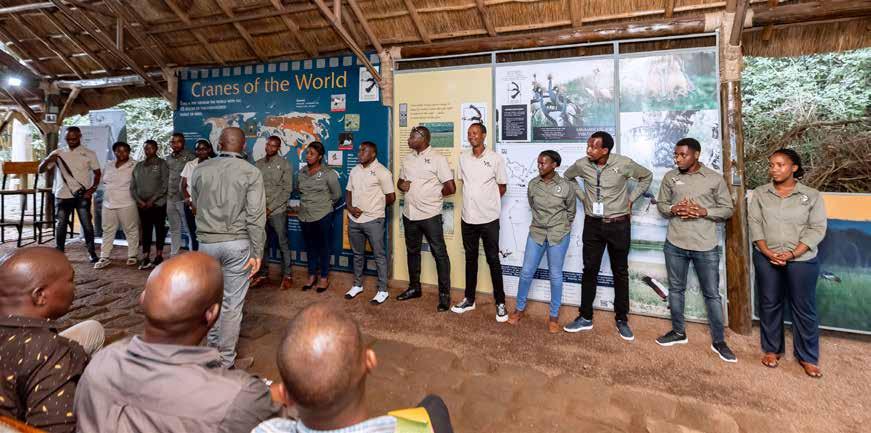
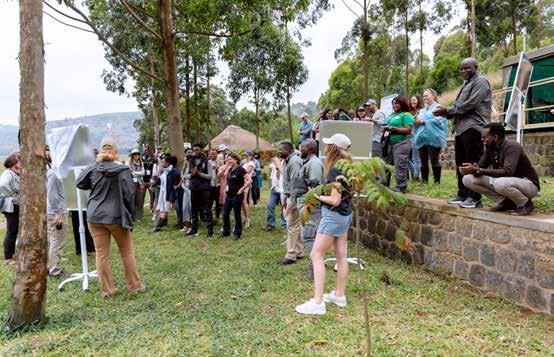




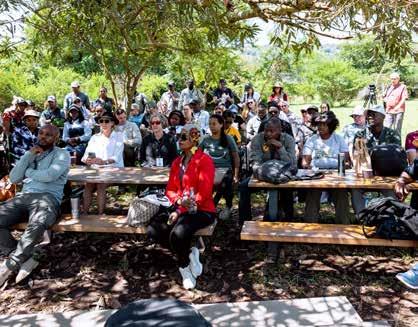

The thing I’ve enjoyed the most is the interactive group discussions; as the word says it’s very interactive! And there's a lot of potential for networking as one, as well as a lot of key learnings from the informal way in which we are conducting the exercises. So, it's very on the spot. You have to think on your feet, which is quite refreshing from having to sit down and deliberate over questions and solutions. It's really good to trust your intuition and communicate it properly.
Derek Lubangakene Uganda Conservation Foundation

It's been a privilege to be amongst accomplished men and women in direct species protection, community engagement and alternative livelihood programmes. The session on wildlife economics opened my eyes to the possibilities out there, how committees can effectively and efficiently organise themselves into business and harness the opportunities around them, and how we as the NGO have a role to play to facilitate these initiatives.
David Kuvawoga Painted Dog Conservation

The Tusk Symposium is always just a collaboration boiling pot for the wildlife college, where we really realise how we can assist different institutions with training plans and capacity development. And the organisations assist the college in really staying abreast of the challenges to conservation organisations. So, we are definitely looking forward to collaborating with many new partners, and taking other collaborations that we have started a few years ago to the next level.
Theresa Sowry
Southern African Wildlife College
To encourage ongoing collaboration beyond the symposium, Tusk has established the Collaboration Fund to fund exchange visits, as well as to support collaborative ventures that may develop from them.
Following the 2024 Symposium, we have supported eight exchange visits and fifteen collaborative initiatives. We look forward to reporting on the outcomes from these in the future.
The following pages outline some of the exchange visits that have taken place and collaborations that have developed over the past year. These were presented at the Symposium, inspiring a number of the further collaborations that we have since funded.
Lion Landscapes and the Zambian Carnivore Programme (ZCP) are both field based organisations protecting large carnivores and their habitats, across Kenya, Tanzania and Zambia. Much of their work is based on data collection and conservation science, working with communities to develop actions for coexistence and to strengthen local leadership for innovative conservation solutions. Both are very similar organisations with project sites covering large expanses, and the countries (Zambia and Tanzania) where they work are similar in culture, government infrastructure and conservation efforts and needs.
Lion Landscapes needed support with their long-term monitoring strategies, which ZCP could help inform from their extensive experience of ecological monitoring and large carnivore monitoring. ZCP meanwhile needed support with establishing strategic, longterm human-wildlife conflict mitigation initiatives; a great strength of Lion Landscapes.
With funding from Tusk, a shared learning and exchange programme has been established through a joint MoU. This has included a field exchange visit from Lion Landscapes to ZCP’s work in Zambia’s South Luangwa ecosystem, which allowed for indepth, shared learning and collaboration around large carnivore protection, including lion and wild dog collaring. A lead ecologist from the Tanzanian government – a key partner of Lion Landscapes – was also able to join the exchange visit and benefit from the in-situ training opportunities it presented, extending the multi-stakeholder collaboration that’s so important for conservation across large landscapes.
Observing how the ZCP team uses GPS and VHF technology to pinpoint the animals' whereabouts and to track their movements emphasised the need for greater innovation and the integration of technology into Lion Landscape’s own research activities. Lion Landscapes also witnessed the importance of genetic research in understanding the populations and health of the animals they work with.
One year on from the field exchange the teams will be looking to assess and document the outcomes of their collaboration.

The knowledge exchange and collaboration between our organisations left a lasting impression on me. The significance of learning from each other's experiences and the potential for mutual growth was evident throughout our interactions with the ZCP team.
This reinforced the importance of collaboration and the power of shared knowledge in the pursuit of our common goals. But also, this connected me with new people in the conservation industry, who are now friends.
Joseph Francis, Research Manager, Lion Landscapes
Lewa Wildlife Conservancy (Kenya) & PACE (Africa-wide)
Tusk’s Pan African Conservation Education (PACE) project was launched in 2004, inspired by sharing the success of the Rugusu Springs community water project on the outskirts of Kenya’s Lewa Wildlife Conservancy as a case study.
Tusk has been a partner of the Lewa Wildlife Conservancy since its inception in 1995, and a long-time supporter of their education programme. The Lewa team had been equipping their 23 schools with tablets and smartboards, but they needed extra content for the teachers and schoolchildren to use them. PACE meanwhile needed support exploring effective digital routes for providing its material.
And so it was that PACE started working with Lewa’s Digital Literacy Programme in 2020. Two years ago, PACE resources were added to Lewa's digital school learning platform. The Lewa team created a PACE channel on the Kolibri software used on the school ‘intranet’. Making all PACE content directly accessible in the classrooms means that teachers and students have a pool of rich environment and conservation content that they are integrating into school teaching and learning. More than 94% of PACE content links directly to the Kenyan school curriculum. The practical nature of PACE content has been hugely appreciated for the project based teaching required of Kenyan schools: new school gardens and vegetable plots are blossoming. Lewa’s community development team have noted the extent to which techniques from PACE are spreading from the schools and already being used in communities and on people’s farms. The PACE channel has been shared and is freely available to other Kolibri users.
This collaboration has supported more than 10,000 schoolchildren’s digital literacy, as well as promoting practical learning and increasing their output. It has provided new case studies and content for the ongoing development of PACE materials. Meanwhile, last year the Lewa team trained educators in their local area and the wider region, including on Lamu Island with Tusk partner LaMCoT.
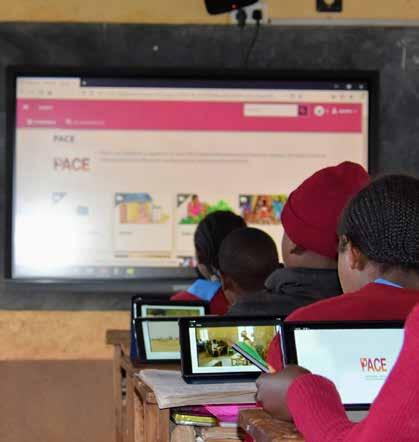
Left
PACE digital content being used in Lewa’s Education Programme
Credit: Lewa Wildlife Conservancy
Right
Top: Africa Foundation coral monitoring
Bottom: Southern African Wildlife College and Africa Foundation collaboration
Far right
Madagasikara Voakajy
& Save the Rhino Trust
presenting at the 2024 Tusk Symposium, and during the exchange visit
At the 2022 Tusk Conservation Symposium, Africa Foundation - Oceans Without Borders (OWB) approached Southern African Wildlife College (SAWC) for their support in developing an action plan for achieving their strategic goals. The activity was focussed on OWB’s work on Benguerra Island in the Bazaruto Archipelago off southern Mozambique, as well as for Vamizi Island off northern Mozambique and Mnemba Island off Zanzibar. Across all sites, OWB hire 13 community conservation rangers who conduct critical coral, habitat and turtle monitoring, for which they need to be able to scuba dive and be competent at data collection.
After an initial exchange visit supported by Tusk, SAWC began by breaking down OWB’s objectives and the activities required to meet them, and then looked at the competencies required for those activities, mapping them to individuals responsible. Rather than looking at job descriptions and individuals’ roles, the outcome was to develop a Conceptual Competency-Based Framework and an accompanying training programme to plug any gaps identified.
OWB can now recruit according to the competencies required and not the job description. An unintended consequence of the collaboration is that SAWC have now created a framework that could be used by (and which they’re happy to share with) others.
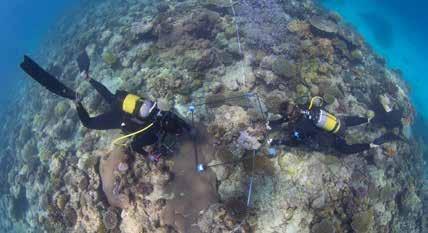

Julie Razafimanahaka, the Director of Madagasikara Voakajy, and Simson Uri-Khob, Save the Rhino Trust’s Executive Director, met in London at the 2021 Tusk Conservation Awards, as winners of the Tusk Award for Conservation in Africa and the Prince William Award for Conservation in Africa respectively. It was from such encounters and the sharing of ideas and experiences that first inspired the Tusk Conservation Symposium. On this occasion it led to Julie visiting Save the Rhino Trust (SRT) in Namibia in 2023, supported by Tusk’s Collaboration Fund, to learn how conservancies work in Namibia, as well as how SRT manages relationships with businesses in ecotourism. They were joined by members of the Umoja Wildlife Conservancies Association from Uganda, who were also eager to learn more about the conservancy model developed in Namibia, presenting the opportunity to compare notes between Namibia, Madagascar and Uganda.
Together they visited a number of SRT’s field sites in the Khorixas area. Activities included: staying at one of the lodges collaborating with SRT; tracking rhinos and talking with rangers from Torra Conservancy; talking with members of the Khoadi Hôas Conservancy and visiting the Grootberg Lodge; and a visit to the Skeleton Coast National Park.
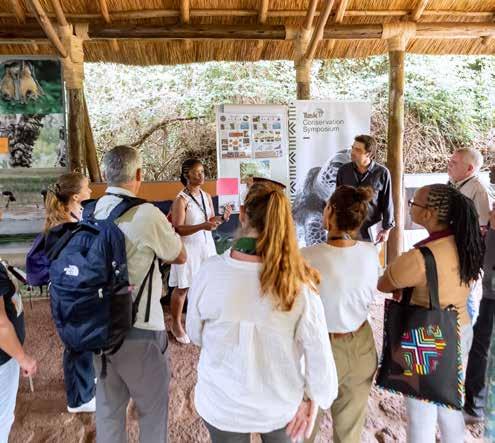
Three key lessons that are being taken from Namibia to Madagascar are:
1. Conserving remaining biodiversity and restoring degraded habitats takes time, trust and resources. A former leader of the Khoadi Hôas Conservancy said that it took them 30 years to get most of the community to align with the conservancy objectives. There were times of doubts and questions that they discussed with all stakeholders. The Madagasikara Voakajy team are usually in the field for specific project activities, but will now pay attention to the worries and issues expressed by the community members, and take the relevant action to build trust.
2. Ecotourism can be an excellent precursor to conservation and community engagement if all well planned and managed, but this too requires time and trust, as well as resources from all stakeholders. The most successful example is that of Grootberg Lodge where the manager is from the local community. The company and the community invested in training community members to be able to take on the jobs and responsibilities within the lodge.
3. The conservancy model has been designed based on the experiences in Namibia. Even the word ‘conservancy’ has been created with the local communities who were then involved in its design. Since then, the processes have been documented and shared widely, for example on posters in the conservancy offices. The fact that Namibia collects consistent data from all conservancies into a single database, and periodically analyses it is also very powerful. Such data are very important when discussing with decision makers from other sectors, who might have other priorities. Madagasikara Voakajy currently works with 32 communities, but do not have such consistent data. This is one of the things they are looking to change this year, as well as spreading the idea of having a national database on community-based conservation.
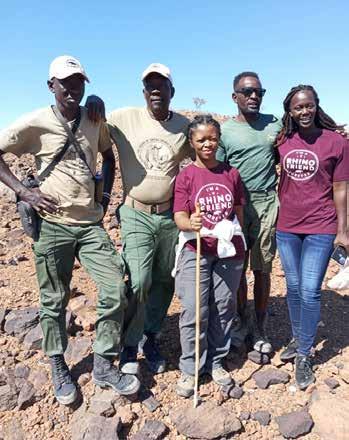

The following is a summary of one of the workshops from the 2024 Tusk Conservation Symposium, with a particular focus on succession planning, as facilitated by Maliasili Initiatives
Since inception, Tusk has championed communitydriven conservation and a partnership model. We have always known that local people and organisations are best positioned to address the threats facing their continent. Yet grassroots, communitydriven organisations often remain underrecognised and lack the resources needed to catalyse their growth.
Tusk partners with leading and emerging conservationists across Africa and invests in grassroots conservation organisations with the highest impact potential. Our work encourages and empowers local African leadership, increases the profile of organisations and their personnel, and maximises conservation effect. Many of our partner organisations are in the early stages of their organisational growth, and our support can help them towards the next stage of their development.
There are generally four stages in an organisation’s growth and development. The initial start-up phase typically involves a small team with little need for organisational processes, structures and systems. As an organisation attracts more interest and funding, and as its team begins to grow, so it enters the second phase of managing growth, with a greater focus on team dynamics and management, and strategic questions being asked.
With a track record of impact and greater management responsibilities across the team, the third phase of accelerating growth sees a greater focus on strategy and the development of external relationships, as well as on professional development. An enduring organisation is established in the final, fourth phase, where an organisation has developed an identity beyond its founder, led by a diverse team and an effective board, and with strong and diverse partnerships and systems in place. At this final stage, the organisation’s reputation and strategy can drive fundraising efforts, and a culture of delivery and impact have been developed.
During the Tusk Symposium workshop, it became evident that a small number of Tusk’s project partners are in the first or second phase of their growth (and Tusk’s support could help move to the next phase), while the majority are at phases three or four, or are in the process of transitioning.
Ian Stevenson of Conservation Lower Zambezi explained that they are in the third phase of their growth, and still very dependent on him as the long-term head of the organisation, while acknowledging the need to move to the fourth phase. However, Ian noted that it can be a challenge to find senior staff with the right skills and experience, who also want to live in remote landscapes. CLZ’s focus is on building their organisational structure, while having to make some compromises. Ian would like to promote more staff from within the organisation, for example, but this would require further training to develop the skills required for certain senior roles.
Main image
Panel discussion on Evolution in African Conservation Organisations at the 2024 Tusk Conservation Symposium
During the workshop, Damian Bell, Founder and Executive Director of The Honeyguide Foundation, described how their process of transitioning has been underway for the past couple of years, with him steadily handing over to the current Head of Programmes Sam Shaba. The succession planning behind it began long before that, and has been facilitated by Maliasili Initiatives. The pair recounted how the journey has been rewarding, including the challenges; with Damian as the Founder acknowledging that Sam is not replacing him, that he has the freedom and drive to take Honeyguide in the direction he feels best. Damian will continue to support the organisation building the fundraising and communications department and ongoing mentorship and advice for Sam.


Meanwhile, Conservation South Luangwa are in the process of transitioning from phase three to four. The Head of Security (and 2019 Tusk Wildlife Ranger Award winner) Benson Kanyembo reported how some time ago he had identified the need to be mentoring future ranger leaders as part of his succession plan. He therefore began doing so in his spare time – and continues to this day – while also creating opportunities to promote them into more senior roles. Tusk’s support has also enabled this leadership training. Fortunately, the South Luangwa rangers and community scouts are all hired locally, so CSL don’t have the challenge of recruiting people who aren’t keen to work in remote, rural locations.
Embrace the change that is happening
Sam
Shaba, Honeyguide Foundation
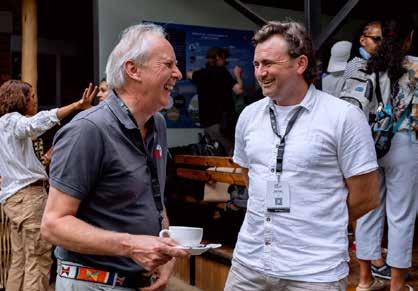
At Tusk, we are also in the process of moving from the third to the fourth phase, and Charlie Mayhew and Nick Bubb outlined how they have been managing that transition. Having established Tusk in 1990, the issue of who was to succeed Charlie in his role as Chief Executive was one that had been increasingly coming up with both the Board of Trustees and some longstanding donors. Charlie stressed how his priority has always been to ensure that Tusk as an organisation endures, and when the opportunity presented itself to hire Nick Bubb as the ideal candidate to take over the reins, it had to be taken. Even beforehand, the senior team at Tusk had already been taking on greater responsibilities, who together with a strong Board of Trustees, Nick at the helm, as well as Charlie in his new role, can ensure that Tusk not only endures, but can continue to grow and thrive.
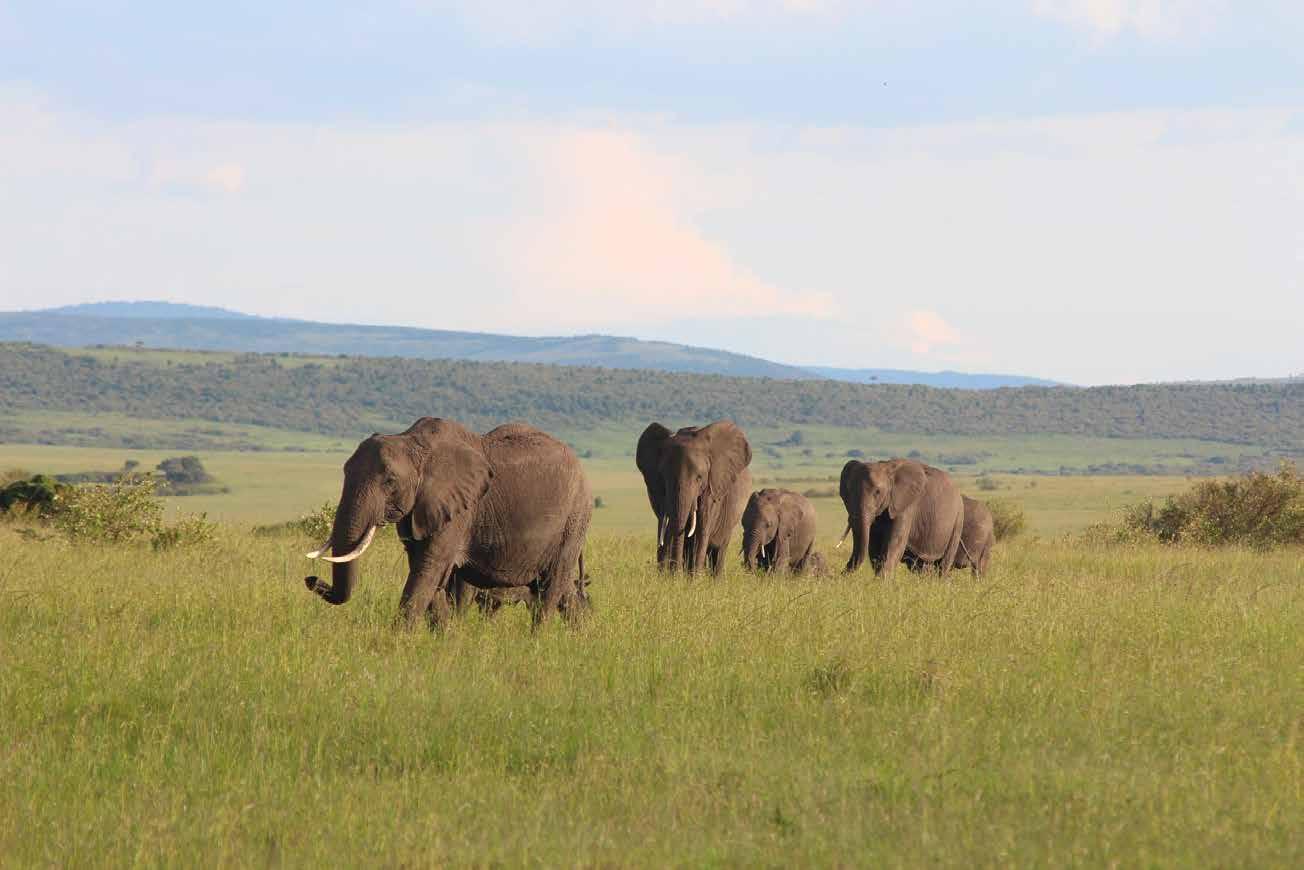
Awards, the Lion Trail, the Symposium, the Times Christmas appeal match funding, and the Tusk Ball.
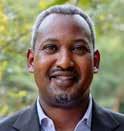
Eugene Mutangana Head of Conservation & Acting Director, Rwandan Development Board
How governments can position the environment and conservation as a top priority is an issue that Tusk’s project partners have expressed an interest in learning about. A presentation from the Rwandan Development Board was therefore an invaluable part of the 2024 Tusk Conservation Symposium and a highlight for many delegates.
Rwanda has been on a remarkable journey of transformation since the horrific 1994 Tutsi Genocide. The process of rebuilding that started thirty years ago, brought with it many competing priorities, all of which needed funding. To tackle these needs together, and with the aim of making Rwanda the first choice for investment on the continent, the Rwanda Development Board (RDB) was established in 2008, with the merger of eight government institutions, primarily to create a “One Stop Shop” for business and investments. Conservation and tourism are our other top priorities, with conservation integrated with and enabling other businesses. Competing interests are now managed and guided by the RDB’s policies and the country’s laws, which place environmental considerations at the heart of everything done, even if it’s the development of transport infrastructure or mining. Decisions are taken collectively by the government’s Private Investment Committee, which includes representatives of all ministries, as well as the RDB, and ensures that no single ministry can make a unilateral decision.


Delphine Uwase Head of Strategy and Competitiveness, Rwandan
Development Board
Main image
Rugezi Marsh, Rwanda
Bottom left
Eugene Mutangana & Dephine Uwase’s presentation at the Tusk Symposium
Bottom insert
Grey Crowned crane
Credit: Rwanda Wildlife
Conservation Association
Top right
Mountain gorilla
Credit: Susannah Rouse
Our country’s development of tourism in support of conservation is widely heralded as a big success story.
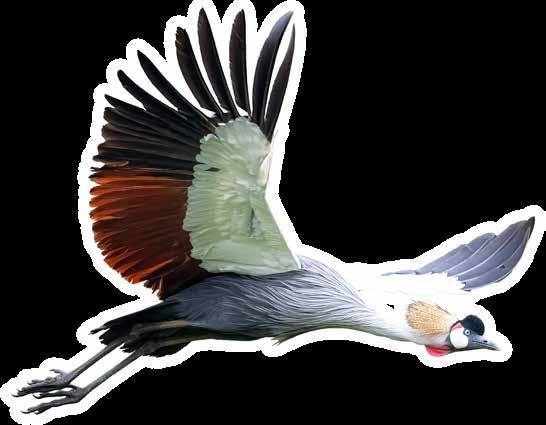
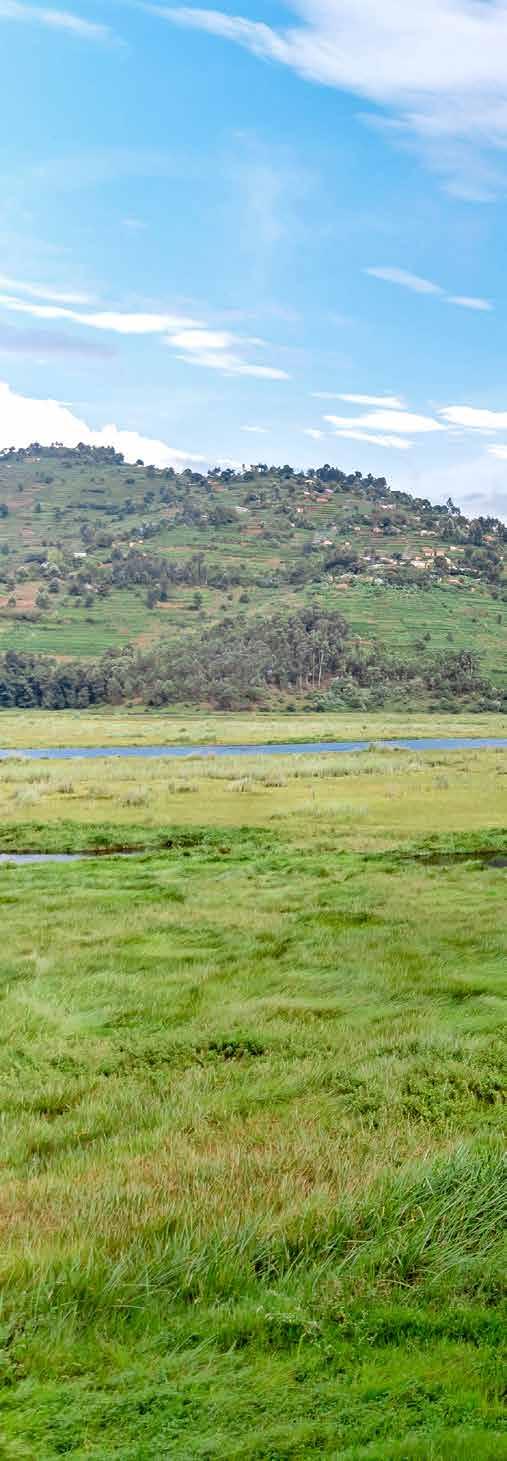

Our country’s development of tourism in support of conservation is widely heralded as a big success story. Despite the setbacks presented by the Covid-19 pandemic, tourism and hospitality have shown a strong recovery, and last year had grown to 135% of their pre-Covid levels. The country’s conservation efforts are central to this success, with so many of the tourists coming to visit the mountain gorillas and other natural wonders. Conservation is, therefore, an income-generating activity, and one that can change lives too, as through our revenuesharing scheme, 10% of the tourism income is invested back into local community projects. Last year this amounted to 3.27bn Rwandan Francs (equivalent to $2.54m), and whether it gets invested in local schools, health clinics, or other community income generating projects, it’s the community who gets to decide how the funds are allocated. A conservation culture is now embedded within the Rwandan setup. Our annual Kwita Izina gorillanaming ceremony has become a source of local pride.
Likewise, while it took some time to catch on and was seen as a chore at first, the monthly Umuganda nationwide community service is now embraced as a way of keeping the country clean. This is supported by a national ban on plastic bags, which was introduced in 2008.
Rwanda’s journey has not been without its challenges, and the RDB’s structure has gone through a number of iterations before finding a solution that works. There will also no doubt be many challenges and opportunities ahead in an ever-changing world, where development priorities have to keep pace with advances in technology and AI, for example. However, by retaining the environment as a core pillar and looking at opportunities for how national priorities can complement rather than compete against each other, the RDB has provided a model that puts conservation at the heart of government. There’s an old adage that says that if you want to go fast, go alone; if you want to go far, go together. The RDB has shown that is in fact possible to go fast together!


Irene Mhlanga Researcher, African Leadership University, School of Wildlife Conservation
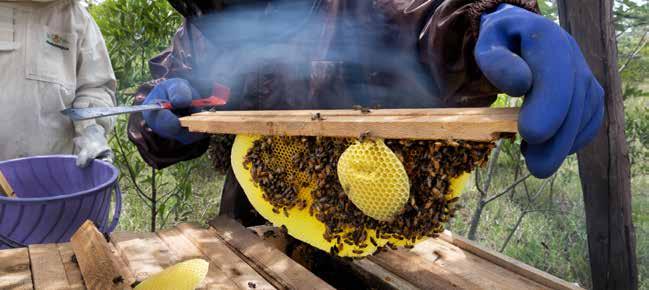

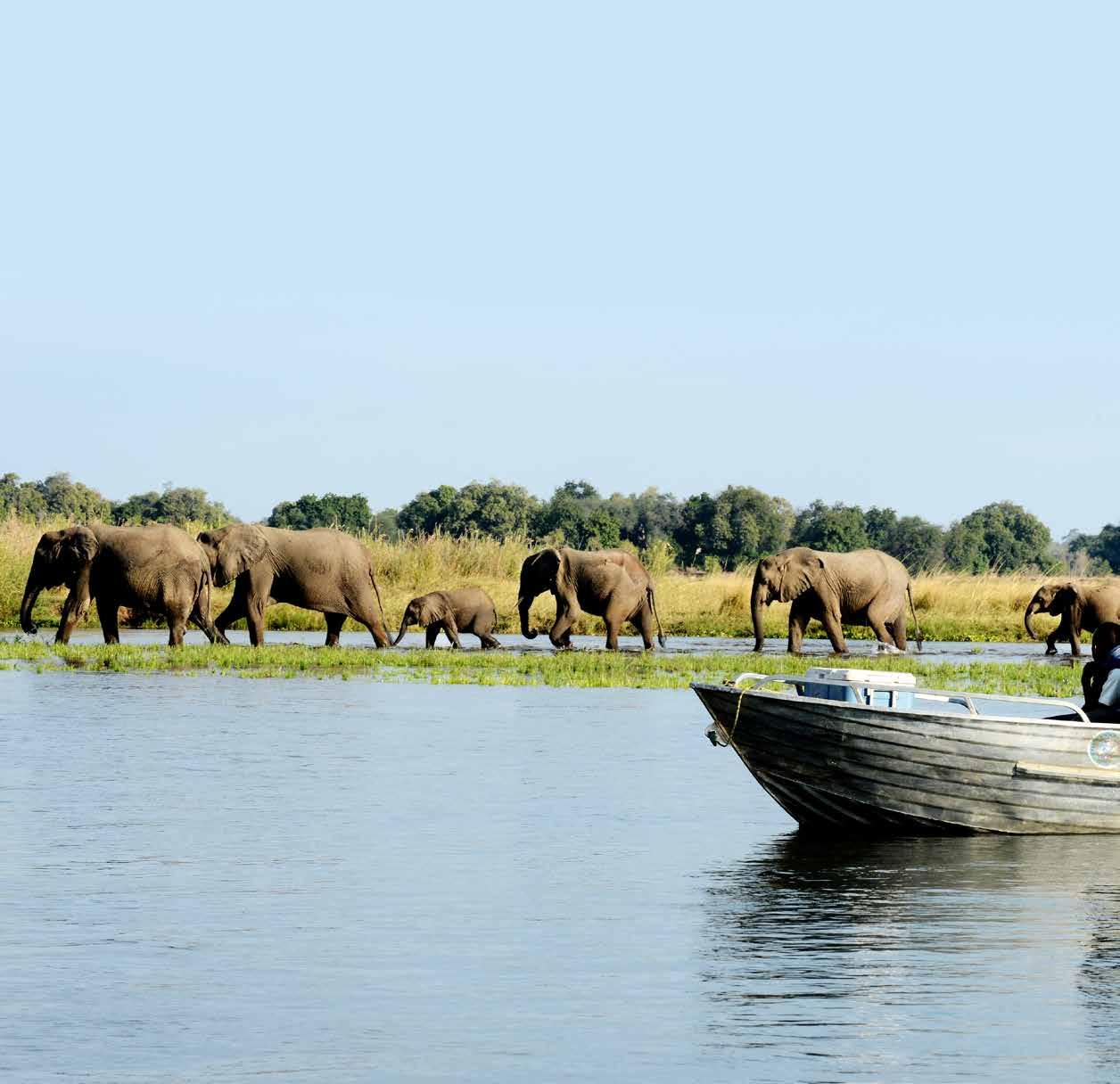
The traditional narrative of wildlife conservation has been about protecting nature from people. However, while the number of protected areas is increasing globally, we’re still experiencing a rapid loss of biodiversity, and protected areas are becoming more and more isolated. So, this approach alone is not working.
For conservation to succeed, we need it to be about protecting fauna and flora for people, and not from people. Natural resources can be economic assets that should be invested in to support people and conservation. Currently, however, we still don’t fully understand the economic value of our wildlife assets.
To redress this, in 2021 the African Leadership University (ALU) published the State of the Wildlife Economy in Africa report. This identifies the “Big Five” wildlife economy activities, which together constitute a market share of over $250 billion per year in Africa*.
Tusk and its project partners meanwhile have the opportunity to help communities understand the value of their natural resources
Main image
Left insert
Right Honey extraction
Africa especially is not utilising the full potential of its natural resources, despite their comparative abundance relative to other continents. Unlocking the potential of the wildlife economy will require improvements to the overall business environment and a strengthening of the policy, legal and regulatory provisions governing natural resources. The promotion of collaborations and partnerships are also needed, together with improved transparency and data collection. Finally, the capacity of all stakeholders to engage in and manage the wildlife economy needs developing.
To help, ALU has developed the Wildlife Economy Investment Index as a measure of the investment potential in Africa’s wildlife economy, scoring countries according to their investment enabling environment and wildlife status.
Tusk and its project partners meanwhile have the opportunity to help communities understand the value of their natural resources and facilitate their first steps in unlocking the potential of the wildlife economy. In doing so, it is important that they help set the moral compass and ensure that both wildlife and local communities do genuinely benefit from any endeavour.
Bear Grylls
Credit: Nick Spollin
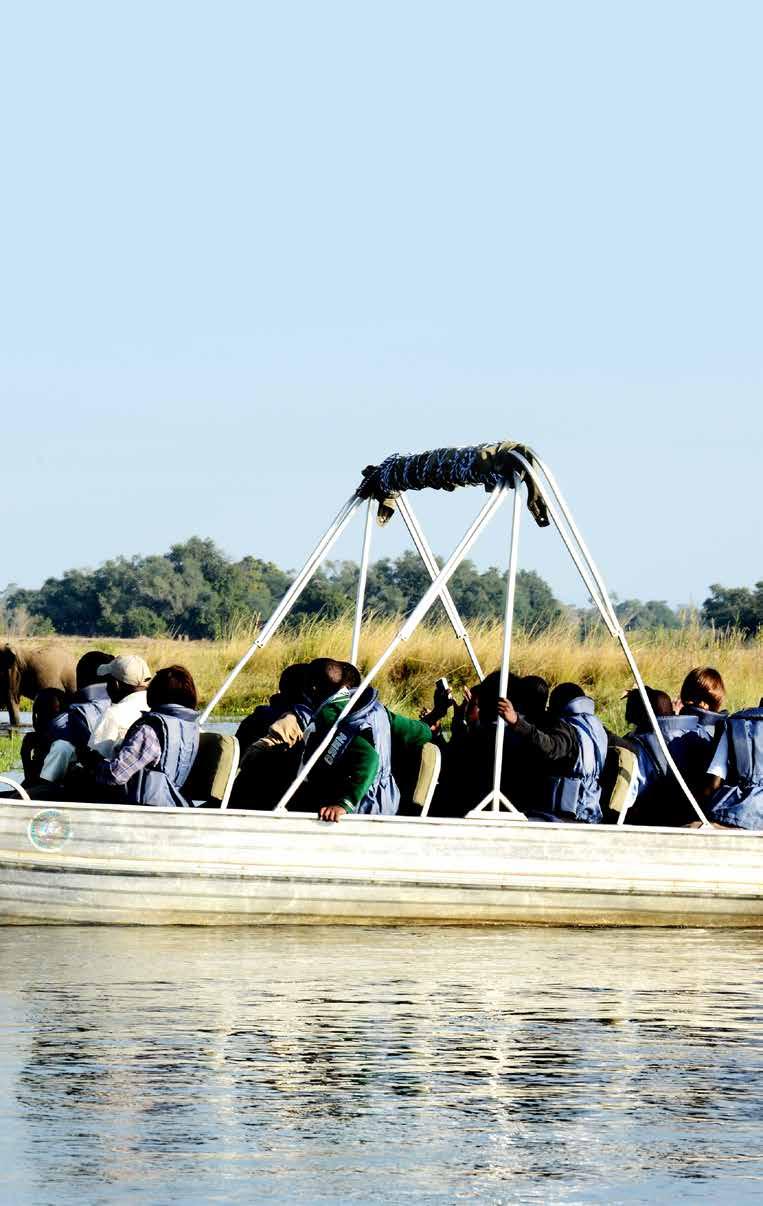
There is then an opportunity for NGOs to support by building capacity, facilitating access to local markets, investors and government bodies and providing expertise that is required to scale community efforts so that we see many more success stories of ethical enterprises benefiting conservation and supporting development.
* To access the report (from which all figures are quoted) visit sowc. alueducation.com/ research/ and for more information see sowc. alueducation.com/weii/
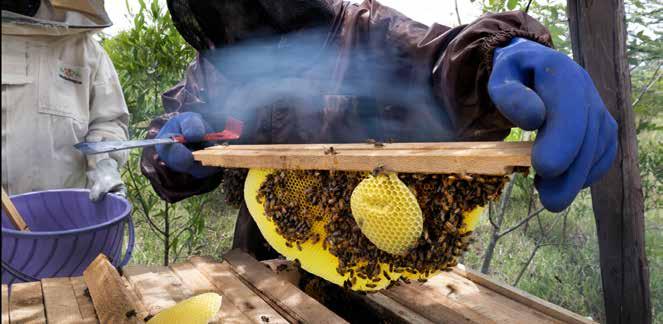
1. Wildlife tourism An annual investment of $2.7m into Zambia’s South Luangwa National Park, for example, drives the $13.9m local economy in the town of Mfuwe.
2. Wildlife ranching While not palatable to all, this can yield large economic dividends. In South Africa, the sale of wild meat generates $56m per year. In most parts of Africa there is a thriving illegal bushmeat trade, which is a threat to many species, but if controlled and regulated could potentially help protect them in some cases.
3. Hunting and fishing This includes the even more controversial practice of trophy hunting, which generates up to $4.5m per year in Namibia. Fishing meanwhile provides a livelihood for many, with approximately 750,000 artisanal fishers just in West Africa, each earning $6-13 per day.
4. Carbon This presents an untapped opportunity with great potential for generating income through offsetting. To date, Carbon Tanzania has already generated almost $500,000 for local communities, while in Zambia, the carbon markets have delivered more than $5m for community development through the Luangwa Community Forests Project.
5. Non-timber forest products (NTFPs) These include everything from honey and wild fruits to medicines and rattan, and also hold a high degree of untapped potential. In Zambia, the overall income from NTFPs is approximately $135.8m per year, while in South Africa, Cape Aloe (Aloe ferox) generated approximately $154m between 2005 and 2014.

Programmes Manager, Okapi Conservation Project, Democratic Republic of the Congo
Igot into nature conservation following the inspiration from my father. He worked for a good part of his life in the protection of the endangered okapi and the Okapi Wildlife Reserve, until he died in 2002 in a car accident when coming back from a peace negotiation to help security at the reserve. I was inspired to continue his work.
Why is the okapi so special and what does it mean to local people?
The only place in the world where the okapi is found in the wild is in our country, specifically the Ituri Forest where the Okapi Wildlife Reserve is found. I spent a good part of my childhood next to the enclosures that housed the okapis in captivity at the Epulu station, the headquarters of the Okapi Wildlife Reserve, where my father worked. My mother fed the okapis, and I would accompany her and watch them. It is an animal that shaped my childhood with its calm and beautiful skin, which looks both like a zebra and a giraffe. The okapi is an iconic species for our country and source of pride for local resident communities.
There is a chance that we will be able to guarantee peace and security, and a favourable habitat for the okapi in the future.
Main image Okapi within the Okapi Wildlife Reserve
Below left & right Agroforestry and agriculture community projects

Bottom Okapi Conservation Project team
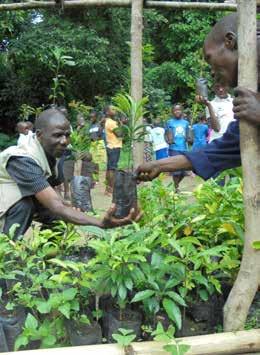

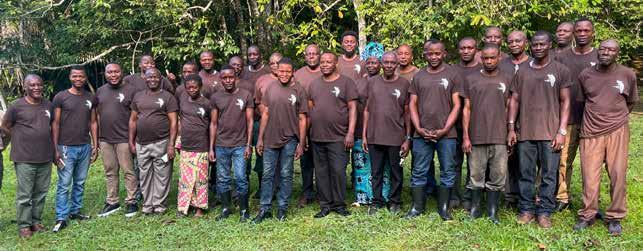

What role do local communities play in okapi conservation?
The local communities help secure the reserve, and also participate in the rehabilitation of deforested areas through a large agroforestry programme in and around the reserve, thereby reducing the major threats to the forest. Without this local participation in securing the reserve, the okapi population would be facing a much higher risk of extinction.
How can we get more people to care about endangered wildlife like the okapi?
We can only get more people to care about wildlife like the okapi through awareness raising and reinforced environmental education programmes. We must show the importance of nature conservation and the okapi in particular, and the danger that awaits it, in order to encourage the effective involvement of anyone in its protection.
What does the future look like for the okapi and their forest home?
If through our anti-poaching efforts, community conservation and environmental education efforts, we can stop all forms of illegal activity such as deforestation, armed poaching and mineral exploitation in protected areas, there is a chance that we will be able to guarantee peace and security, and a favourable habitat for the okapi in the future.
How has Tusk’s support helped you and your project?
Tusk has been a partner of the Okapi Conservation Project for several years and their support has empowered our team’s local Congolese leadership, including myself, showing that they value the importance of investing in local people. I'm very happy to have the incredible support and backing of Tusk’s network of donors and partners.

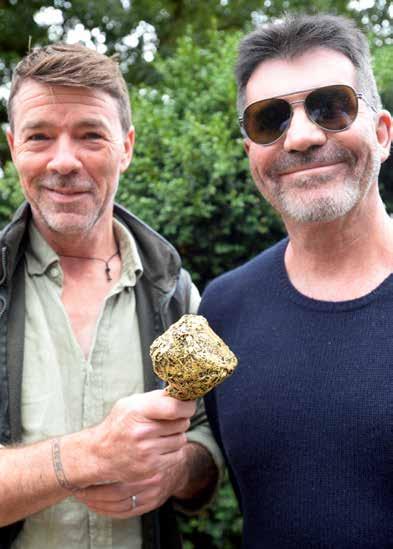
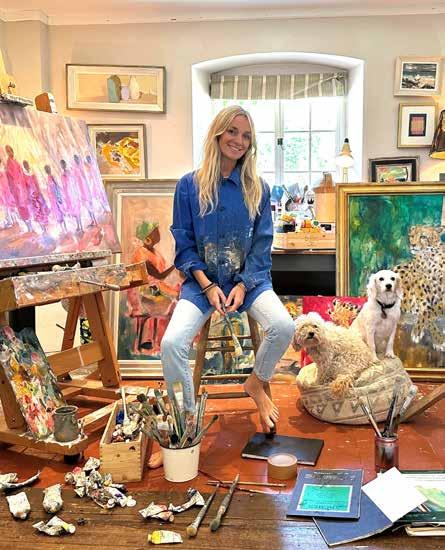
Every year Tusk offers a calendar of events, for everyone to enjoy whilst supporting our work. With an exciting schedule of events to come through the latter half of 2024, we reflect on some of the highlights from the past year.
• Lewa Safari Marathon 2024: Saturday 29th June (see pages 37-38)
• Wildlife Ranger Challenge 2024: Saturday 21st September (see pages 41-46)
• Tusk Conservation Awards 2024: Wednesday 27th November (see pages 51-56) Showcasing Tusk’s work and raising valuable funds
Credit: Paul Nicholls
Jemma Powell in her studio
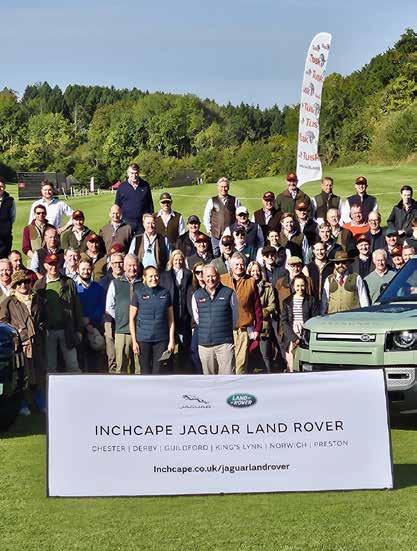
There are some events that can’t be foreseen, and a gilded rhino dropping selling for over £5,000 at auction was certainly one we couldn’t have predicted! In August 2023, Cotswold Wildlife Park hosted its annual rhino conservation event, Rhino Month, which included this unusual sale. With all proceeds going to Tusk, we’re very grateful to Cotswold Wildlife Park and, of course, the winning bidder!
Autumn 2023 saw two events take place in support of Tusk at the incredible Thyme in Southrop. Firstly, Tusk Ambassador Jemma Powell held an exhibition of her stunning paintings, with a percentage of proceeds donated to Tusk. Secondly, the Art for Charity Collective hosted an exhibition at Thyme’s Swan Inn and a live Instagram auction; a fun and innovative way to sell artwork, with charity at its core, raising over £5,000!. A big thank you to Jemma and all the other artists who donated pieces to the ACC exhibition.
An Evening with Bear Grylls
Bottom right
The BlueTusk team after completing the Atlantic Challenge
Credit: Worlds Toughest Row
In September 2023, we held our ever-popular annual Tusk Clay Shoot, a fantastic day of sport, team-building, networking and fundraising. This year, we head to a new venue, Holland & Holland, on Wednesday 25th September, where we shall reprise this fun and friendly sporting event.
For more information or to book a team, contact susie@tusk.org


Over 400 people joined Tusk for an Evening with Tusk Ambassador Bear Grylls OBE, one of the most recognisable faces of adventure on the planet, at London’s Royal Geographical Society in December 2023. Bear’s talk was inspiring and uplifting. He took us back to his childhood and what inspired him, including some exclusive clips of his very unique journey. As No.1 bestselling author, the Honorary Colonel to the British Royal Marine Commandos, and the first ever Chief Ambassador to 57 million young Scouts worldwide, we were honoured that he shared his story in support of Tusk's work.
See pages 39-40 for Bear’s article on Resilience, Fire and The Power of The Human Spirit.
After just over five weeks at sea, the BlueTusk trio completed the world's toughest Atlantic row on 21st January 2024. Not only did the team win the trio category in the race, but they raised over and the Blue Marine Foundation, which the Vodafone Foundation have generously matched to double the impact. A huge thank you to Chris, Aaron and David for their impressive efforts, and of course the Vodafone Foundation. We look forward to cheering on our next team rowing in support of Tusk, the Deep Blue Crew, who will set out across the Atlantic this December 2024!
See page 58 to read Chris’s account of their trans-Atlantic adventure.
To
you fellow players, enthusiasts and collectors, I wish you many good times with these old friends of mine
Mark Knopfler
At the end of January 2024, Dire Straits’ lead man and Tusk Ambassador, Mark Knopfler, sold his collection of more that 120 guitars and amps at a live auction held at Christie’s London. The exhibition attracted thousands of fans from across the world, generating excitement for almost two weeks before the auction, and in total the auction raised over £8m – far more than estimated. Mark, very generously, donated 25% of the total hammer price across three different and worthy charities, with Tusk lucky enough to be one of the recipients. We are hugely grateful for Mark's and Christie’s support and thoroughly enjoyed such an intense, exciting auction!



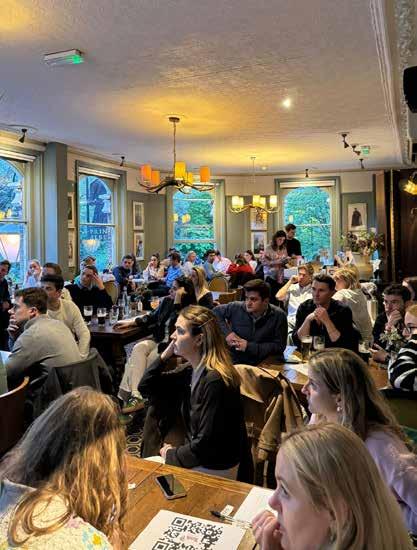
During February 2024, Internationally acclaimed wildlife photographer Will Fortescue took a team of nine friends 150 miles inside the Arctic Circle to undertake the Tusk Arctic Challenge, facing a series of tasks that included cross country skiing, emergency fire and shelter building and a few other surprises in temperatures down to -20°C, while raising meaningful funds for Tusk.
If you’re interested in taking your own team to the Arctic, please contact hannah@tusk.org for more information.
The London Marathon is one of the most iconic marathons in the world, passing by many famous landmarks and finishing on the Mall outside Buckingham Palace. Tusk proudly cheered another strong team of 41 runners across the finish line on Sunday 21st April 2024. The team raised over £100,000 for our project partners. Well done team and thank you!
For the chance to run for Tusk on Sunday 27th April 2025, contact hannah@tusk.org to register your interest.
Left to right above Will Fortescue and his team taking part in the Tusk Arctic Challenge
Max Harper completing the London Marathon 2024 for Tusk
Generation Tusk pub quiz
Below
Edward Ndiritu, Head of the Lewa Wildlife Conservancy’s Anti-Poaching Unit, having completed the London Marathon 2024
Opposite page
Allison Williams & Alexander Dreymon at Tusk in New York
Charlie Mayhew, Shanan Campbell, David Yarrow & Nick Bubb at Sorrell Sky Gallery
In 2023, we welcomed a new cohort of Generation Tusk committee members, who have taken on the challenge of bringing Tusk’s work to next generation supporters in their stride. With three successful pub quizzes under their belt already, they have a fantastic line-up of events to come, including a fabulous Summer Party on 25th July 2024. Keep an eye on their Instagram @generation_tusk for news, updates and tickets.
For more information, or to be added to the Generation Tusk mailing list, contact susie@tusk.org
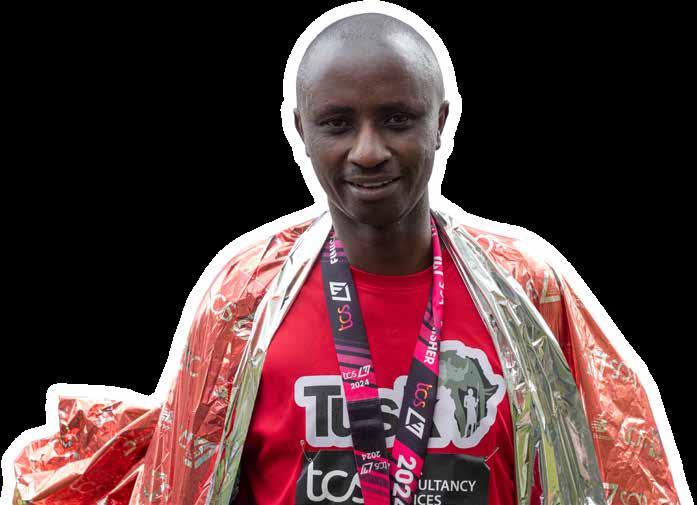
In October, Tusk made a stop in Washington, DC to gather with friends and supporters, kindly hosted at the Kenya Embassy by Robert Ng'ong'a, Trade Attaché. This event was followed by the first reception in New York since before the pandemic, which raised over $140,000 for Tusk. Sponsored by the Nick Maughan Foundation and an auction kindly conducted by Bonhams, Tusk in New York was also supported by ACCF, African People & Wildlife, Disney Theatrical Group, Ecoflix, Le Chameau, and On Location. The evening showcased the Wildlife Ranger Challenge and Lewa Safari Marathon, and included a special appearance by Alexander Dreymon and Allison Williams.

World-renowned photographer and Tusk Ambassador David Yarrow generously hosted Tusk guests with partner Shanan Campbell of Sorrel Sky Gallery upon the opening of their new SoHo location. In addition to a private viewing of David’s first New York exhibition since 2017, Tusk guests were treated to dinner and a presentation from David who selected five artworks for private auction to the group. Auction proceeds and a Tusk commission on additional gallery sales that week raised over $200,000 for Tusk.
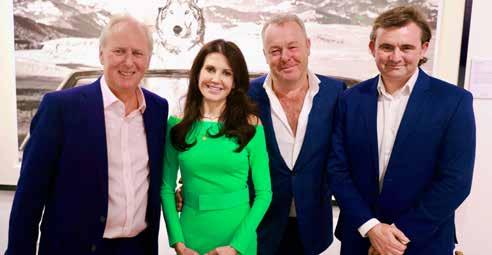
Tusk is proud to present our next US national reception in the Bay Area, a first event in Northern California. Tusk in Silicon Valley will take place on September 14th at Menlo Circus Club in Atherton, thanks to our venue host Lyn Jason Cobb, President of the Menlo Polo Club. We hope to see you there! Reserve your sponsor and patron package available now at bayarea.tusk.us.org! Tickets will be available this summer.
If you have a club or company willing to host an event for Tusk in the US, please contact bernadette@tusk.org














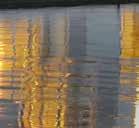








Tusk Gorilla Trail
Over the summer of 2023, 15 lifesize gorilla sculptures, designed by internationally recognised artists and well-known personalities formed the Tusk Gorilla Trail in and around the historic Piazza and streets of London’s Covent Garden and Seven Dials.
Curated by Chris Westbrook from Westbrook Gallery and staged in collaboration with Shaftesbury Capital, the trail brought together an array of talented artists from the world of art, design, film, photography and comedy.
Contributors included Rolling Stones guitarist and Tusk Ambassador Ronnie Wood and his wife, the producer Sally Wood; English actor and comedian John Cleese and his wife, designer Jen Cleese; British artist Chila Kumari Burman; internationally-renowned photographer Rankin; Printmaker Adam Dant; Tusk Ambassadors artist Jemma Powell and her husband, the musician Jack Savoretti; former army helicopter pilot, wildlife artist and Tusk Ambassador Hannah Shergold along with artists Barnaby Barford, Mr Jago, Gordon Cheung, Mauro Perucchetti and Nick Gentry.
All gorillas are critically endangered and their numbers are falling, other than the mountain gorilla, whose numbers have increased to over 1,000 individuals thanks to conservation efforts. Each sculpture in the Trail highlighted the beauty of gorillas, threats to their existence and the people and solutions working for their survival – raising awareness for conservation efforts across the African continent.
The sculptures were auctioned on 20th November, and raised over £130,000 in aid of Tusk’s projects protecting gorillas and other vulnerable species across Africa.
Main image
“Paint it Black” by Ronnie Wood
Credit: Nick Andrews
Below left
“The Guardian” by Mr Jago in position in Covent Garden
Right, top to bottom
“VHS” Ape by Nick Gentry & “Precious” by Sally Wood
Jemma Powell and Lady Bath with Jemma’s sculpture, “Gaia”
Artists and their sculptures gather for the launch of the Tusk Gorilla Trail


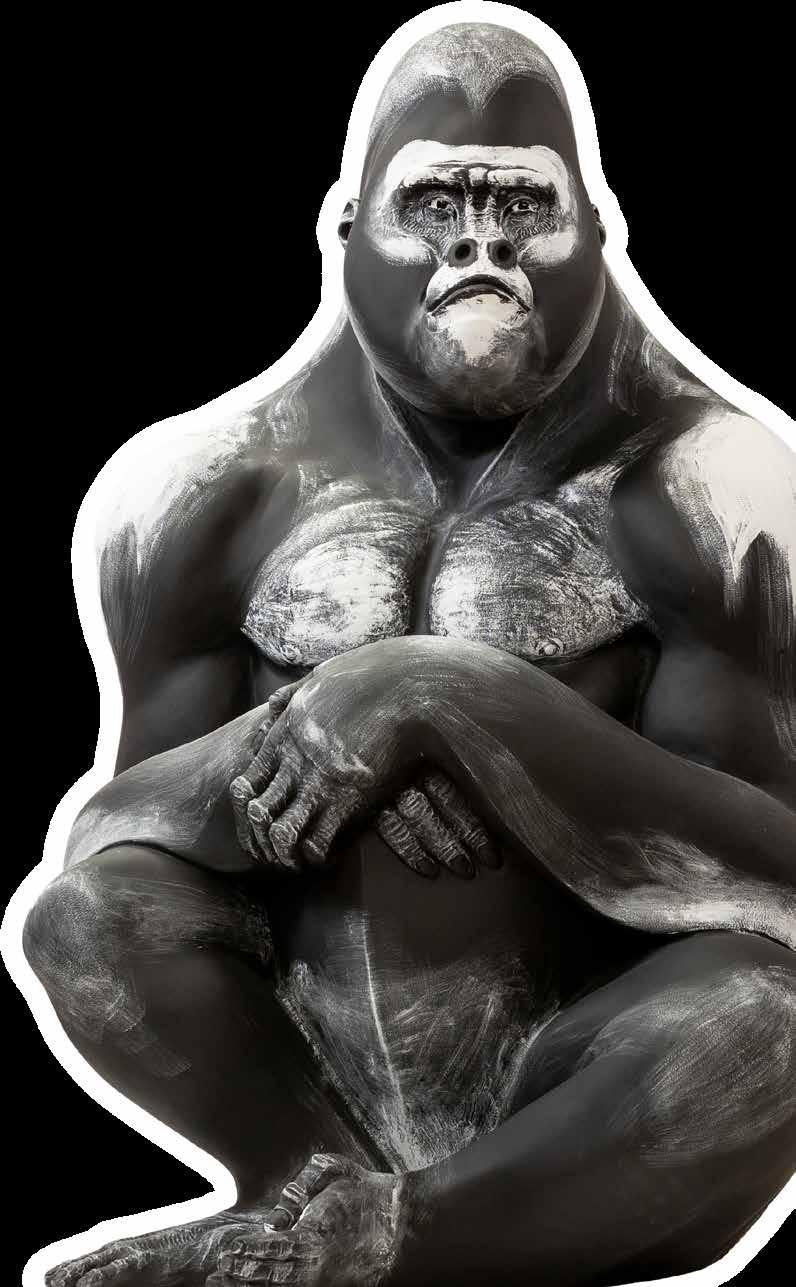

Mr Jago
Although considered to have been amongst the vanguard of Bristol’s acclaimed graffiti scene, Mr Jago's work over the last 20 or more years has firmly established him as one of the UK's most respected abstract expressionist painters. Mr Jago's colour-focused, automatic painting is heavily influenced by the natural world.
The Guardian reflects glimpses of the flora, fauna and insect life, which he has protected for thousands of years, and which he aspires to protect, for many years to come.

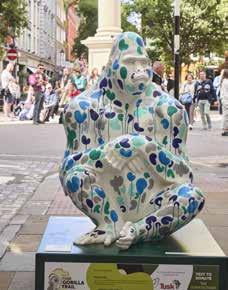

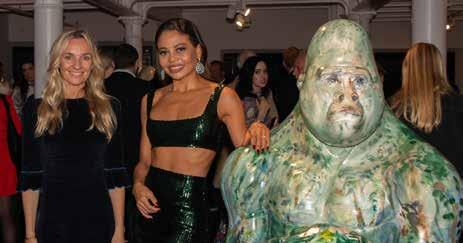
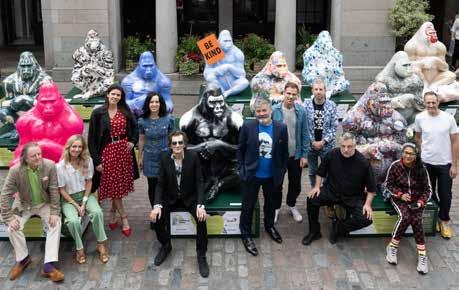
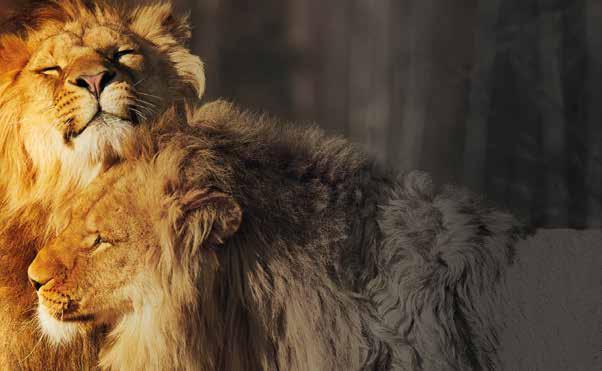
Working across drawing, sculpture, film, installation and painting, Barnaby Barford is recognised for his thought-provoking work. He explores the socio-political landscape, encouraging viewers to question the world around them.
Be Kind raises awareness of our curtailed rights to peaceful protest whilst prompting reflection on kindness towards oneself, others, and nature, emphasising the transformative power of fundamental acts.

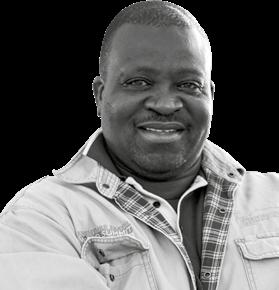
Director, Integrated Rural Development & Nature Conservation (IRDNC), Namibia
IRDNC’s success is based on the longterm trust that has been built with the communities, strong partnerships, with traditional authorities, local and national government, tourism companies, and other stakeholders within the landscapes we operate.
As a pioneer of community conservation, how did IRDNC set out, and what has been key to its success?
IRDNC is based on the three fundamental pillars: natural resource management; livelihood and enterprise; and building strong governance. Over the past 40 years, it has worked with rural communities in the Kunene and Zambezi regions, supporting 46 community-based organisations (CBOs) in conserving approximately 5.3 million hectares of land. This has enhanced the capacity of rural Namibians and assisted them in developing a civil society whose members can sustainably manage and benefit from their local natural resources. Subsequently, these efforts have led to improvements in the lives of rural people by diversifying the socio-economy in Namibia’s communal areas.
IRDNC’s success is based on the long-term trust that has been built with the communities, and strong partnerships, with traditional authorities, local and national government, tourism companies, and other stakeholders within the landscapes we operate. Furthermore, IRDNC stood by the community during times of strife and hardship over the decades, such as the Covid-19 pandemic.

What is the Kunene People’s Park and what makes it different?
Support from Tusk has been very instrumental, especially at a time when others could not see the light at the end of the tunnel.
Above Desert-adapted black rhino
Credit: Owlen Evans
Right
The “Women for Conservation” action group were instrumental in forming the first people’s park
John Kasaona discussing plans with Prince William on his visit to Namibia in 2018
Credit: Chris Jackson
The spectacular Kunene landscape
The Kunene People’s Park (KPP) is a progressive new type of protected area: an African way of linking conservation of wildlife to enhanced quality of life of the local communities. What makes the KPP different from conventional national parks is that it builds on and enhances community ownership of wildlife and valuable natural resources; it’s a genuine partnership between communal conservancies and the government. This landscape conservation concept will be expanded to other conservancies in the region. To date we have three People’s Parks in the making: Ombonde, Hoanib and Arid Eden People’s Parks.
What obstacles have you encountered along the way, and how have you overcome them?
The word “park” has a slight negative connotation because, historically, parks weren’t established with full consensus of the communities, mostly during the colonial and apartheid era. However, this one is a “people’s park”, meaning a park created by the communities and managed by the communities themselves, with no communities displaced due to acquisition of new land. All associated fears are being overcome by continuous awareness and communication at various platforms. The soon-tobe-enacted legislation also provides reassurance, affirming that this is certainly not an agenda to leverage conservation funding.

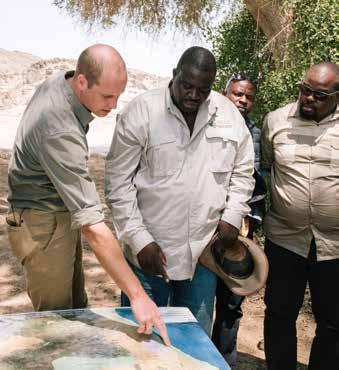
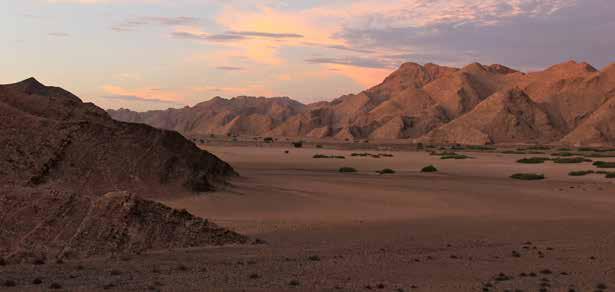

What’s the government’s view of the People’s Park and how does it engage?
The upcoming new legislation (Protected Areas and Wildlife Management Bill) makes provision for communities to establish protected areas of this type, managed by and benefitting the community themselves. The current consultations on this initiative are supported by the government, who attend meetings to address any questions related to the upcoming legislation. Recently IRDNC, WWF and the Ministry of Environment entered a consortium to access funding from the Legacy Landscape Fund, particularly for landscape conservation in the Kunene region of Namibia. At the centre of this is the support to establish and operationalise people’s parks for the next 30 years.
What does the future hold for this part of Africa and its wildlife?
In the face of adverse climatic challenges, the future lies in a wildlife-based economy and livelihoods. The people of this region have long realised this; hence the successful conservation programme today.
How has Tusk’s support helped you and your project, and how do you view Tusk as a partner?
Support from Tusk has been very instrumental, especially at a time when others could not see the light at the end of the tunnel. Tusk stood with us as we forged through this dream of building people’s parks with the communities we support. We view our partnership with Tusk as a long symbiotic relationship that will stay through all the obstacles and successes that will come along with new conservation initiatives.
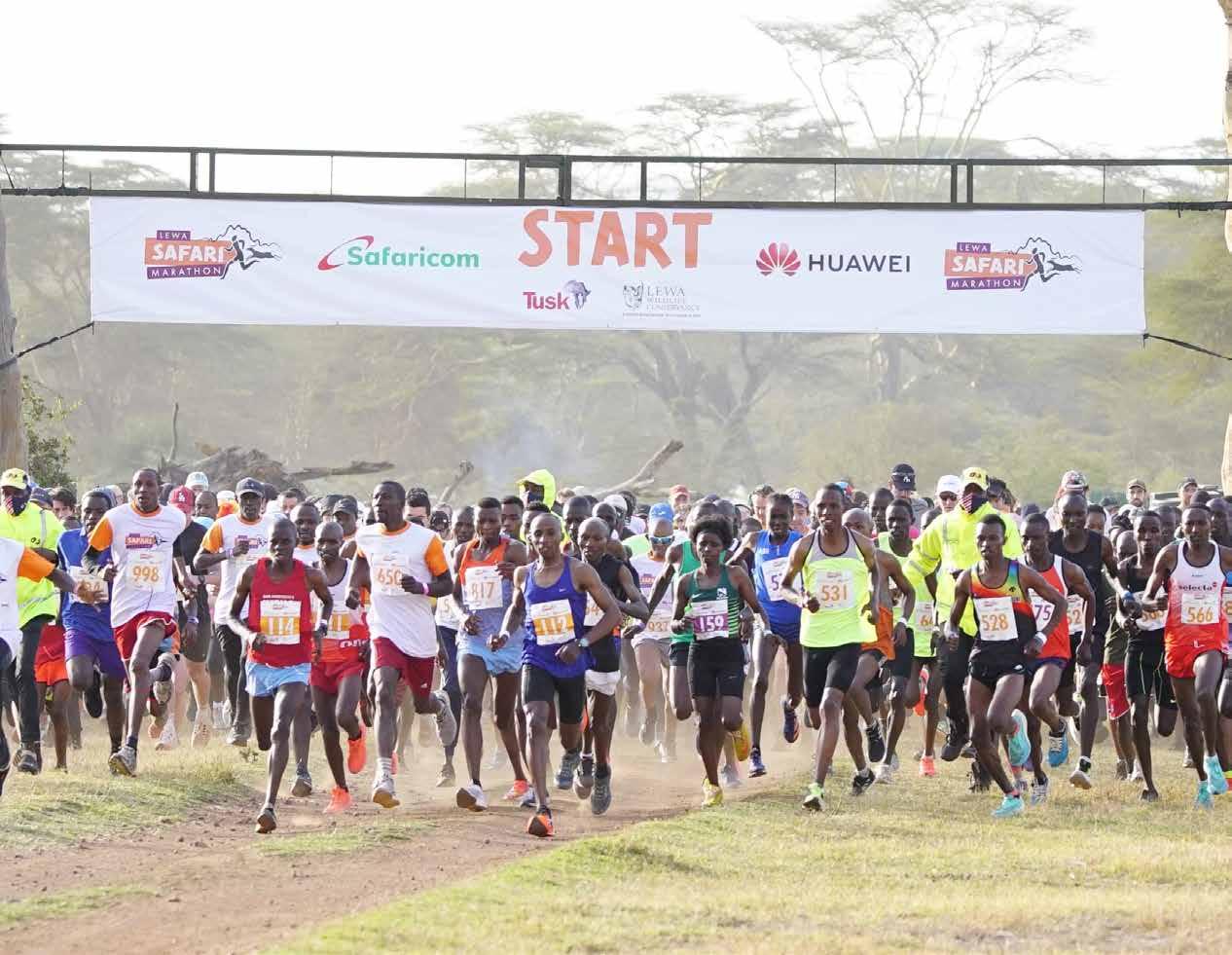
The annual Lewa Safari Marathon, organised by Tusk in partnership with the Lewa Wildlife Conservancy, and sponsored by Safaricom and Huawei, invites participants from all over the globe to compete in an internationally acclaimed event, running through one of Africa’s most spectacular wildlife conservancies and a World Heritage Site.
Regarded by Runner’s World as one of the world’s top ten “must do” marathons, runners of all abilities take part. Individuals and corporate teams enjoy an unforgettable experience running alongside some of Africa’s most amazing wildlife and witnessing firsthand the difference made by the funds raised.
By running together, we can also conserve our environment, empower our communities, take care of our wildlife and support those at Lewa working for a future for us all.
Tusk and its project partners meanwhile have the opportunity to help communities understand the value of their natural resources

The 2023 Lewa Safari Marathon took place on 24th June, and with local and international participation back to full strength, it felt like a return to pre-Covid times. Fundraising was equally strong, thanks especially to the incredible fundraising effort of the BlackRock team, who raised close to $400,000. We were also delighted to be joined by Tusk ambassadors, Jack Savoretti and Jemma Powell, who greatly enjoyed the experience. John Mitei won the men’s marathon, crossing the finish line in 2:21:23. Mercy Kwambai was the first women across the line in an impressive 02:48:35. Half-marathon winners were Nelson Rono and Beatrice Cheburet with times of 01:05:32 and 01:16:15 respectively.
In 2024 we will be celebrating the event's 25th Anniversary on Saturday 29th June. As we approach this historic milestone, we look back through the annals and the difference the event has made within Kenya.
&
As the oldest ever runner of the Lewa Safari Marathon, John Ruengo is a big part of the event’s history, having taken part every year since it first began, until he sadly passed away in early 2023, aged 92.
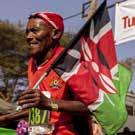
Notable participants that have taken on the challenge previously include Kenyan former marathon world record holders, Eliud Kipchoge, Paul Tergat and Catherine Ndereba, former half-marathon record holder Geoffrey Kamworor, and Paralympic champion Henry Wanyoike. Tusk celebrity ambassadors Ben Fogle, Jack Savoretti and Levison Wood have all completed the course, as has the Princess of Wales’s sister, Pippa Middleton.
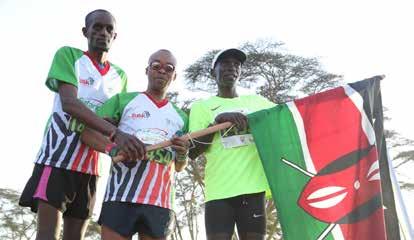
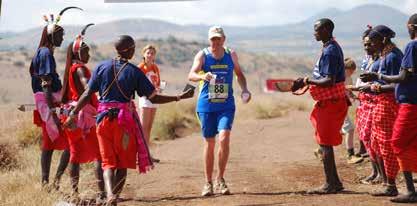
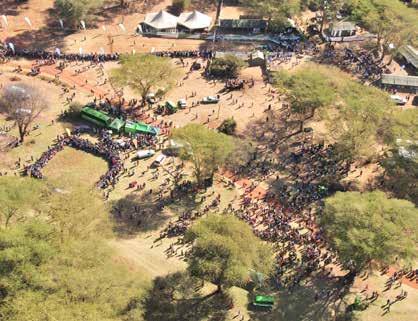
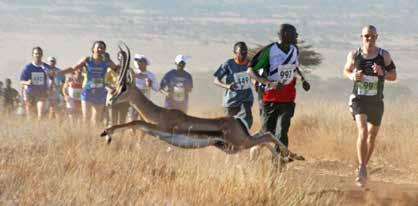

Runners come from 40+ countries every year
Flagship species protected each year include Grevy’s zebra, black and white rhino, hawksbill and green turtle, elephants, and mountain bongo:
• 14% of Kenya’s rhino population is secured yearly
• 200+ black and white rhino births on the Lewa-Borana landscape since the marathon’s inception
25,000+ runners to date
$9,000,000 raised over the past 25 years in support of wildlife and local communities throughout Kenya
• 25% of the global Grevy’s Zebra population is protected through support to the Grevy’s Zebra Trust
• The marathon supports the protection of the last viable gene pool of ‘Super Tusker’ elephants. This currently stands at 8 bull super tuskers, 28 bull emerging tuskers and 4 iconic female tuskers.
• 140 critically endangered mountain bongo antelopes protected through prevention of illegal activity in their habitat
• Six hospitals and clinics supported annually and equipped with life-saving equipment
Current record for the full marathon = 2:18:09
At least 6,000 bananas and 5,000 oranges eaten every race
• Over 10,000 students have benefitted through bursaries, school infrastructure and other support to government schools around Lewa and the Northern Rangelands Trust
• 33 community conservancies supported across Northern Kenya, the Kenyan Coast and Rift Valley
• 724 women artisans in the Maasai Mara supported annually, through beadworks and bee-keeping

When great minds come together good things happen. I’m happy to be a part of it because of the community benefits, and the environment, the animals. It’s very important for everyone. It’s not an easy course. To me, if I can make it here, I can make it anywhere in the world. But it’s one of the best races. We’re running on our own soil which means a lot.
Henry Wanyoike, paralympic champion

Bear Grylls OBE Adventurer, Tusk Ambassador
Tusk Ambassador Bear Grylls is one of the world’s most recognised faces of survival and outdoor adventure. He spent three years as a soldier in the British Special Forces as part of 21 SAS Regiment, and soon after became one of the youngest climbers ever to reach the summit of Mount Everest. Here, he outlines how his mantra of courage, kindness and never giving up is mirrored in the actions of the biodiversity protectors of Tusk’s Wildlife Ranger Challenge network.
Afriend once asked me what qualities were needed for the UK Special Forces. It’s an interesting question, but at heart an SAS soldier needs to be self-motivated and resilient; to be calm, yet have the ability to smile when things are grim; to be unflappable, be able to react fast and to have an ‘improvise, adapt and overcome’ mentality. What strikes me most is the echoing of these qualities in the frontline wildlife protectors I have had the privilege of knowing and working alongside.
Africa’s rangers are the guardians of the continent’s natural and cultural heritage, protecting nature and wild places to maintain a healthy planet to benefit us all. These men and women often work in remote areas of wilderness where communications with the ‘outside world’ can be difficult, and rangers can often feel isolated and alone in the vital work they perform.
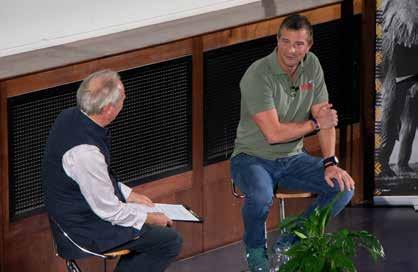
Left
Bear Grylls talking to Tusk’s Charlie Mayhew for An Evening with Bear Grylls in December 2023
Right
Mount Kenya Trust rangers
Bear Grylls and Be Military Fit run a specially designed workout at London’s Battersea Power Station, in support of the Wildlife Ranger Challenge 2023
Credit: Ben Stevens
To every ranger out there, I would like to share with you some words from my father that I try to live by. ‘What really matters in life is to follow your dreams and to look after your friends and family along the way’.
If I look back at a lifetime of adventures, I see one common thread that runs through every endeavour: the need for genuine teamwork in order to prevail. Great friendships are forged in fire, and with every expedition I have been part of, it is this solid comradeship that has been the determining factor to success or failure.
There is an extraordinary power in real friendship in extremes, and no limit to what you can do together when you help each other, and when you’re honest and vulnerable with each other. When you have nothing left to give, a true friend is the one who will turn around and help you find that little bit extra inside to keep going, standing shoulder to shoulder.
I have witnessed this same spirit building in the men and women forging the world’s biggest movement for wildlife rangers. The camaraderie demonstrated by those within the Wildlife Ranger Challenge network is palpable. The campaign has provided an unparalleled opportunity for rangers across the continent to connect and support each other. The shared experience between the thousands of ranger participants stretches far beyond race day, to form a mutual understanding of professional dedication and personal passion.
I see so often a set of common attributes in those who succeed against the odds. Those of skill, humility, endurance, and character. Arguably the traits present in an effective ranger force, and definitely those demonstrated by the teams that rise to the top of the annual Wildlife Ranger Challenge. And it is just that: a challenge. The combination of searing temperatures, demanding terrain and hefty pack weights make this event one of the toughest of its kind.
But the winners are those who know that when things get really hard and others start to fall away, that is the time to dig deep and give that little bit extra. Sometimes we have to go through genuine adversity to come out the other side better, stronger and more empowered.
To every ranger out there, please know that we admire you more than you will ever know, and we recognise your incredible dedication and unwavering determination. You’re true inspirations.
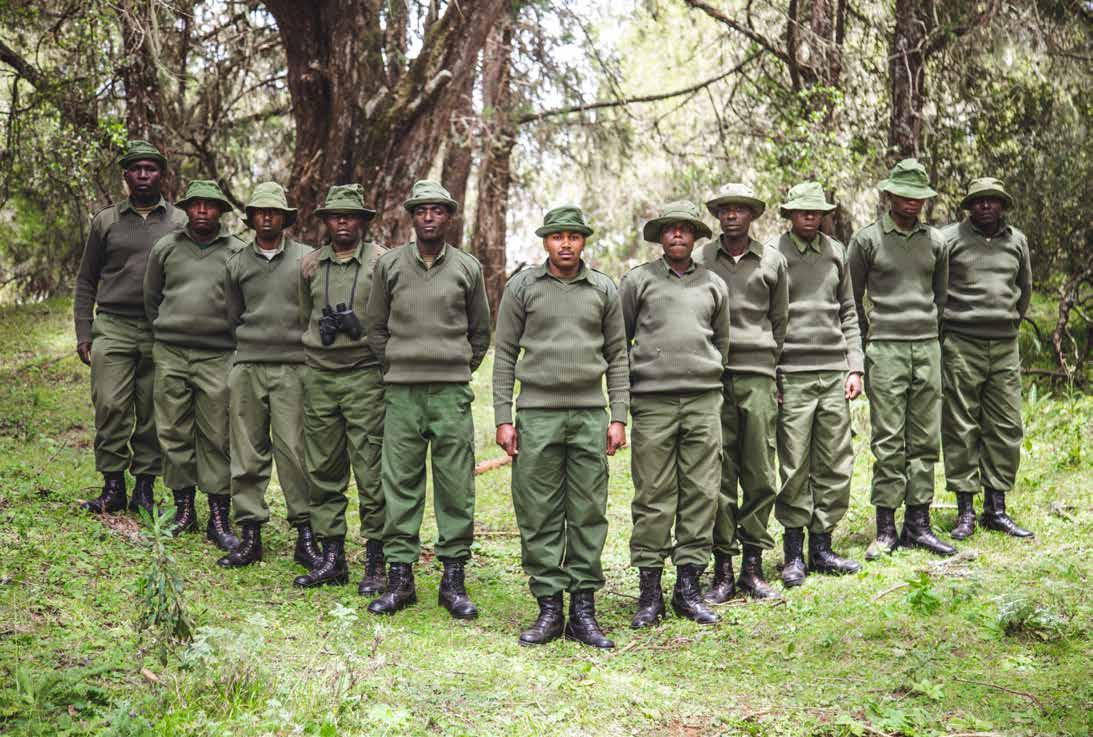




More than 1,500 rangers from across 22 African countries came together for the fourth annual worldwide celebration of biodiversity protectors.

Launched in response to the Covid-19 pandemic in 2020 with the goal of keeping wildlife rangers employed through the crisis, the Wildlife Ranger Challenge has grown into an annual celebration of solidarity, connection and camaraderie for the ranger profession.
The initiative joins thousands of rangers from 24 African nations with supporters from over 90 countries across the world – uniting the global north and the global south for a common goal: to raise money to boost thousands of rangers and ensure a future for Africa’s biodiversity.
Coordinated by Tusk and the Game Rangers Association of Africa, the multi-million fundraising initiative featured a series of training mini challenges, including push-up and sit-up challenges, and a specialist quiz testing the rangers’ knowledge. The 2023 event also featured a canine challenge for protected areas with dog units, in which dogs and handlers competed to demonstrate their tracking skills, using scent to identify an object across a pre-defined competition space.
Main image
Wildlife Ranger Challenge 2023 regional event at Murchison Falls National Park, Uganda
Credit: Uganda Conservation Foundation
Left Black Mambas rangers holding recovered snares
Credit: Valeria van der Westhuizen
Right
Lewa Wildlife Conservancy rangers
Save The Rhino Trust rangers tracking
Credit: Marcus Westburg
Lewa Wildlife Conservancy vet and ranger attending sedated lion
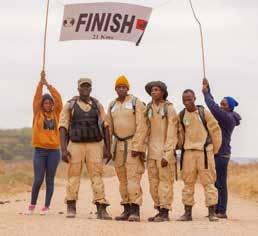
The men’s race was won by Tanzania’s African People & Wildlife - Tarangire Ecosystem Team (A) team, in an impressive 2:01:25. Rangers Ezekiel Loserian, Ramadhani Mustafa, Mwasudi Nasiru and Milya Hodati became the new title holders.
Zambia’s
Zambia’s Conservation South Luangwa - Atsikana team took the women’s title, with rangers Maureen Mulenga, Beauty Ntala, Loveness Kumwenda and Aliness Chilepa recording a time of 2:45:27.
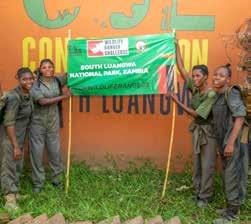
On 16th September 2023, more than 100 teams of rangers, with each member carrying 22kg of kit, competed in a coordinated 21km race across their respective landscapes. They were joined by more than 2,000 supporters across the globe, running in solidarity with them, and for the first time, select teams gathered at different locations in Kenya, Zambia, South Africa, and Uganda for regional ‘hub events’, giving ranger teams the opportunity to compete directly with their regional counterparts.
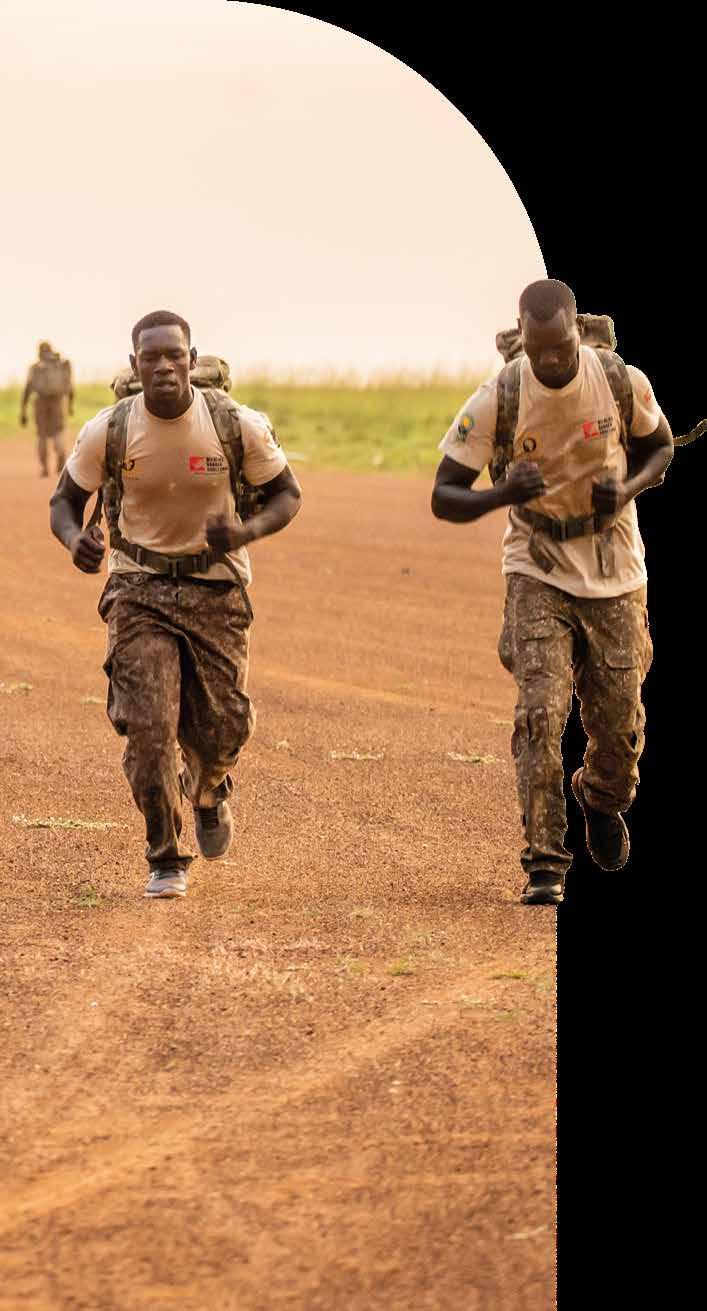
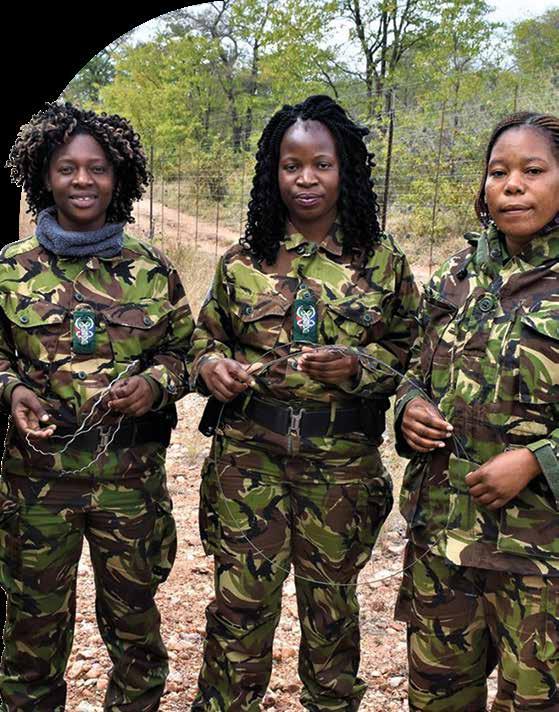
Wildlife rangers play a critical role in the conservation of protected and conserved areas. They are not only responsible for safeguarding nature, and cultural and historical heritage, but also play a vital role in their local communities, whether as first-responders in human-wildlife conflict situations, or helping maintain local security.
However, as it stands, the proposed increases in coverage of protected and conserved areas to 30% of the planet by 2030, would require an increase of around 2,000% in the number of rangers employed in Africa, if the IUCN’s guideline of ranger coverage by area were to be followed1
A more effective way of increasing the efficiency of the management of protected and conserved areas is to boost the support provided to ranger teams and to catalyse the development of the ranger profession as a whole. This can only happen with increased recognition of the fundamental contribution rangers make to conservation.

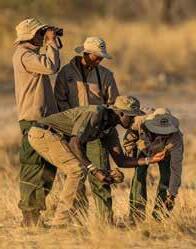
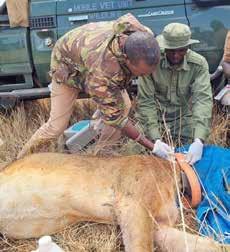
Rangers often operate under poor and dangerous working environments with inadequate employment conditions. Threats, violence, injury, disease and death are not uncommon, as reflected in the annual Roll of Honour data, released by the International Ranger Federation. The average ranger works almost 90 hours a week under extremely tough conditions: while on patrol, over 40% of rangers have no access to shelter at night, and over 60% of rangers have no access to clean drinking water. On top of this, over 40% of rangers have received threats from community members and 14% have even experienced physical violence2
The Wildlife Ranger Challenge helps to highlight the immense challenges the rangers continue to face, and the incredible diversity of their work, while raising funds to help them continue safeguarding Africa’s biodiversity. With over £15m ($18m) now raised and distributed to date, the initiative has helped Africa’s ranger workforce by widening access to essential equipment, enhanced training and protective measures.
The Wildlife Ranger Challenge is made possible thanks to founding donor, the Scheinberg Relief Fund, who generously committed a further $1 million in matched funds in support of rangers last year. We are also grateful to EJF Philanthropies, Disney Conservation Fund and the San Diego Zoo Wildlife Alliance for their sponsorship of the 2023 event.
1 UN Convention on Biological Diversity (CBD), first draft of a new global biodiversity framework
2 Life on the Frontline 2019: A Global Survey of the Working Conditions of Rangers, WWF
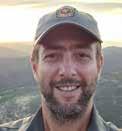
Andrew Campbell, Chief Executive Officer, Game Rangers Association of Africa
Every day more than 60,000 people help protect and conserve Africa’s vast land and seascapes in over 8,000 formally recognised conservation areas for the benefit of wildlife and people.
They come from different countries, regions, ethnic groups and communities. They speak different languages, wear different uniforms and undertake different tasks. They face different conservation challenges across a variety of different terrains and weather conditions. But they are all rangers and the guardians of our natural world.
The work of Africa’s rangers is as diverse as its people and wildlife. In our ranger community we have rangers that monitor gorillas in the humid jungles of Central Africa, rangers who help reduce human-wildlife conflicts in the communal lands of East Africa, and rangers who survey turtle nesting sites on the island beaches of Mozambique.
Each year the Wildlife Ranger Challenge presents a unique opportunity to focus this diverse group of people on a shared challenge where the playing field is truly levelled. It is an opportunity to work towards a common goal, build team morale and improve health and fitness across the ranger sector.

Left
Andrew Campbell and team having completed the Wildlife Ranger Challenge 2023 at the Southern African Wildlife College
Credit: Stew Nolan
Right
Wildlife ranger teams from across Africa compete in the Wildlife Ranger Challenge 2023
Initiatives like the Wildlife Ranger Challenge are important to foster a sense of camaraderie and togetherness amongst rangers who often work in isolated areas. Rangers get to share their experiences during the build-up to race day. They realise very quickly that they are not alone as they see hundreds of their ranger colleagues undertaking the same physical and mental challenges week after week. They get to see the different faces, hear the different languages and learn about the different environments their colleagues protect. They get to measure themselves against rangers from across the continent and are exposed to the incredible diversity of the ranger community. The impact that this has on motivation levels is tangible when we see the encouragement ranger teams give each other as race day approaches.
In 2023 we introduced the concept of regional events whereby rangers from surrounding conservation areas would undertake the Wildlife Ranger Challenge together. We had successful events hosted in Kafue National Park (Zambia), Lewa Wildlife Conservancy (Kenya), Murchison Falls National Park (Uganda) and at the Southern African Wildlife College (South Africa). Watching these teams complete the challenge together was truly inspiring, and plans are afoot to grow the number of regional events in 2024. Bonds were forged amongst competing teams which opens opportunities for collaboration, information exchange and better communication between these conservation areas. Rangers had the opportunity to run alongside their colleagues, to compete against them and to cheer them to the finish line. They ran together, sweated together, laughed together and finished together.
Initiatives like the Wildlife Ranger Challenge are important to foster a sense of camaraderie and togetherness amongst rangers who often work in isolated areas.
The life of a ranger can be lonely at times, but we believe rangers are stronger and better together. Ranger networks that extend beyond park boundaries are essential if we are to build a more effective ranger community to protect 30% of the planet by 2030. The Wildlife Ranger Challenge has become a unifying force that helps to maintain morale, strengthen resolve and build networks amongst our ranger community. We look forward to it going from strength to strength in 2024 and beyond.
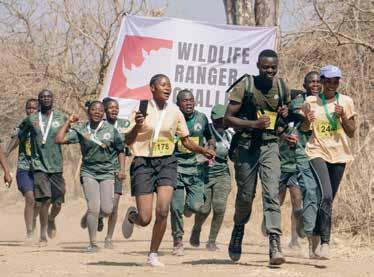
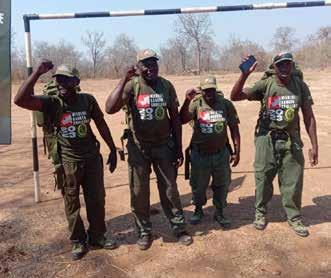
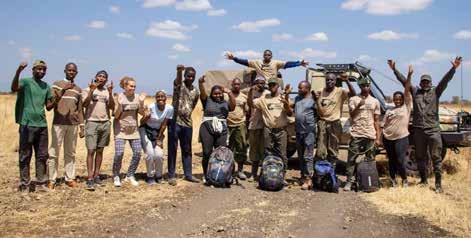



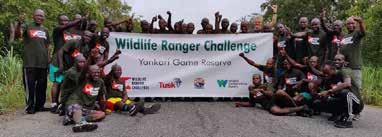
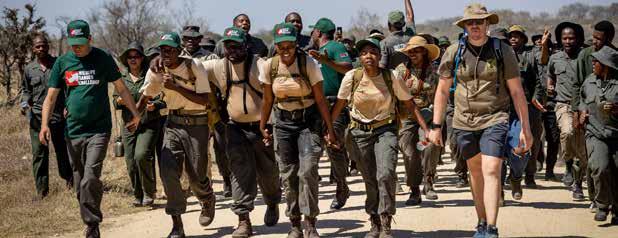
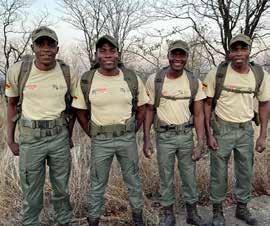


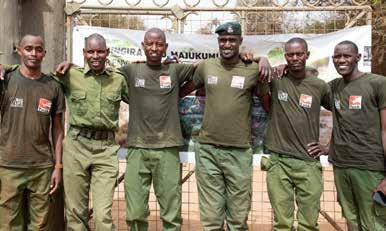


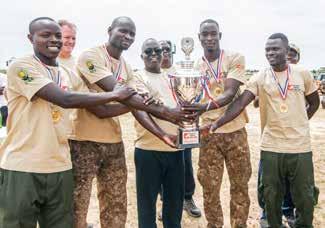
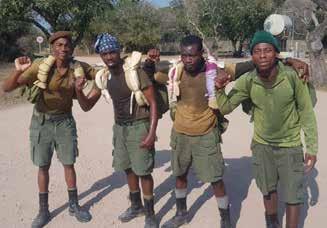
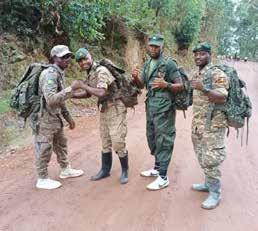
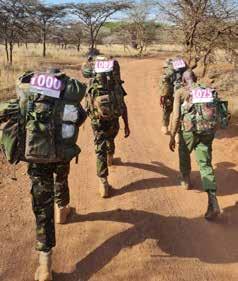
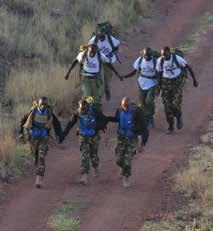

Wildlife Ranger Challenge 2023
Across Africa, dogs are increasingly becoming invaluable partners to wildlife rangers, with a multitude of different breeds supporting anti-poaching efforts. With their keen sense of smell, canine conservation heroes are game changers in tracking human poaching suspects, locating snares, and finding wounded wildlife.
The Wildife Ranger Challenge 2023 included a special canine challenge for protected areas with dog units, in partnership with Working Dogs for Conservation (WD4C). Here, two of Tusk’s project partners outline the considerable impact their very different K9 Units have secured.
When we consider conservation efforts aimed at combating the illegal wildlife trade, we often think of scientists and researchers studying the drivers and impacts, or wildlife rangers bravely patrolling the frontline to protect biodiversity. However, there is another group of heroes who also play a crucial role in this fight: canines. These animals have demonstrated their invaluable contribution to anti-poaching efforts across Zambia’s South Luangwa Valley.
A decade ago, Conservation South Luangwa (CSL) established Zambia’s first K9 Unit in partnership with Zambia’s Department of National Parks and Wildlife (DNPW). This specialised team, which currently consists of six dogs and eight handlers, is dedicated to detecting illegal wildlife products and tracking wildlife crime suspects. In recent years, the K9 Unit has proven to be one of CSL’s most efficient and cost-effective assets in the fight against wildlife crime. In 2023 alone, the K9 Unit was responsible for 24% of suspects arrested, 29% of firearms confiscated and 59% of bushmeat seized, yet accounted for just 7% of CSL’s expenditure.
CSL’s long-standing partner, Working Dogs for Conservation (WD4C) in the USA, provides CSL with working dog breeds such as labradors and shepherds. These dogs are typically rescued from shelters or surrendered by owners unable to cope with their high energy levels; a trait which can make a highly effective working dog.
Above

Conservation South Luangwa’s handler Sydney Njobvu and Gene
Credit: Marcus Westberg
Above right
Conservation South Luangwa’ Collins Lifumbo and Ody at a check point
Credit: Rachel Rebibo
Southern African Wildlife College’s beagles in action
With their incredible sense of smell, the dogs undergo rigorous training to identify firearms and bushmeat as well as ivory, animal skins, live animals, pangolin scales, ammunition and illegally trafficked timber such as mukula. Thousands of operations have been deployed across Zambia’s Eastern Province, from the Game Management Areas to the east of the South Luangwa National Park, across to Chipata and the Zambia-Malawi-Mozambique border. Through vehicle searches, property searches and targeted operations in conjunction with CSL’s aerial and ground patrol units, the K9 Unit make major seizures and arrests each year. Not only do dogs increase efficiency and detect hard-to-find wildlife contraband, but their presence also provides an effective deterrent to traffickers and helps raise awareness in the community about the illegal wildlife trade.
The relationship between CSL’s dogs and handlers is one of the most important factors in the K9 Unit’s success. Trust, respect and affection are paramount.
Credit Sean Viljoen
Malinois at SAWC
Credit Harisson Cooney
During downtime, handlers play ball games with the dogs, provide nutritious food, and often share sleeping quarters with the dogs in their kennels. The dogs are also cared for by CSL’s full-time veterinarian, Dr Sichande. In an area where dogs are at serious risk of trypanosomiasis (a deadly disease spread by tsetse flies), the dogs undergo twice-daily temperature checks and are continually monitored for other symptoms.
The illegal wildlife trade is a major threat to many species in South Luangwa. However, with the help of these extraordinary dogs, CSL and DNPW can intercept trafficked wildlife products before they reach the black market. These dogs are essential allies in the fight against poaching and will continue to play a vital role in the protection of wildlife in Zambia long into the future.


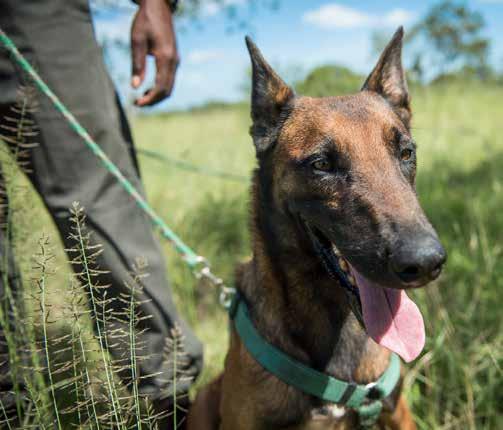
Akey aspect emphasised in a jointly published document through Project FIRE (Framework of Interventions for effective Rhino protection and Evaluation) is the critical role of canines in anti-poaching efforts.
Recognising this, the idea of setting up a K9 unit at the Southern African Wildlife College (SAWC) was already mooted in 2015. The full scope of the K9 project was to train handlers (rangers) and dogs in disciplines considered to meet the needs of current and future antipoaching initiatives within the Kruger National Park and the Associated Private Nature Reserves (APNR) on the park’s western border, and ultimately throughout the SADC (Southern African Development Community) region.
As part of its approach, the College adopted an innovative four-tiered approach to curb rhino poaching and inform best practices. Apart from a canine capacity, this holistic approach includes well-trained and dedicated rangers (boots on the ground), community engagement, and an aerial support unit.
While on-leash tracker dogs are commonly used, counter poaching pack dogs that run off leash were a relatively new concept. They can track at much higher speeds than a human can, and over even the most difficult terrain. Using aerial support to follow the dogs allows the rangers to catch up valuable time in the field.
The SAWC’s K9 Unit uses a variety of breeds for on-lead work based on their sense of smell including Malinois, beagles and shepherd breeds. More recently, the College has been testing Dobermann-bloodhound crosses given the strength of the Dobermann and the olfactory capability of the bloodhound.
A variety of hunting dogs are used for free tracking, including bluetick, black and tan and redbone breeds, which excel in human tracking. These responsive, energetic and agile dogs, who have the necessary stamina, are particularly efficient during pursuit operations, aided by helicopter monitoring to ensure their safety. Selecting and breeding dogs that are predictable and can effectively work in a pack primarily depends on genetics.
The SAWC K9 Unit Dog Master’s minimalist training approach focuses on allowing dogs to rely on their natural instincts and problem-solving abilities, fostering a conducive environment for learning and growth. Dogs learn best through self-discovery, with failure viewed as a learning opportunity guiding adjustments in training methods.
Ensuring the health and fitness of the canine companions is crucial, with proper nutrition comprising high protein Orijin dog food, regular exercise, and ongoing training to keep them physically and mentally sharp. The SAWC’s kennels prioritise safety, comfort, and optimal climate control to maintain their wellbeing.
The symbiotic relationship between humans and dogs in conservation work is paramount. Additionally, broader considerations in working with dogs include adjusting to environmental conditions and understanding when human intervention is necessary.
As the demand for well-trained dogs and handlers has grown, the College, as a SADC training institute, is playing a major role in training and replicating the K9 Unit’s successes in wildlife areas throughout Africa.
The Wildlife Ranger Challenge also serves as a platform to showcase the vital work of canine units in conservation efforts, emphasising their effectiveness alongside modern technology and human expertise. Continued support for their work is essential for strengthening conservation and counter-poaching efforts.
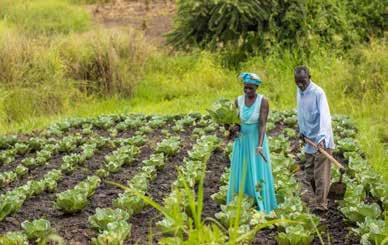
In January 2020, Tusk and Ripple Effect launched the Living with Wildlife appeal to help people and wildlife live side by side in and around Murchison Falls National Park, Uganda.
Thanks to the generosity of Tusk and Ripple Effect’s supporters, including a generous grant from the Dulverton Trust, the appeal significantly exceeded its original fundraising target: £1.3million was raised overall, and this was generously matched by the UK government.
Through the partnership with Ripple Effect and Tusk’s partner the Uganda Conservation Foundation, the Living with Wildlife project ensured that 37,300 people now have improved food security and increased livelihood opportunities. The project has also been key in fostering greater engagement and understanding between the communities and the park authorities and rangers, towards a much brighter outlook for all.

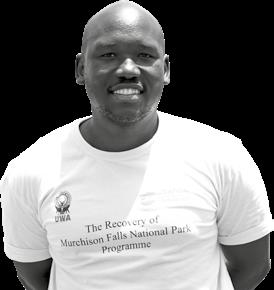
Derek has spent the past seven years specialising in protected area management with the aim of integrating park management, wildlife conservation and community engagement programmes to stimulate regional economic development. Here he describes his experiences in managing the Living with Wildlife Project, and how it has helped Murchison Falls National Park.
Murchison Falls is Uganda’s oldest and largest protected area. In the 1960s it was one of Africa’s most visited parks, with over 60,000 visitors annually. But following years of political instability, widescale poaching, and little to no investment in wildlife and habitat protection, wildlife populations collapsed. By the turn of the century, elephant numbers were down to less than 500, from over 16,000 in the 1960s. Rhinos were completely extinct and other keystone carnivore and herbivore species had declined drastically. Stability returned to the region in the early 2000s. Recovery is now ongoing. Wildlife numbers are steadily rebounding, and habitats are better protected than they have ever been.
What are the challenges facing the National Park?
Though recovering, wildlife populations remain a fraction of what they used to be. Unfortunately, the park still faces many external pressures. Poaching by means of snaring and trapping, criminal trespass, and illegal fishing are great threats to the park’s continued recovery. In an average year, more than 300 suspects
are arrested, and 5,400 snares, traps and illegal fishing implements are collected across the park. Meanwhile, growing human settlements and increased agriculture around the park intensify human-wildlife conflict. Most of the park is not fenced, and elephants, buffaloes, and even carnivores often stray outside the boundaries. Injury, loss of life and property damage through crop-raiding are increasingly rampant. The tremendous strain on resources means the park cannot adequately respond and resolve these conflicts.
What role does UCF play in the protection of the park?
In 2012, Uganda Wildlife Authority (UWA) and the Uganda Conservation Foundation (UCF) established the Recovery of Murchison Falls National Park Programme to build the basic foundations of park management and to regain control throughout. UCF is helping develop infrastructure where it’s most needed, including 13 new ranger posts and a Law Enforcement Centre at the park headquarters. We have also cleared tracks to open previously inaccessible regions, installed a digital radio network across the whole park, and facilitated the training of over 300 rangers.
UWA now has a permanent anti-poaching presence, and the extent of the park under their management control – both on land and water – has increased from 5% to over 70%. Meanwhile, over 40 metric tonnes of wire snares have been removed from the Delta Sector, which is the most heavily targeted poaching area.
How did the Living with Wildlife project fit into that work, and why was it important?
The Living with Wildlife project proved timely and a perfect fit, as it allowed the Recovery Programme to leverage its community engagement programmes and create a foundation upon which the communities and the park could improve their relationship. The project’s novel approach of combining PACE (Pan African Conservation Education)
In an average year, more than 300 suspects are arrested, and 5,400 snares, traps and illegal fishing implements are collected across the park.
Top left Sustainable farming alongside Murchison Falls National Park
Credit Ripple Effect
Bottom left
Murchison Falls is a stronghold for Rothschild’s giraffe
Credit Nick Wilcox-Brown
Below
A 12-tonne pile of confiscated snares and traps collected within Murchison Falls over 12 months
Credit Global Conservation / Uganda Conservation Foundation
and encouraged known poachers to reform. Anecdotally, community perceptions towards UWA have significantly improved.
What was the greatest challenge you and the project faced?
Challenges facing the project were constantly evolving. At the start, the biggest challenge was the Covid-19 pandemic. Protracted national lockdowns delayed project delivery by almost 15 months and the pandemic caused a continent-wide collapse of tourism. Without tourism revenue funding most of UWA’s park operational budgets, snareremoval patrols and other law-enforcement activities were significantly impacted, and poaching increased severely. This was sustained for the duration of the project, thus negatively impacting the overarching goal of reducing illegal wildlife activity.
The Nile meanwhile flooded in early 2020 and was still over two metres above record levels by early 2021. Productive land for agriculture was unusable, and the fishing economy was disrupted. Many farmers and fishermen thus resorted to poaching. Furthermore, the rising water levels destroyed hippo habitat, forcing them into community lands, and conflict with people.
What is the greatest outcome from the Living with Wildlife project?
The project helped establish a forum for collaborative dialogue between the park and the communities, increasing positive interactions and improving community attitudes towards wildlife, the park and UWA. Though this is still a work in progress needing continued nurturing, the project can be credited with catalysing this baseline where none existed. What does the future hold for Murchison Falls National Park and its wildlife?
Despite the many external challenges (now including oil exploration), there is still a great deal of optimism for the future of the park and its wildlife. The Recovery Programme has managed to establish the basic foundations of park management, and as a result UWA’s management control has vastly expanded to cover at least 70% of the park. However, without sustained community support and collaboration towards wildlife conservation, the Recovery benefits will prove
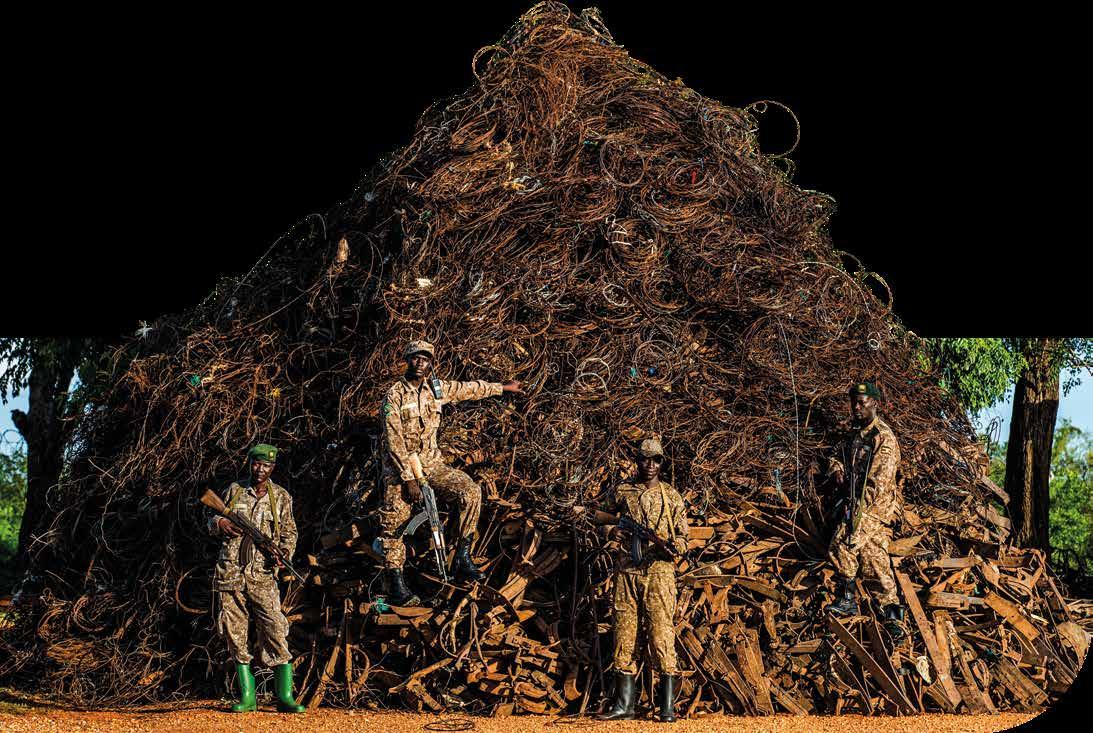

Charlie Mayhew OBE, Founder & President, Tusk Trust
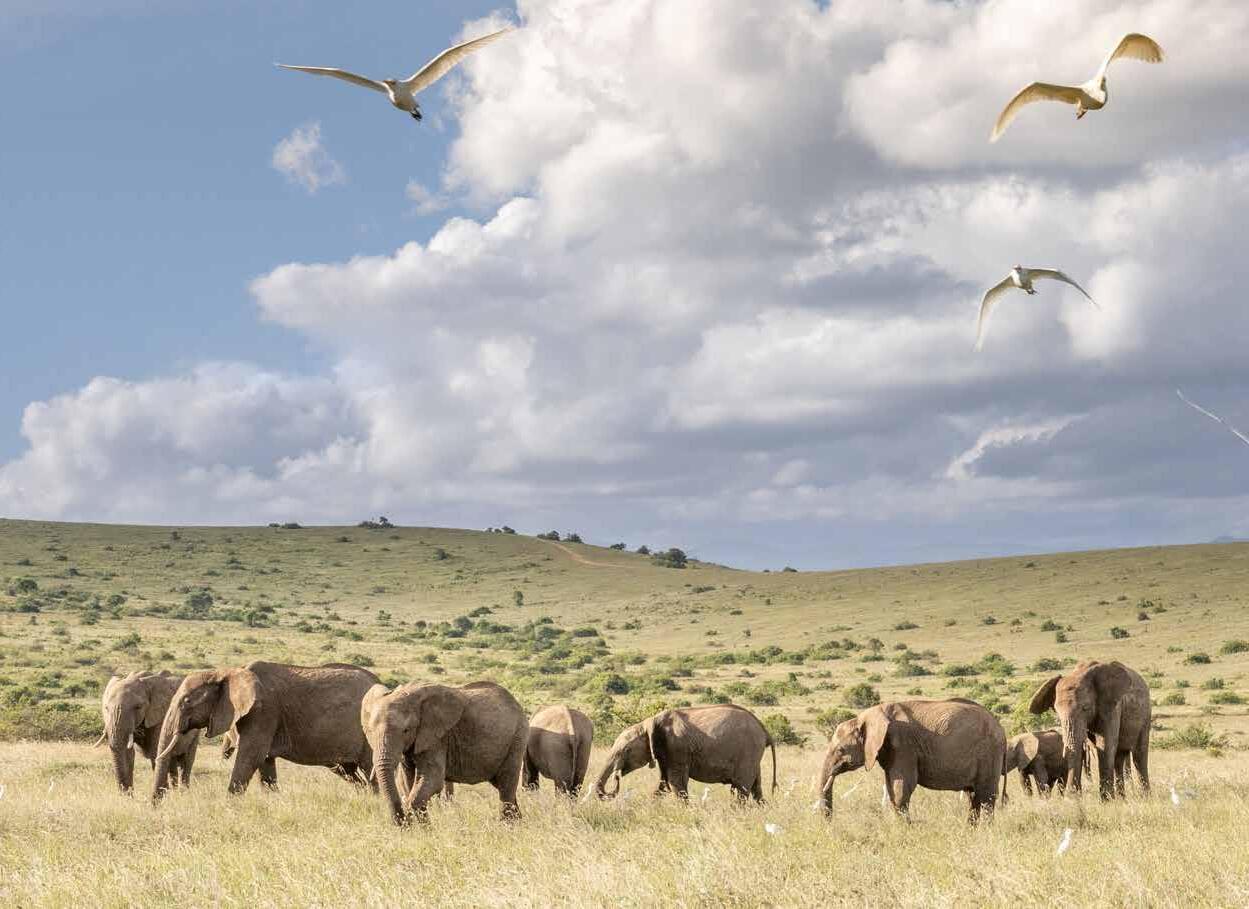
This is an exciting and significant moment in the charity’s relatively short history as Nick Bubb picks up the reins as CEO and I move into my new executive role at Tusk.
Over the past three decades, it has been a privilege working with our extraordinary team, building the portfolio of project partnerships and seeing the collective impact of our investment across Africa. I am proud that together we have raised over £130million for a broad spectrum of inspiring initiatives, championing the very best conservationists and acting as a catalyst to accelerate new ideas and stimulate collaboration across the sector.
Back in 1990, it was common to view wildlife conservation somewhat in isolation from the environment – indeed the climate debate had barely started. At that time Africa faced the unprecedented slaughter of its elephant and rhino populations, stimulated by greed and the burgeoning illegal wildlife trade. Conservation was dominated by a fortress mentality and the concept of ‘community conservation’ was just in its infancy.
From the outset Tusk understood that conservation is about people – it’s why so much of our attention and investment has been directed at community-based programmes.
As early as 1993, we funded the development of one the first community-led ‘reserves’ in the Mavuradonha Wilderness in Zimbabwe. This was quickly followed by a commitment and investment in the roll out of community
Protection of the natural world has never been more important. In less than 50 years we have lost nearly 70% of the planet’s mammals, birds, fish and reptiles, whilst our own human population has tripled.
Main image
A herd of elephants in Borana, Kenya
Credit: James Lewin
Right insert
Borana Conservancy education programme
Right Honeyguide Foundation workshop
Credit: Mauro Scattolini
conservancies in Kenya in partnership with the Lewa Wildlife Conservancy and the Northern Rangeland Trust (NRT).
It has been remarkable to watch the transition in thinking over the past three decades from the old fortress approach to where we are today, and the broad acceptance that the success of conservation is so dependent on the relationship between people and wildlife.
Perhaps the best examples of this have been the success of community-led conservancies in Namibia, which Tusk proudly supports. We are currently backing the People’s Park initiative to further strengthen the community’s rights over their land.
Meanwhile in Kenya, it has been exciting to witness NRT evolve over 20 years into an association of 45 community conservancies, which collectively protect 15 million acres of valuable wildlife habitat, whilst also employing more than 1,300 people and supporting thousands of livelihoods.
In spite of these successes, the rapidly increasing human footprint is placing unsustainable pressure on Africa’s fragile natural world. And current geo-political events and conflicts are impacting global economies and distracting the world from the efforts needed to halt biodiversity loss and mitigate climate change on a continent that is likely to be worst affected.
Protection of the natural world has never been more important. In less than 50 years we have lost nearly 70% of the planet’s mammals, birds, fish and reptiles, whilst our own human population has tripled. And with more than 50% of the human population now urbanised, we are becoming increasingly disconnected from the natural world.
Why does this matter? The answer is that all life on Earth depends on nature, and Africa is host to 25% of all remaining global biodiversity, including some of our most charismatic and endangered species. Furthermore, nature needs this megafauna to maintain healthy, balanced and functioning ecosystems. It is within this context that Tusk now operates. However, I remain an optimist having witnessed first-hand the scale and positive impact of our investment and our donors’ generosity. Indeed, having attended the Tusk Conservation Symposium in March (see pages 15-26), I am as inspired and encouraged as ever by the energy, commitment, and spirit of collaboration that is consistently shown by our amazing project partners, whom we like to refer to as ‘the Tusk family’. There is absolutely no room for complacency: we know there is so much more to be done, so many more communities that could benefit from conservation, and so many more wild habitats, forests and marine areas that must be protected.
So, as we seek to ambitiously grow Tusk’s revenue and further build the organisation to meet these evergrowing challenges, Nick Bubb’s arrival is a deliberate move to help us meet our 2030 targets and ensure we remain resilient and fit for purpose going forward. Nick is a skilled conservation professional and brings with him a wealth of experience in international conservation, a track record in fundraising and, importantly, a strong synergy of personal values and purpose with Tusk's vision and mission.
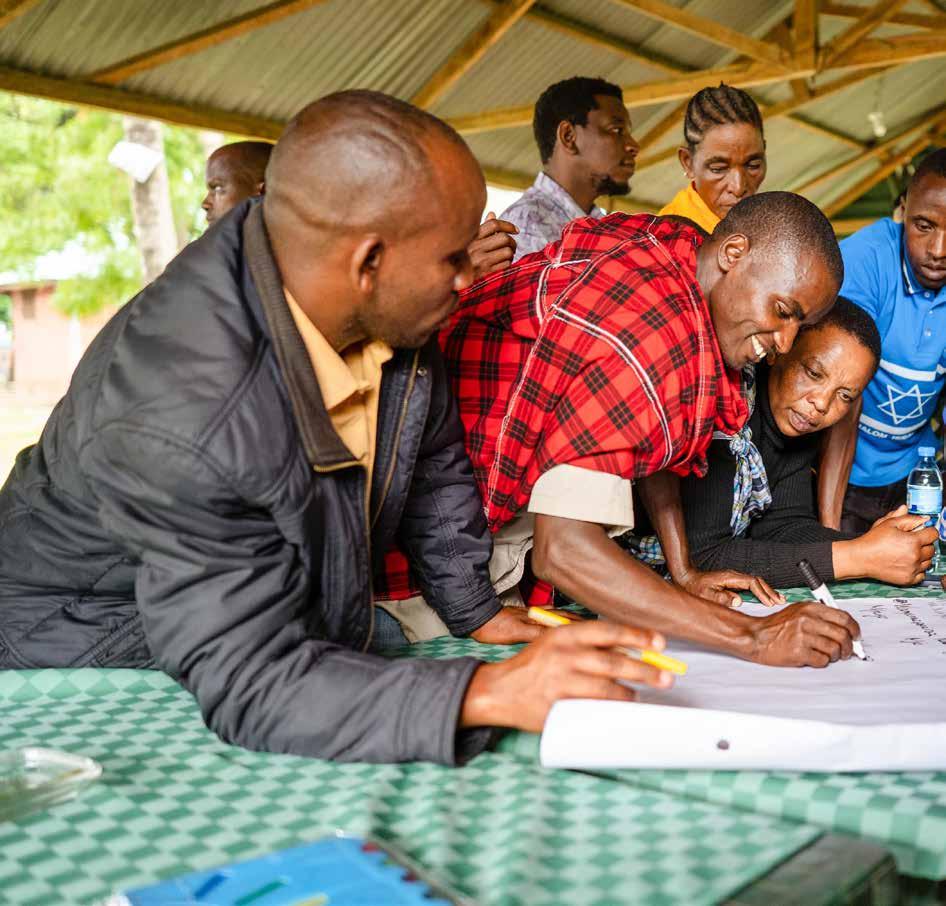

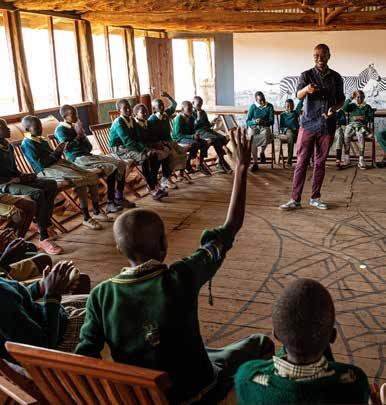
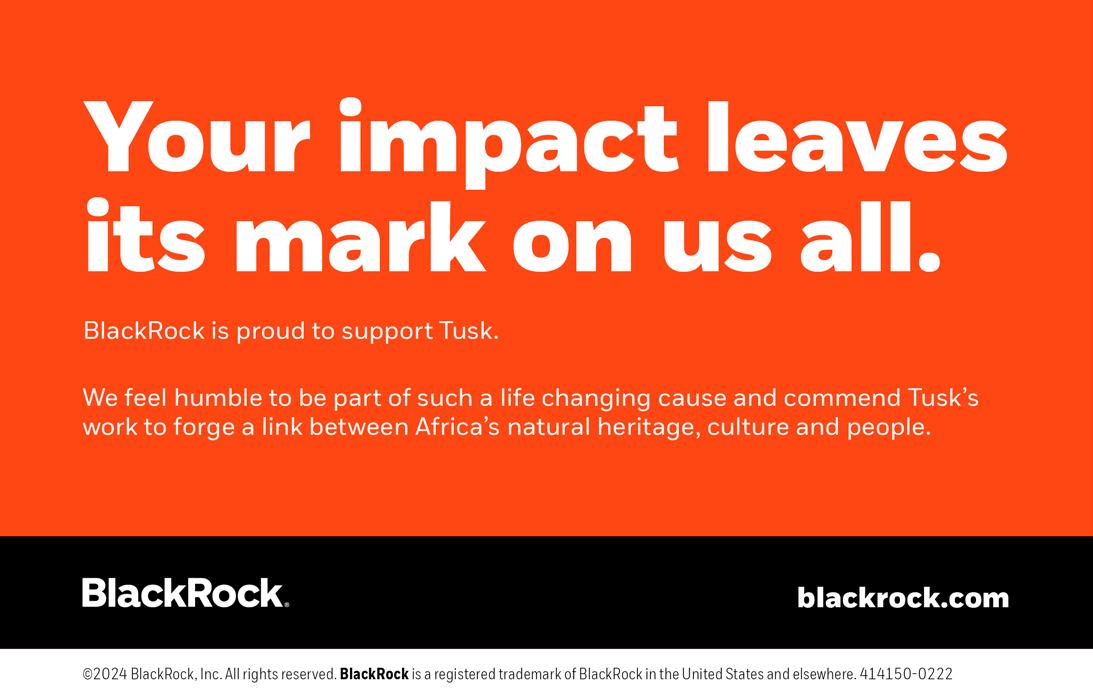
The extraordinary achievements of Africa's leading conservationists were honoured at the 2023 Tusk Conservation Awards, hosted by Tusk in London on 27th November.
Ekwoge Abwe, Fanny Minesi and Jealous Mpofu were named as the worthy award recipients. As part of their award, each has received significant grant funding to continue their vital work.
Founded with Prince William in 2013, the Tusk Conservation Awards, in partnership with Ninety One, recognise the heroes of African conservation and help tell their stories to the world. For over a decade, the Awards have served as a springboard for Africa’s foremost conservationists. These guardians of biodiversity have since risen to the top of their fields, scaling their work and amplifying conservation impact across the continent.
The ceremony, held at London’s Savoy, were hosted by natural history broadcaster and Tusk Ambassador Liz Bonnin, and attended by a host of notable Tusk supporters including Ronnie and Sally Wood, Katherine Jenkins OBE, Lawrence Dallaglio OBE, Jack Savoretti and Levison Wood. The Awards were presented to the winners by Tusk’s Royal Patron, HRH The Prince of Wales.
Below
Credit: Chris Jackson
Right top
Credit: Chris Jackson
Right middle (L-R)
Charlie Mayhew; Prince William presents an Award to Fanny Minesi; Ekwoge Abwe
Credit: Chris Jackson
THE PRINCE WILLIAM AWARD FOR CONSERVATION IN AFRICA
Supported by NinetyOne
This lifetime achievement award is given to a distinguished individual for their outstanding dedication and exceptional contribution to conservation in Africa over many years.
THE TUSK AWARD FOR CONSERVATION IN AFRICA
Supported by Defender
This award recognises an emerging leader in conservation whose work has already demonstrated an exceptional commitment and has made a significant impact to date.
THE TUSK WILDLIFE RANGER AWARD
Supported by The Nick Maughan Foundation
This award recognises the dedication and bravery of rangers working to protect Africa’s increasingly endangered wildlife.

From honouring rangers, to celebrating researchers and championing community leaders, it is evenings like this that provide the vital impetus to effect positive change.
Today’s winners now join an impressive alumni, formed of Africa’s most impactful, passionate and committed conservationists.
Fifty five inspirational individuals now make up the Awards’ alumni network. They are innovating, collaborating and leading the charge.
And they all have one thing in common…Tusk.
HRH The Prince of
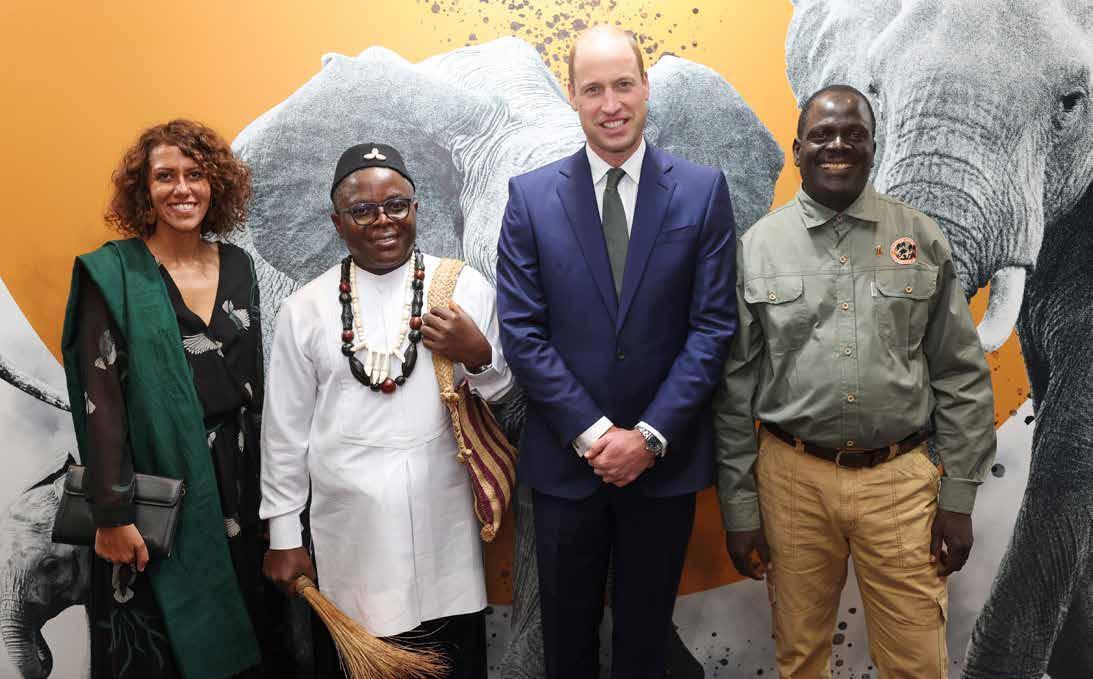



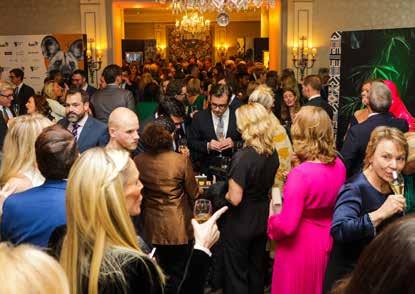

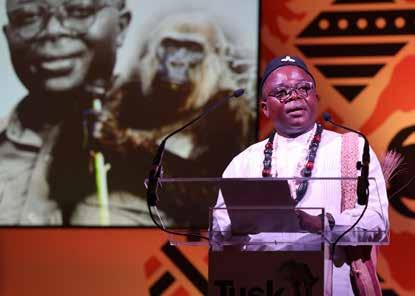


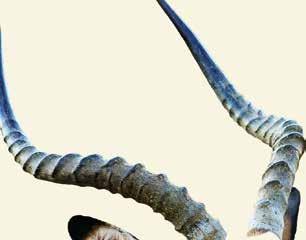


At Ninety One, we believe that by supporting conservation in Africa, we are investing for a better tomorrow. We are proud to have partnered with Tusk since 2013. Working together, we can make a difference.











Jealous has worked with Painted Dog Conservation since 1997, where as Chief Tracker he heads up the team whose daily job it is to track down and monitor five packs of painted dogs with a combined territory of more than 3,000 km2. Here he describes why painted dogs are so special.
When did you meet your first painted dog?
I joined Painted Dog Conservation in 1998 and saw my first dog in May during the denning season with my bosses Peter and Greg. We saw the pack just by the den and we stayed about one hour, 30 minutes. Then the radio collar signal went ping, ping, ping very heavily. And then I saw the alpha male, Iceboat. He was going hunting. That was my first time. I was so excited and was just laughing, because I stay right at the edge of the park but had never seen any painted dog. I used to see hyenas, lions and leopards, but not wild dogs.
How do you track dogs?
If I'm driving early in the morning, the most important thing is that I put my radio receiver on, but I’m also looking on the ground for spoor. And if I pick up the spoor, I know roughly that the dog is nearby. If there's no signal, I'll try to drive around the roads in blocks until I find the dogs, because 90% of the time they use the roads.
And when you do find them, how does it feel?
The first thing is I will be really excited, but not really smiling a lot. What I do is I first check the number of dogs in the pack, and then if I see that every member is okay, then that is when I get more excited.
We work with local communities so that we can help each other.
What’s amazing about painted dogs that people may not know?
The wild dog; they are very different beasts. You cannot compare them to hyenas, or lions. They look after each other. If they're going hunting and one dog is injured, they leave one dog behind to look after the injured one, to clean the wound and monitor for enemies – like lions or hyenas –and if they see them, they go into a hidden place. When the pack comes back, if they’ve killed something, what they do is they feed the injured one first. And then they also feed the one who was monitoring the injured dog.
They are really good animals and when they den, the alpha male and the alpha female are not the only ones who are looking after the puppies; the whole pack is. They work as a team. They go and hunt, they come back and then they feed the alpha female. If the puppies are grown up, they also feed the puppies with the lungs, the heart, and soft meat. And then if the puppies keep on begging, what they do is they give special toys. If they kill a kudu, they give the ears to the puppies so that they can keep on playing with them until they get tired.
What are you and your team doing to address human-dog conflict in your community?
Below
Painted Dog in Hwange
National Park
Credit: Nick Dyer
Below right
Jealous helping to fit a radiosatellite collar on a painted dog
Credit: Will Burrard Lucas
We know that we are weak right at the edge of the park. You need to educate people about wildlife. If you look at an animal, you are not supposed to see it as meat; you are supposed to see it can bring US dollars! We have a bush camp, and we have people who go to the communal land and teach people about wildlife. And they see what's going on there in the communal land, where there are many challenges. If they don't have a borehole, we always help, or we help the school. We work with them so that we can help each other.
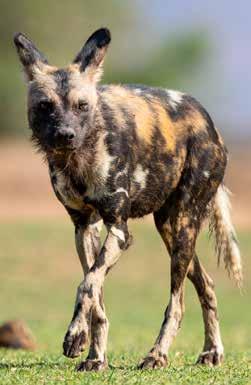
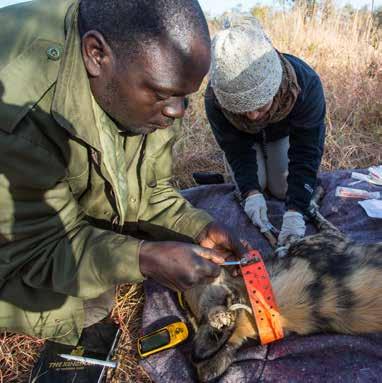


TUSK AWARD FOR WINNER CONSERVATION IN AFRICA
Adetermined advocate for nature and people, Fanny Minesi rescues endangered bonobos from poachers, gives them sanctuary, and re-wilds them in the rainforests of the Democratic Republic of Congo; the only place in the world where they are found. Here she describes just how important and unique they are.
Who inspired you to do the amazing work that you do?
My family has lived in Congo for many generations. My dad comes from there. My mum grew up in Congo. So that was my world, and my family was always involved in nature conservation. And when my mum was forty years old, while I was a young child, for the first time she crossed paths with one bonobo, and this is how the story started. She has dedicated her life to protecting these animals. She didn't know how, but she was sure of her goal. She never doubted herself. I think my mum had a lot to do with what informed my dedication to bonobos.
Why are bonobos so special?
Bonobos are not really well known. Back in the day, our country was named Zaïre and politically unstable, so it was difficult to organise research over there. For years, researchers were thinking that they were chimps, and bonobos were not known for so many decades, and yet they are so different from chimps and other great apes.
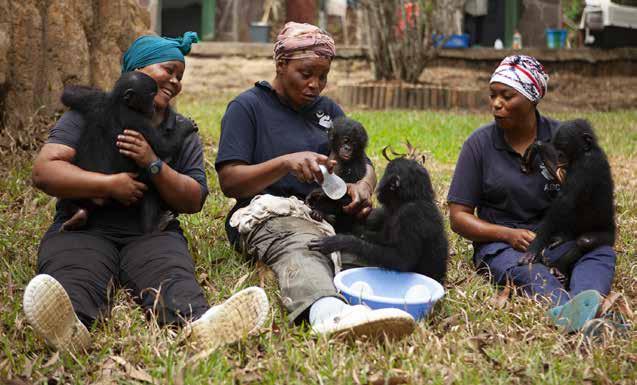
Usually when you see great apes, you see a big male surrounded by his family and all the power is concentrated on him. This is completely different from bonobo society. Bonobos are led by the females, but not by one female, who concentrates all the power. The magic is that they share the power between other females. It's matriarchal. You have your place in the hierarchy from your mum. I wouldn’t say that it’s democratic, because they don't vote, and I'm sure the males are not really, really happy about it. But it's working. It's a peaceful society. They are also very well known as hippies – they call them hippies of the forest – because bonobos have sexual contact, and you have to understand that it's like a handshake for them. They use sexual contact to reduce tension, to bond, and they don't care about gender or age. They’re also the only animals that don't kill each other. They have conflict, of course – being in a society, they have conflict – but they never solve the conflict by killing another bonobo. It's really rare.
What could human society learn from bonobos? I'm scared that bonobos might disappear, because, honestly, they should inspire how we manage our own society. I mean, they’re not territorial: we are, we fight for a piece of land, and we don’t share power.
If we continue, we're going to lose the bonobos. In three generations, the scientists say there will be no more bonobo in the world.
Above
Caring for orphaned
If we continue, we're going to lose the bonobos. In three generations, the scientists say there will be no more bonobo in the world. So, we have to do something. We have the responsibility to do something for this creature, because they are fascinating.
On our project, we are duplicating, in a way, what we have learned from the bonobos. And it's not easy, because we are not used to sharing decisions. Trying to manage this protected area, being inclusive, trying to make everybody have the right to say what seems to be good for them: this is the most challenging thing that I am doing. I think, honestly, recreating a place where everybody can speak and have the right to say, “I'm not okay with this” is difficult, even to make you say it in front of others.

This interview is based on edited excerpts from a Tusk Talks podcast. To listen to the full podcast, search Tusk Talks on Spotify, Apple Podcasts, Amazon Music, or your preferred platform.
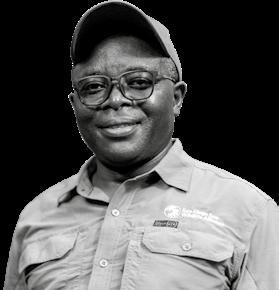
As President of the Cameroon Biodiversity Association and Co-leader of San Diego Zoo Wildlife Alliance’s African Forest Conservation Hub, Ekwoge has given a lifetime’s work to securing a better future for Cameroon’s people and wildlife, from brokering alliances between warring tribes, to blocking logging plans in one of the largest intact rainforests in the country.
What was your childhood like growing up on the borders of the Bakossi Mountain National Park?
Cameroon is in Central Africa and I come from the Bakossi land, which harbours the Bakossi Mountain where I was born. Back then, the Bakossi Mountain National Park did not exist, but this whole area, including the Bakossi Mountains, is part of what we call the Gulf of Guinea rainforest, which is a unique biodiversity hotspot.
When I was born, it was all green. I used to see the environment we lived in as a sort of garden where we collected sustainably, of course. I remember back when I was born, you went into the fields in the forest and everywhere was white with edible mushrooms, which we would collect, and they’d form part of our rich diet. We’d collect wild fruits. Our main source of protein was not from fish or beef, it was from wild animals. On the farms, people put snares to stop animals that were raiding their crops, like rats and porcupines. And so, there was this connection with nature, which we really used to have. But many of these
things have been eroded today. It might be the fact that the population has grown. It might also be the fact that the natural environment has been transformed by farms and elements of climate change. A lot has changed even where I used to live. And when I go back, I have this nostalgic feeling, like I want to be reconnected again. But it's almost gone.
Can you tell us about how you merge traditional knowledge and modern science?
I always want to show people that what we consider modern science today has its roots from traditional knowledge, which in most cases, especially in Africa, is really neglected. Growing up as a kid, one of the ways we used to share knowledge from one generation to the next was through storytelling folklore. And the way we would do this was mainly in the evenings, during dark nights around the fire. Our parents and grandparents would give us tales about their expeditions in the forests, about powerful and greedy elephants, and the wittiness of the blue duiker. The local people got to know so much of what today we call the behaviour or the rare ecology of some of these species. They knew these things, for instance, people knew that chimpanzees crack nuts in the Ebo landscape where we work.
I always want to show people that what we consider modern science today has its roots from traditional knowledge, which in most cases, especially in Africa, is really neglected.
Above
Ekwoge setting a camera trap in the Ebo Forest
Credit: Anthony Ochieng
Below right Western lowland gorilla
Credit: Anthony Ochieng
But when we've come as scientists, we record these things. And in most cases, including me, we take the accolades of this. The sad thing is that the generation of people who have this wonderful knowledge is actually fading out. If we don't do things rather fast, we may actually lose these standing encyclopaedias.
What is your most memorable encounter with chimpanzees?
In 2005 I visited the western part of the forest with a team of guides. On the second day in the forest I heard this cracking sound, and I asked the guides, what is that? And one of them just told me, those are chimpanzees cracking nuts. So, we started following the sound and behold, there were these three individuals cracking nuts in trees. I could see them doing it. And I was just captivated; just overwhelmed. And a funny thing happened. One of the chimpanzees dropped a stone that almost fell on my head. Yet it was so cool. It’s a behaviour that had been limited to western chimpanzees, west of the river in Côte d'Ivoire. The behaviour had not been seen to the East. In many ways, I think Ebo is unique. It might be that this behaviour was developed just in that population.
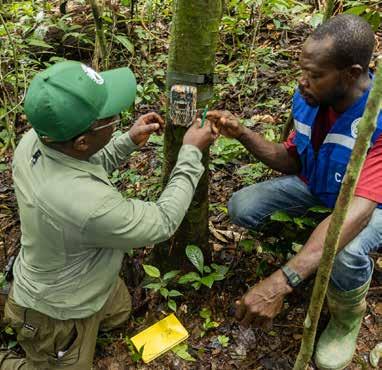
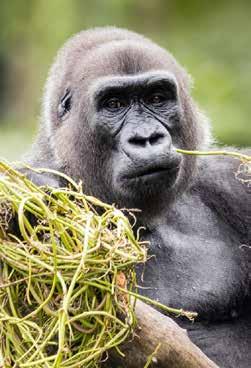

This interview is based on edited excerpts from a Tusk Talks podcast. To listen to the full podcast, search Tusk Talks on Spotify, Apple Podcasts, Amazon Music, or your preferred platform.

Liz Bonnin Presenter, Tusk Ambassador
Tusk Ambassador Liz Bonnin is a highly respected wild animal biologist and natural history broadcaster and was the host of our eleventh annual Tusk Conservation Awards. Here, Liz makes the case for the power of storytelling in conservation.
I've been making programmes about the wonders of the natural world and those striving to protect it for almost two decades now. It's been an enlightening and lifechanging experience for me to learn from the scientists, conservationists and indigenous peoples who understand implicitly why every species we share this planet with matters, and how important the natural world is for our ability to thrive. I've also witnessed first-hand how our world is changing in ways and at a speed that I never imagined I'd see in my lifetime.
As a natural history broadcaster, my job is to constantly challenge myself to find new ways to reconnect people to nature, and to help inspire a more mindful and caring custodianship of the planet. Programmes about aweinspiring animal behaviours, extraordinary conservation research projects and the environmental crises we've caused all tell different stories and strike different chords. But in the face of the immense challenges ahead when it comes to the failing health of our planet and the changes we must make as a matter of urgency, I've come to

Throughout the 34 years of Tusk's work supporting conservation in Africa we have been shown time and time again what is possible thanks to these inspirational custodians of biodiversity
learn that one of the most powerful tools we have as communicators is to share human stories – and that they must go hand in hand with documenting the natural world. Behavioural science tells us that personal stories can be incredibly powerful for creating positive change. They help others to relate to and empathise, and influence our perception of what is possible ('If they can do it, so can I!').
Every day the news headlines overwhelm us with the terrible things taking place around the world, while stories of all the good that people are also achieving are, for the most part, absent. This is a real failing, because stories of the changemakers who are finding novel ways to protect and heal the natural world and to help communities to thrive alongside it encourage others to feel empowered, so that they can change their stories too. They have helped me greatly on my own personal journey. During difficult times, when faced with the extent of the damage we've caused to the planet, I have benefitted greatly from learning from the individuals who are taking action. It's been incredibly motivating, and has provided me with much of the optimism and hope I have for the future.
At this crucial time for the planet, my ambition as a broadcaster is all the more focussed on amplifying the voices of those who know how to protect the natural world and transform the way we live – to provide them with more platforms from which to tell their own stories, from their hearts and minds, and in this way inspire others to be the change the planet needs.
I have long been an admirer of the Tusk Conservation Awards because they shine a light on so many of these individuals – the conservation leaders, stewards of nature and visionaries who demonstrate true leadership against seemingly insurmountable odds. It's been an honour to play a part in celebrating them, and I invite you to find out more about them, and talk about this remarkable group of conservation heroes with colleagues, friends and family. By sharing their stories, you are helping to continue to build on the beautiful ripple effect of change they are creating in the world.
Liz's podcast Dead River, documenting the worst environmental disaster in Brazil's history and those fighting for justice, is out now. Our Changing Planet: Restoring our Reefs, presented by Liz, is available on BBC iPlayer.
Together we can do even more to advance conservation in Africa
The Patrons’ Circle is a group of committed supporters who generously give at least £1,000/ $1,500 a year, providing essential and sustained funding for Tusk.
As a member, you will join a community of like-minded people who are passionate about Africa, wildlife and conservation, and who want to feel a greater connection to the cause.
Depending on your level of giving and how much you’d like to hear from us, the Patrons’ Circle enables members to see the impact of their generosity through a range of dedicated communications and special events, with first-hand updates from our project partners in the field.
We're passionate about African conservation and feel that supporting Tusk with a regular donation is the most effective thing we can do to protect the ecosystems and wildlife we care so much about. Being part of the Patrons' Circle allows us to see more of the impact that our support has on the ground and to meet like-minded people who share our interest.
Lauren & Joe Minchin – Patrons’ Circle Members
Every Tusk Patrons’ Circle event is so inspiring. They allow us to really see Tusk’s efforts in the local communities and to hear from the rangers, conservationists and local people who are making these amazing changes happen.
Liza Connelly – Patrons’ Circle Member
I particularly admire the charity’s emphasis on education, which I believe to be the most powerful tool at our disposal. Educating supporters and the general public is an important aspect of this and I love being a part of the Patrons’ Circle Zoom calls.
Gwen Audran – Patrons’ Circle Member
To find out more about the Patrons’ Circle, please contact Susie Coreth at susie@tusk.org
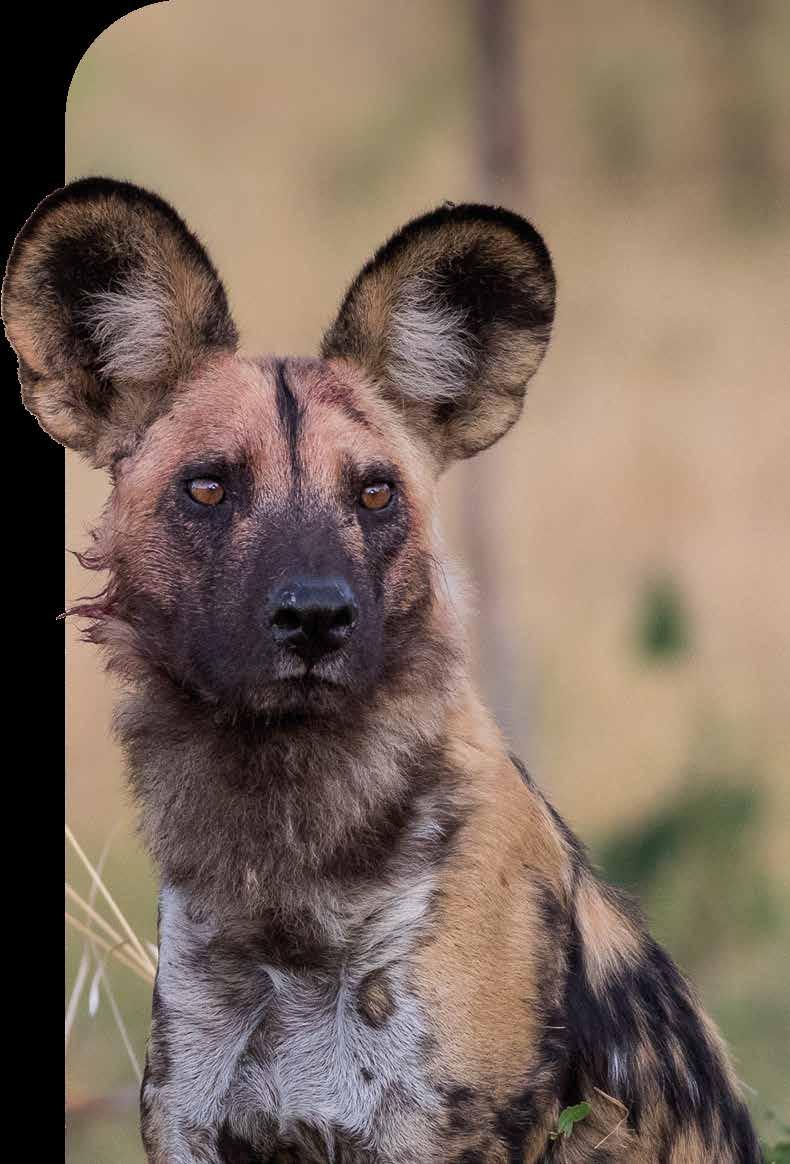
Last year, the Patrons’ Circle collectively contributed almost £1million, making a significant investment into Tusk’s project partners across Africa such as Painted Dog Conservation.

Chris Wood, Vodafone and the BlueTusk Crew
Embarking on an ocean crossing across the vast expanse of the Atlantic Ocean was not just an adventure for us: it was the ultimate test of our endurance, resilience, and the strength of our collective spirit.
When we set off from La Gomera in the Canary Islands on 13th December 2023, it was the culmination of more than two years of training and preparation for the challenge.
We were lucky to have backing from the Vodafone Foundation, who supported a team of Vodafone employees in entering the World’s Toughest Row to raise funds as part of their #YourPlanet campaign. Supporting Tusk was then an obvious choice for us and we were excited to contribute to the charity's vital conservation efforts.
Our skipper Aaron Kneebone, crewmate David Tiplady and I came together with a common goal: to give 100% in our preparation and training in order to cross the Atlantic as fast and as safely as possible, whilst making sure we savoured every moment.
From physical training to logistical arrangements, we meticulously planned every aspect of our journey to ensure our safety and success. Countless hours were spent together, training, strategising, and scenario planning for the journey ahead.
Once underway, we were at the mercy of the elements. The ocean, with its unpredictable temperament, tested us in ways no amount of training could have prepared us for. We faced 16ft waves, strong winds, blistering heat and rainstorms. We were rewarded though with some incredible sights: pods of whales and dolphins, fluorescent seas, beautiful sunrises and sunsets, and clear night skies.
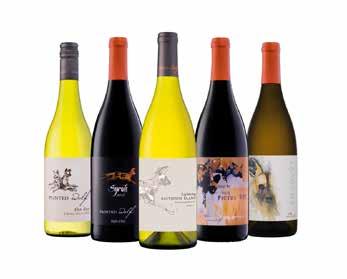

We extend our deepest thanks to our supporters, whose unwavering encouragement and generosity helped us raise funds for an incredible charity Tusk.
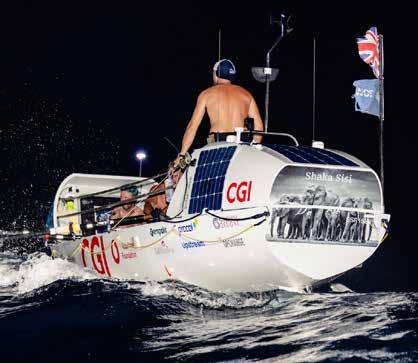
And as we arrived in Antigua on 20th January 2024, in a crossing time of 38 days, 18 hours and 29 minutes, we were crowned winners of the race’s Trio category. We had a profound sense of accomplishment, having safely completed the 3,000 miles across the Atlantic Ocean; a testament to the power of teamwork, resilience, and the human spirit. We extend our deepest thanks to our supporters, whose unwavering encouragement and generosity helped us raise funds for an incredible charity Tusk. Their support has not only helped us achieve our goal but has also made a tangible difference in the fight to protect our planet's precious wildlife. Looking back on our journey, we are filled with gratitude for the experiences shared, the lessons learned, and the friendships forged. Our journey across the Atlantic Ocean may have come to an end, but the funds raised for Tusk will have a lasting impact on wildlife and communities across Africa.
from the talkingwines co za & independent wine merchants across the UK

Make a difference with Tusk
With your help, Tusk will be able to make an even greater difference for Africa’s wildlife, natural habitats and people.
Below Participants complete the Rwenzori Mountain Challenge for Conservation, in support of Tusk
Below left and indent Bake sale for
Below right Tusk Arctic Challenge
Use the donation form at the back to send a cheque, or visit tusk.org or scan this QR code to donate online:
For American supporters wishing to donate in the most tax-efficient way you can choose to support our work through ‘The Friends of Tusk’ – a donor advised fund administered on behalf of Tusk by CAF America. Gifts made here are tax deductible in the US (CAF America Tax ID 43-1634280). Donate online at tusk.org or contact our US Development Executive, Bernadette Clemens at bernadette@tusk.org for more information on gift methods.
Tusk accepts over 100 different cryptocurrencies through The Giving Block, the most environmentally friendly crypto-donation platform on the planet.
To find out how you can make a safe and easy crypto-donation, visit tusk.org/crypto

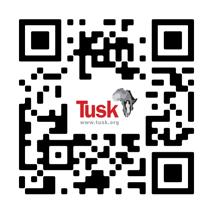
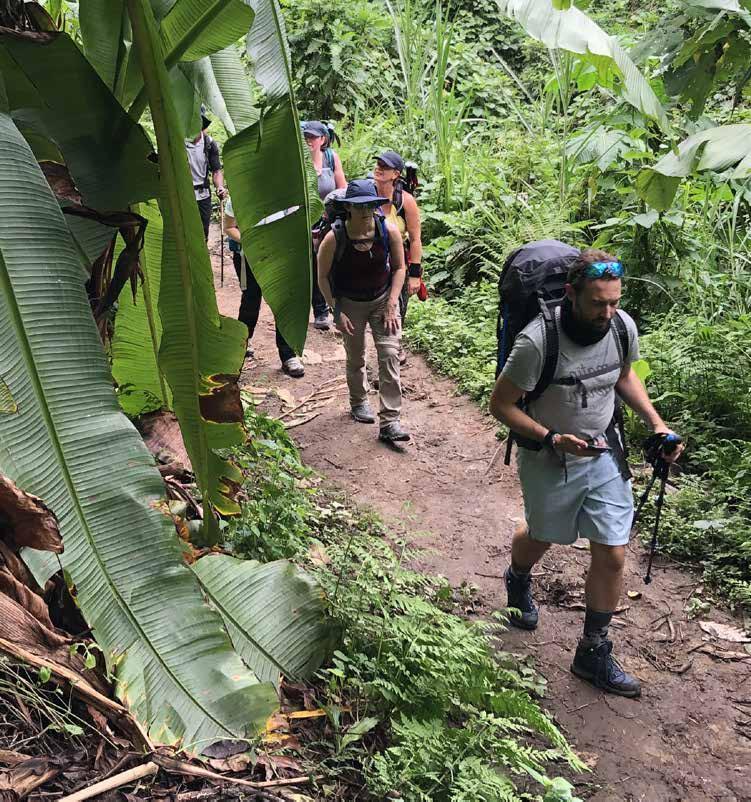







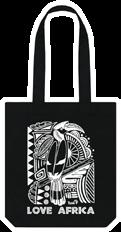
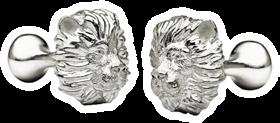

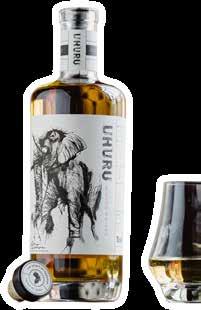
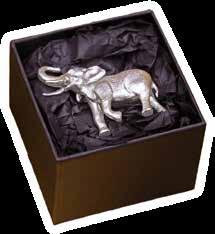
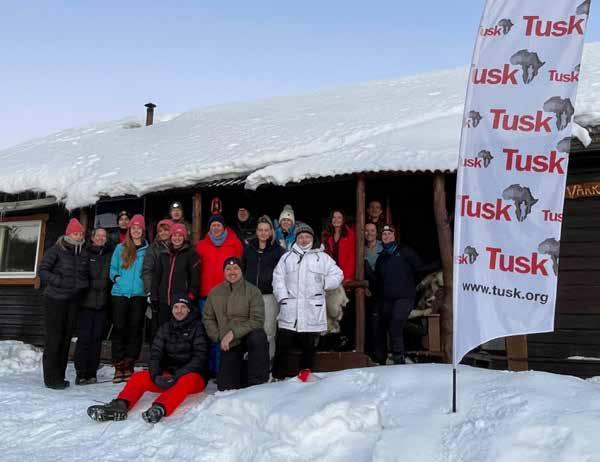
Much of our work would not be possible without the funds raised through the amazing energy and enthusiasm of our supporters. Whether taking on a challenge, creating your own event, fundraising alone, or with friends or colleagues, we’re here to support your efforts. Contact hannah@tusk.org for your fundraising pack or for more ideas and advice.
Buy something special and support our work at the same time. As well as offering a selection of Tusk items, we are pleased to offer a range of Tusk clothing through Teemill. We are also supported by many fantastic artists, designers and authors who donate a share of their profits to our work. tusk.org/shop
Many of our supporters arrange their own fundraising event, such as a bake sale, coffee morning, or a mufti day, or collect donations in lieu of birthday, wedding or anniversary presents. If you would like to help and have a fundraising idea, Tusk can provide collection tins, posters and support to help you. Contact hannah@tusk.org for your fundraising pack or for more ideas and advice.
Gifts left in Wills are particularly special to us, as we know that such a gift comes from someone who cared deeply about our cause. Unless otherwise specified, every gift we receive from a Will is invested in our endowment fund, to provide a regular and sustainable source of income for both the charity’s operations and projects. You can leave a fixed sum or a percentage – a gift of even just 1% helps us to ensure Africa's wildlife is protected for generations to come. tusk.org/wills
Check out our social media for the latest news and to help spread the word and be part of the conversation. Join our
We are extremely grateful to the following for their generous support of our work.

We are incredibly grateful to all our supporters, too numerous to mention here, whose donations have been critically important in supporting our work. We would like to thank the following for their particularly generous contributions and gifts in kind, without which, much of what we have achieved over the past year would not have been possible.
Access Bank Kenya, Accor, Advanced Handling, Alliance Bernstein, Animal Friends Insurance, Ardea Partners, Aujan Investments, B2Gold Namibia, Bank of America, Barrett & Co Solicitors, Be Military Fit, BlackRock, BMS Group, Bonhams, British Airways, Bryers, CAF America, Capture Communications, Cask Trade, Christie's, Claude Fenton, Cotswold Wildlife Park & Gardens, David Yarrow Photography, Defender, DHL Express Europe, Dire Straits, Disney Conservation Fund, Disney Theatrical Group, Drift Adventure, Ecoflix, Exceptional Travel Company, Farrant Group, Fortemus Films, Garda World, Goldman Sachs International, Grant Macdonald, C Hoare & Co, HSBC Private Bank, Huawei (Kenya), Ibid Capital, ICEA Lion, Jaguar Land Rover, Jones Family Office, Justerini & Brooks, Kensington Palace, Kenya Embassy Washington DC, Le Chameau, Lewa Wildlife Conservancy, Lioden, Longleat Safari Park, Mantis Group, Mishcon de Reya, Montford Watch Company, New York Yankees, Ninety One, On Location, Painted Wolf Wines, Patrick Mavros, Pickfords, Plantwood Communications, Prosource, Pula, Rhimani Jewellery, Reid Park Zoological Society, Royal Berkshire Shooting School, Safaricom PLC, San Diego Zoo Wildlife Alliance, Savoy Hotel, Shaftesbury Capital, Shelton Fleming, SMART Veterinary Clinic, Sothebys, Spun Gold TV, Thyme, Tribe Impact Capital, Unit X, Volcanoes Safaris, West Midland Safari & Leisure Park, Westbrook Gallery, Young Spirits, Zoological Society of East Anglia.
Charitable Trusts, Schools & Public
A & R Woolf Charitable Trust, Addo Trust, African Community & Conservation Foundation, African Leadership University, African Parks, African People & Wildlife, Airbnb Community Fund, Albert Van Den Bergh Charitable Trust, Alexander Dreymon Fan Club, Apex Foundation, Art for Charity Collective, ASAMAA Charitable Trust, Aylesford Family Charitable Trust, Bearem Charitable Trust, Bernard Sunley Charitable Foundation, Blair Trust, Born to Fly Charity, Bradley & Katherine Wickens Foundation, Brown Foundation, Cedar Hill Foundation, Charity of Stella Symons, Charles Hayward Foundation, Chestnut Trust, CHK Foundation, Corcoran Foundation, Dahan Family Foundation, Darcey Boyle Family Fund, David L Tandy Foundation, Douglas Heath Eves Charitable Trust, Edward Hoare Charitable Fund, EJF Philanthropies, Ernest Kleinwort Charitable Trust, Friedman-French Foundation, Fun to Fund, Game Rangers Association of Africa, GAT Foundation, Golden Bottle Trust, Ruth and Sheldon Goldstein Foundation, Holtzman Wildlife Foundation, International Ranger Federation, ISPS Handa, JRS Biodiversity Foundation, JSK Trust, Kajatawa Foundation, Lizandy Charitable Trust, Lyon Family Charitable Trust, Marjorie Coote Animal Charity Trust, Maliasili, Mayhew Charitable Trust, Merriman Charitable Foundation, Millard Family Foundation, Natural State, New England Biolabs Foundation, Nick Maughan Foundation, PF Fleming Charitable Trust, Perivoli Trust, Reed Foundation, Renaissance Charitable Foundation, Rhodes Charity, Ricochet Foundation, Ripple Effect, Rwandan Development Board, Scheinberg Relief Fund, Schuster Charitable Trust, Schwab Foundation, Scott (Eredine) Charitable Trust, Sisi & Savita Charitable Trust, Steel Charitable Trust, Stichting African Wild Dog Conservation Projects, Thin Green Line Foundation, Thomas Family Charitable Trust, Toby & Regina Wyles Charitable Trust, Tucker Charitable Trust, Turner Foundation, URSA, Vijay & Shama Bhardwaj Foundation, Vodafone Foundation, Wildlife Conservation Network, Worshipful Company of Cutlers.
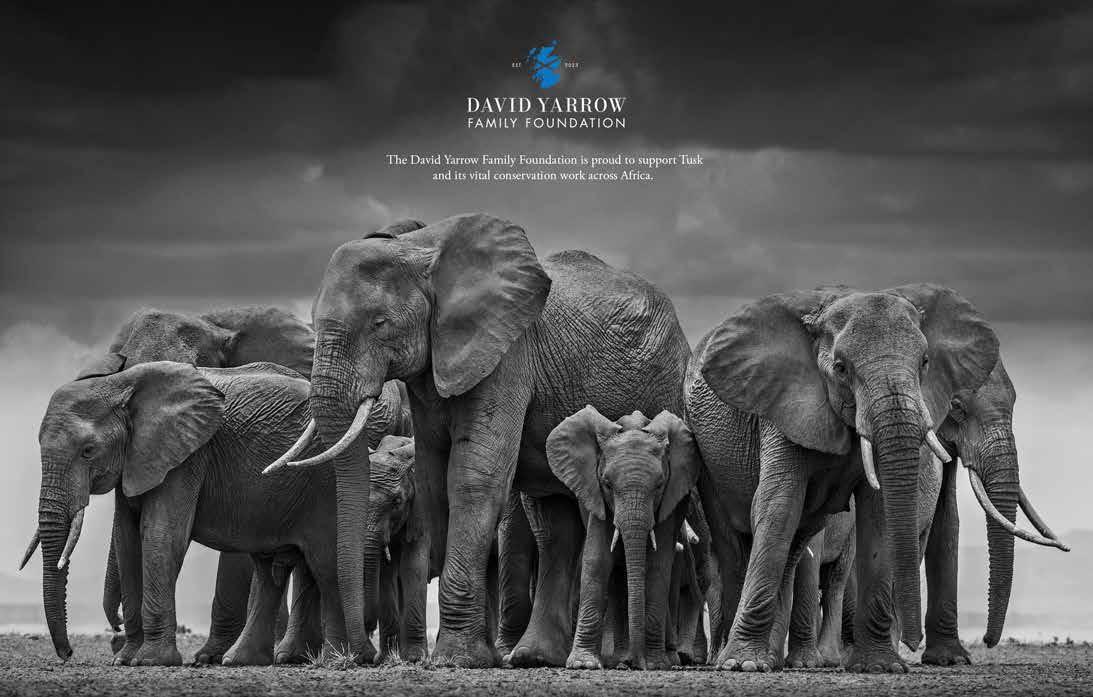

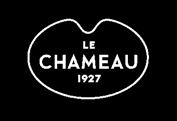
www.lechameau.com
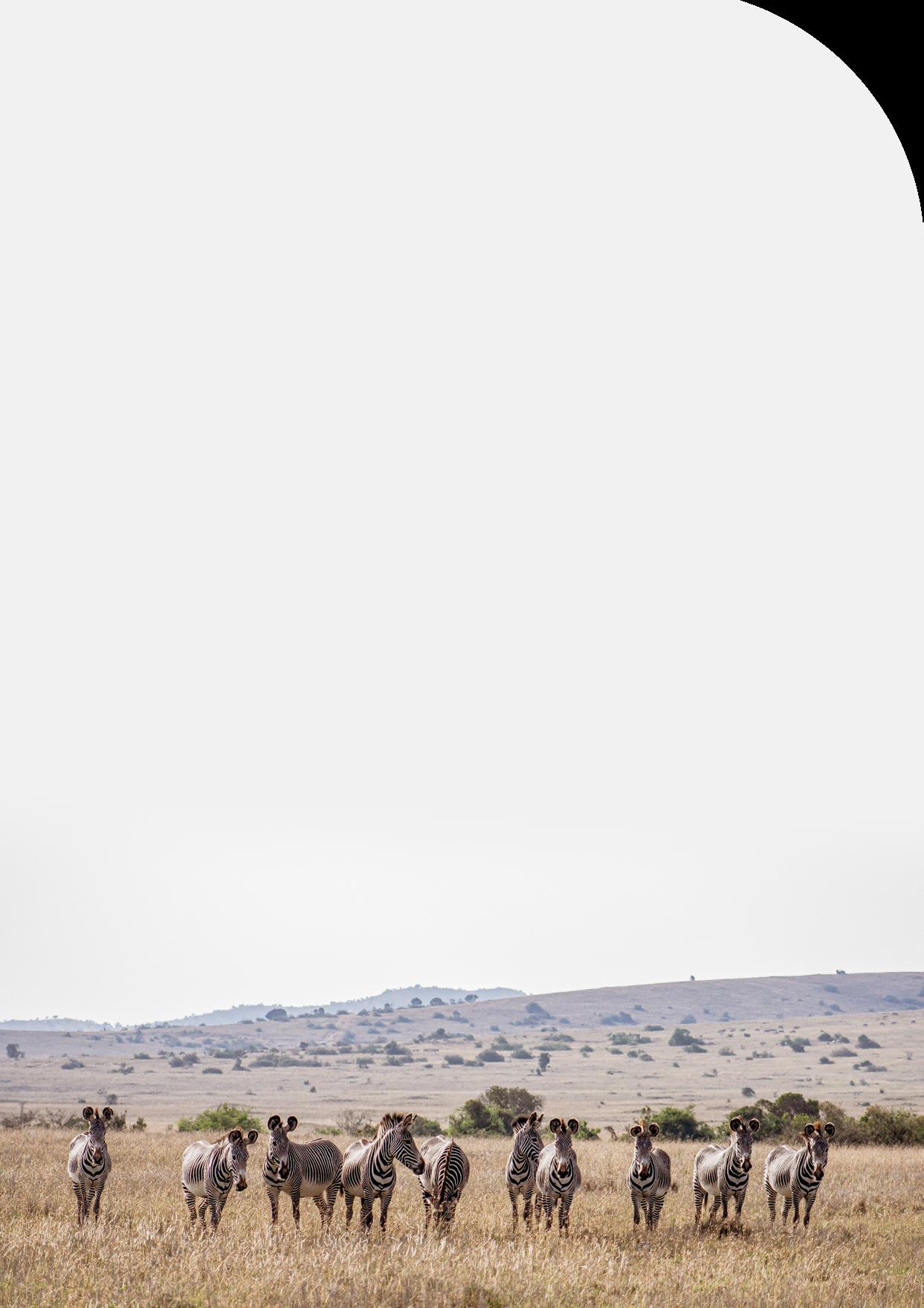
Individuals
Lord Agnew, James & Alessandra Alexandroff, Shaun Anabezi, Peter Anderson, Sue Anschutz-Rodgers, Mark Armenante & Young Sohn, Dawn Arnall, Neeta Atkar, Gwen Audran, Stephane & Rachel Audran, Ryuko Baba, Jonathan Baillie, Ian Ballard, Barnaby Barford, David Barnes, Richard & Susan Barnes, Camille Barton, Jeremy & Nikki Barton, Lord & Lady Bath, Briony Beattie, Goetz & Alida Bechtolsheimer, Malcolm Bell Macdonald, Michelle Berners-Price, Elisa Best, Gary Beyer, Jonathan Biggs & Rachel Heron, Nigel Bliss, Shane Bolton, Liz Bonnin, Iain & Jane Bratchie, Matt Breidert, Rory Bremner, Stephen Brenninkmeijer, Janet Brown, Andrew Brown, Tom Bulpitt, Giles Burke-Gaffney, Will Burrard-Lucas, Philip Buscombe, Emily Buswell, Vanessa Buxton, Rebecca Byam, Marcus Cabrera, Joe & Farrah Calder, Callum Callinan, Andrew Campbell, Mark Cameron, Tom Cartwright, Julian Cazalet, James Chapman, Gordon Cheung, Chris Churchman, John Cleese & Jen Wade, Martin Clunes, Andrew Colocotronis & Petra Schmidt, Liza Connelly & Paul Toomey Jr, Elizabeth Coplon, David Cotton, Mark Cowan, Daryl Cresswell, Robin & Jacqueline Creswell, Teresa Crook, Hunter Curtis & Mary Myles Curtis, Adam Dant, John Davidovich & Lauren Aichinger, Jennifer Delaney, Frankie Dettori, Alexander Dreymon & Allison Williams, Hendrik du Toit, Gregory Edwards, Henry Egerton, Carl Eichstaedt III, Edward & Sandy Elgar, Marc Elman, Pure Evil, Sam Excell, Sir Robert & Lady Fairbairn, Michael Farrant, Robert Fearis, Ben Fogle, Jen Ford, Will Fortescue, Mark & Marnie Franklin, James Fraser, Kindy French, Malcolm Fried, Paul & Abagail Gardiner, Jennie Garlington, Nick Gentry, Robert Gesink, Sholto Gilbertson, Mark Goddard, Max Gower, Alex Graham, Stuart & Teresa Graham, Gary & Amy Green, Andrew Greener, Bear Grylls OBE, Ravinder Gupta, George & Serena Haggas, Robert Ham, Dr Haruhisa Handa, Adam Hassan, John Hauer, Robert & Suzette Hayes, Carol Hayes, Michael Hazel, Tracy Higgins, Emily Hill, Roger Hills, Peter Hinkley, Martin Hoare, Alex & Liz Hoctor-Duncan, Anders & Anne Holch Povlsen, Lady Mary Holmes, Simon Hoyle, Roy Hughes, Phillip Ihenacho & Carine Smith, Tim & Sue Jackson, Mr Jago, Kevin James, Janet Jeffs, Katherine Jenkins OBE, Amy Johnson, Rob Jowers, Mindy Juss, Beatrice Karanja, Hayden Kays, Charles Keady, Prue Keigwin, Carol Kemm, Marina Kleinwort, Aaron Kneebone, Mark Knopfler, Julian & Susan Knott, David Korn, Chila Kumari Burman, Stephen Lansdown CBE & Margaret Lansdown, Ahmad Lari, Jan Leighton, Hamish & Venetia Leng, Michael Lewis, David Lomas, John Lonergan, Jane Longley, Lindsey Lorenz, Em Lovell, Ben Lundie, Niamh Lynch, Christy Mahon, Attif Malik, Regina Mariano, Nick Maughan, Jay Maurice, Jill May BEM, David & Ginny Mayhew, Lara Mayhew, Stuart McCracken, Deborah Meaden & Paul Farmer, Niko Michault, Ciara Middleton, Paul Milton, Lauren Minchin, Midori Miyazaki, Eddie Moir, Praveen Moman, Edward Ndiritu, Alasdair Ogilvy, Michael O'Hanlon, Robert Page, Geoffrey Page-Morris, Hamish Paton, Oliver & Emma Pawle, Pamela Pearson & Chuck Peach, John Pearson, Rupert Pelly, Charlie Perring, Mauro Perucchetti, Tristan Phipps, Sarah Picton, Jolanta Piekos, Russell Platt, Jonathan Pollack, Greg & Maureen Poschman, Nicholas Powell, Riaz Punja, Rankin, Hugh Rattray, Robert Replogle, Alexander & Katherine Rhodes, Lady Rice, Helen Jane Roberts, Brian & Jessica Robinson, Nigel Robinson, Paul Rose, Robert Rosenberg, Tim & Victoria Russell, Eavan Ryan, Ciara Ryan, Kristine Ryssdal, Jack Savoretti & Jemma Powell, Mark Scheinberg, Matt Scholey, Barbara Schubert, Brad Schwartz, John Searle, Paul Sednaoui, May Selby, Vian Sharif, Megan Shean, Hannah Shergold, Andrew & Catherine Shilston, David Simoné, Rachyeta Singh, Marco Siniscalco, Nick Southgate, Valerie Sperske, Devon Sprague, Anthony Squibb, Lord St John of Bletso, Robert & Deborah Stewart, Steven Stone, Nick & Sheila Stranks, Susan Stribling, Emily Stroud, Louise Studd, Peter & Fiona Thomas, Chris Thompson, Christopher Thompson Bt, David Tiplady, Chris Townsend OBE, Paul Tudor Jones II, Richard Turpin, Miriam Twaalfhoven, Mark Tyndall, Donald Van de Mark, Ron van der A, Frits van Vlissingen, Nick & Sophie Veronis, John Vile, Stephen Vinall, Yannick Vollbrecht, James & Nicky Vyvyan-Robinson, Lyndsey Wallbank, Abigail Waller, Lizzie Webb, Richard & Laura Webb, Christopher Webster, Chris Westbrook, Peter & Diana Whiteside, Jennifer Widener, Chris Wood, Laura Wood, Levison Wood, Ronnie & Sally Wood, David Yarrow, Jessica Zarzycki, Jade Zech, Erik Zenz.
We are extremely grateful and honoured to have received a number of gifts in Wills, which are particularly special to us and will support our work in Africa long into the future.
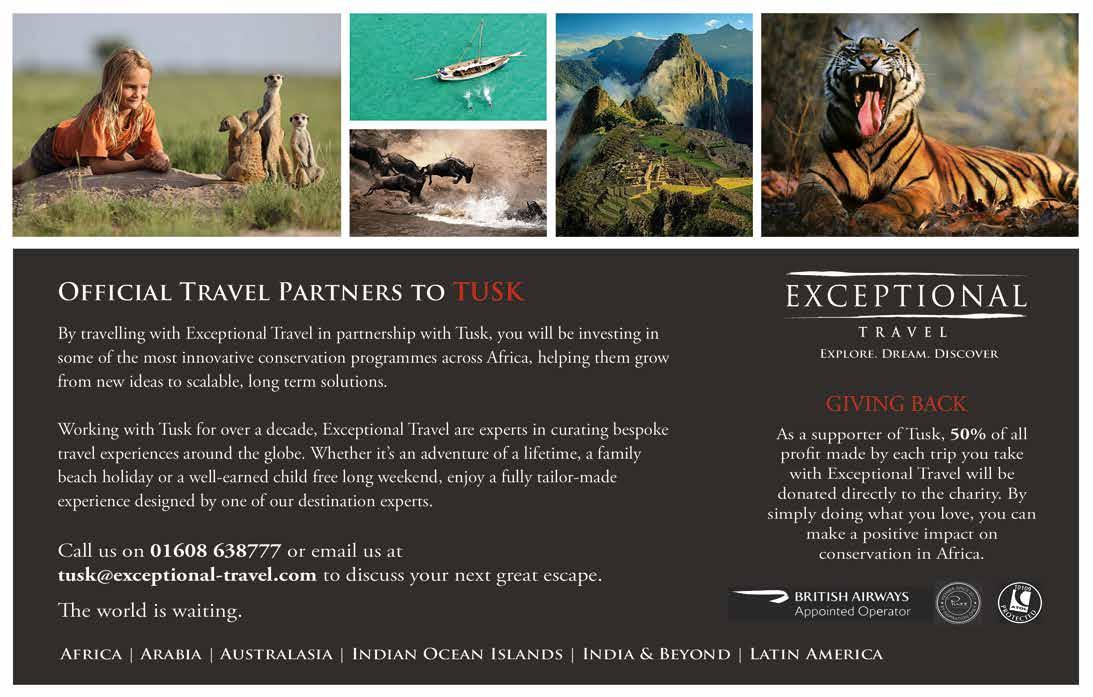
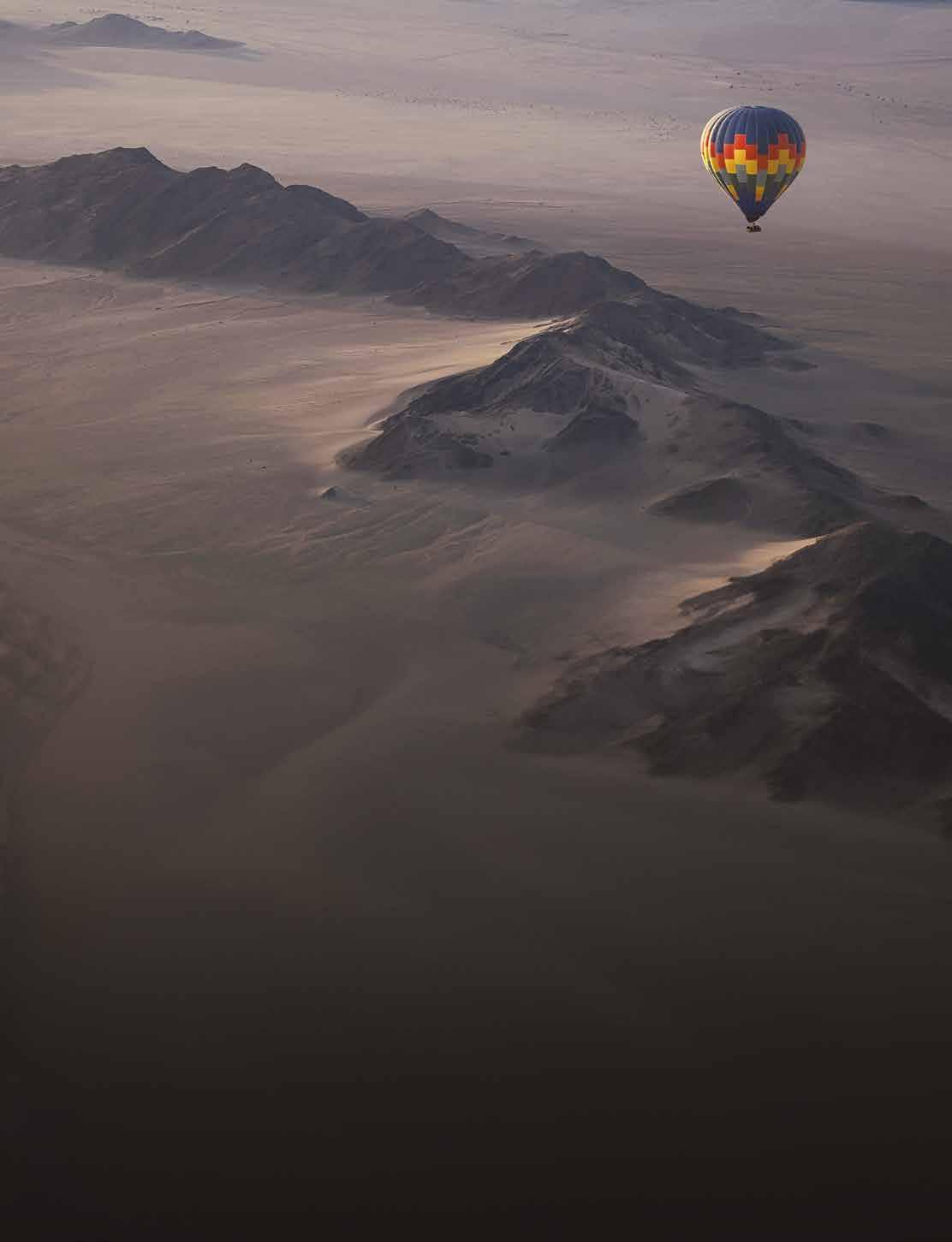
We are extremely grateful to the following for their generous support of our work.
ROYAL PATRON
HRH The Prince of Wales KG, KT
HON VICE PRESIDENTS
Sir Timothy Ackroyd Bt.
Iain Rawlinson
The Hon. Stephen Watson
TRUSTEES
Alexander Rhodes (Chairman)
Dr Susan Canney
Patrick Harverson LVO
Beatrice Karanja
Nick Maughan
Jill May BEM
Deborah Meaden
Mark Tyndall
STAFF AND ADVISORS
UK
Founder & President
Charles Mayhew OBE
Chief Executive
Nick Bubb
Chief Operating Officer
Dan Bucknell
Head of Corporate Partnerships & Events
Adele Emmett
Head of Finance
Julie Cure
Head of Philanthropy
Anna Hunt
Head of Digital
Coralie Hyde
Design & Brand Manager
Emily Higgs
Fundraising & Events Officer
Hannah Pugh
Philanthropy Officer
Susie Coreth
Finance Officer
Poppy Ellaway
Bookkeeper
Paye
Data Administrator Kate O’Farrell
Digital Fundraising Assistant
Communications & Content Assistant Robyn Brown
Media Relations Consultant Gloria Ward
PACE Coordinator
Penny Fraser Kenya
Chief Conservation Officer
Sarah Watson
Head of Conservation Partnerships
Ivy Wairimu
Africa Events and Project Assistant Winfred Nduati
Africa Events and Project Assistant Magdaline Marucha
US Development Executive
Clemens
DEVELOPMENT BOARD
Philip Buscombe
Graham Rachel Heron
Tim Jackson Oliver Pawle
Andy Pitts-Tucker
Townsend
AMBASSADORS
Zoe Ball Emma, Marchioness of Bath Liz Bonnin
Rory Bremner
Philip Cayford KC
John Cleese Dr Samantha Corsellis
Sarah Fairbairn Ben Fogle
David Gower OBE
Amy Green Bear Grylls OBE
Dr Haruhisa Handa
Reggie Heyworth
Brian Jackman
Katherine Jenkins OBE
Simon King OBE
Madeleine, Lady Kleinwort
Mark Knopfler
Dr Richard Leakey James Lindsay Ali MacGraw
Deborah Meaden Lord George Percy Tristan Phipps
Hannah Shergold
Kate Silverton
Pam St Clement Joss Stone
Sir Christopher Thompson Bt
Nick Tims
Steve Tisch
Jennifer Wade Ruby Wax Levison Wood
Ronnie Wood
David Yarrow
GENERATION TUSK COMMITTEE
Gwen Audran
Camille Barton
Tamsin Dodsworth
Katy Roxburgh
Athene St John Ellie Stoneham
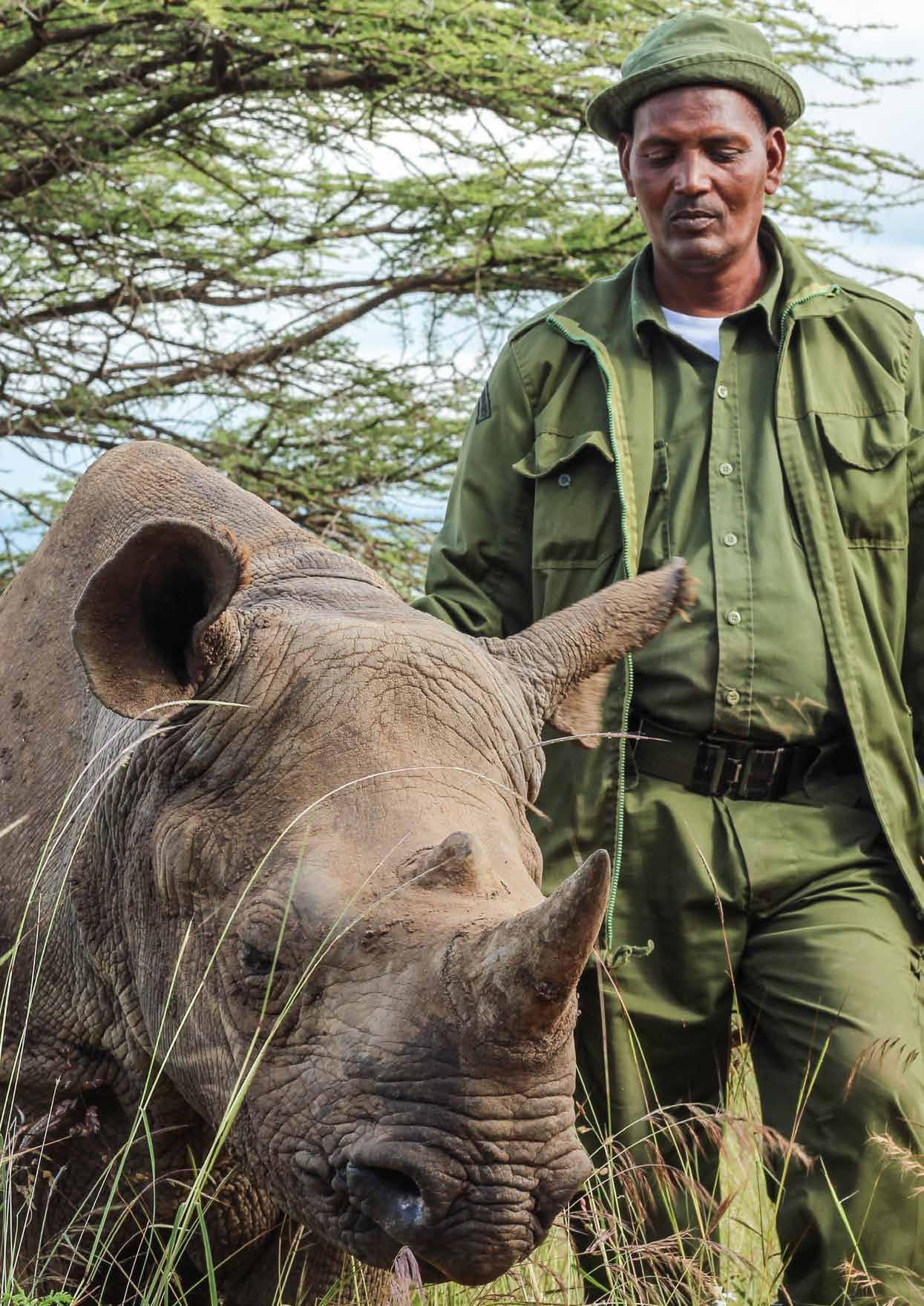

DONATE NOW

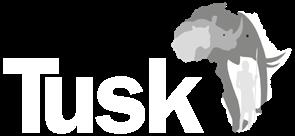
Tusk Trust
4 Cheapside House, High Street, Gillingham, Dorset SP8 4AA
T +44 (0)1747 831 005 E info@tusk.org tusk.org @tusk.org tusk_org tuskcharity
Tusk Trust Limited is a UK Registered Charity No 1186533